Visual Search and Information Processing Speed
VerifiedAdded on 2023/06/11
|46
|13333
|304
AI Summary
This chapter examines the potential impacts of nonclinical levels of anxiety, depression, subjective memory function and objective cognitive function, as well as educational level and gender, with regard to information processing speed that is related to attention in both the young and old adults through the use of commonly adopted visual search task.
Contribute Materials
Your contribution can guide someone’s learning journey. Share your
documents today.

VISUAL SEARCH AND INFORMATION PROCESSING SPEED
[Author Name(s), First M. Last, Omit Titles and Degrees]
[Institutional Affiliation(s)]
[Author Name(s), First M. Last, Omit Titles and Degrees]
[Institutional Affiliation(s)]
Secure Best Marks with AI Grader
Need help grading? Try our AI Grader for instant feedback on your assignments.
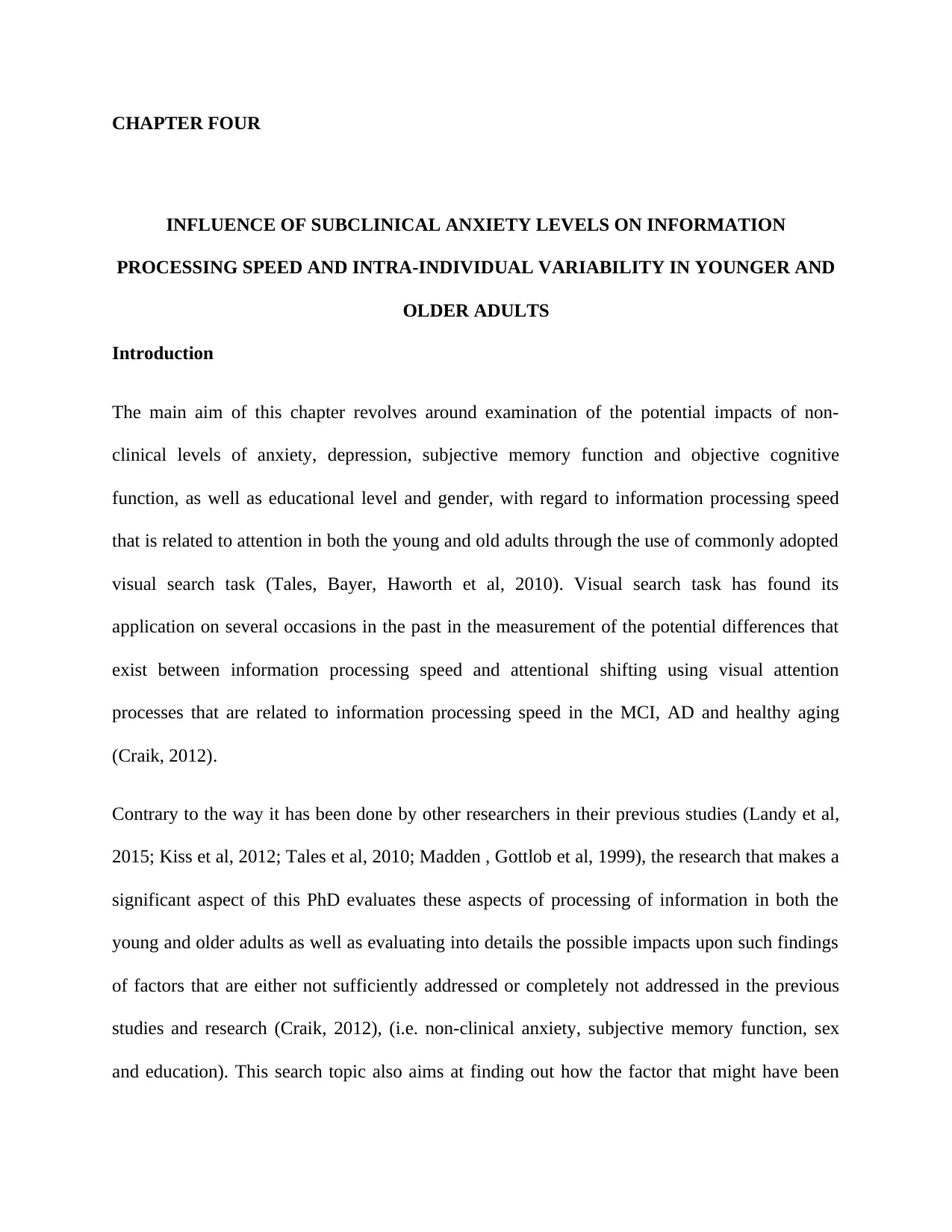
CHAPTER FOUR
INFLUENCE OF SUBCLINICAL ANXIETY LEVELS ON INFORMATION
PROCESSING SPEED AND INTRA-INDIVIDUAL VARIABILITY IN YOUNGER AND
OLDER ADULTS
Introduction
The main aim of this chapter revolves around examination of the potential impacts of non-
clinical levels of anxiety, depression, subjective memory function and objective cognitive
function, as well as educational level and gender, with regard to information processing speed
that is related to attention in both the young and old adults through the use of commonly adopted
visual search task (Tales, Bayer, Haworth et al, 2010). Visual search task has found its
application on several occasions in the past in the measurement of the potential differences that
exist between information processing speed and attentional shifting using visual attention
processes that are related to information processing speed in the MCI, AD and healthy aging
(Craik, 2012).
Contrary to the way it has been done by other researchers in their previous studies (Landy et al,
2015; Kiss et al, 2012; Tales et al, 2010; Madden , Gottlob et al, 1999), the research that makes a
significant aspect of this PhD evaluates these aspects of processing of information in both the
young and older adults as well as evaluating into details the possible impacts upon such findings
of factors that are either not sufficiently addressed or completely not addressed in the previous
studies and research (Craik, 2012), (i.e. non-clinical anxiety, subjective memory function, sex
and education). This search topic also aims at finding out how the factor that might have been
INFLUENCE OF SUBCLINICAL ANXIETY LEVELS ON INFORMATION
PROCESSING SPEED AND INTRA-INDIVIDUAL VARIABILITY IN YOUNGER AND
OLDER ADULTS
Introduction
The main aim of this chapter revolves around examination of the potential impacts of non-
clinical levels of anxiety, depression, subjective memory function and objective cognitive
function, as well as educational level and gender, with regard to information processing speed
that is related to attention in both the young and old adults through the use of commonly adopted
visual search task (Tales, Bayer, Haworth et al, 2010). Visual search task has found its
application on several occasions in the past in the measurement of the potential differences that
exist between information processing speed and attentional shifting using visual attention
processes that are related to information processing speed in the MCI, AD and healthy aging
(Craik, 2012).
Contrary to the way it has been done by other researchers in their previous studies (Landy et al,
2015; Kiss et al, 2012; Tales et al, 2010; Madden , Gottlob et al, 1999), the research that makes a
significant aspect of this PhD evaluates these aspects of processing of information in both the
young and older adults as well as evaluating into details the possible impacts upon such findings
of factors that are either not sufficiently addressed or completely not addressed in the previous
studies and research (Craik, 2012), (i.e. non-clinical anxiety, subjective memory function, sex
and education). This search topic also aims at finding out how the factor that might have been
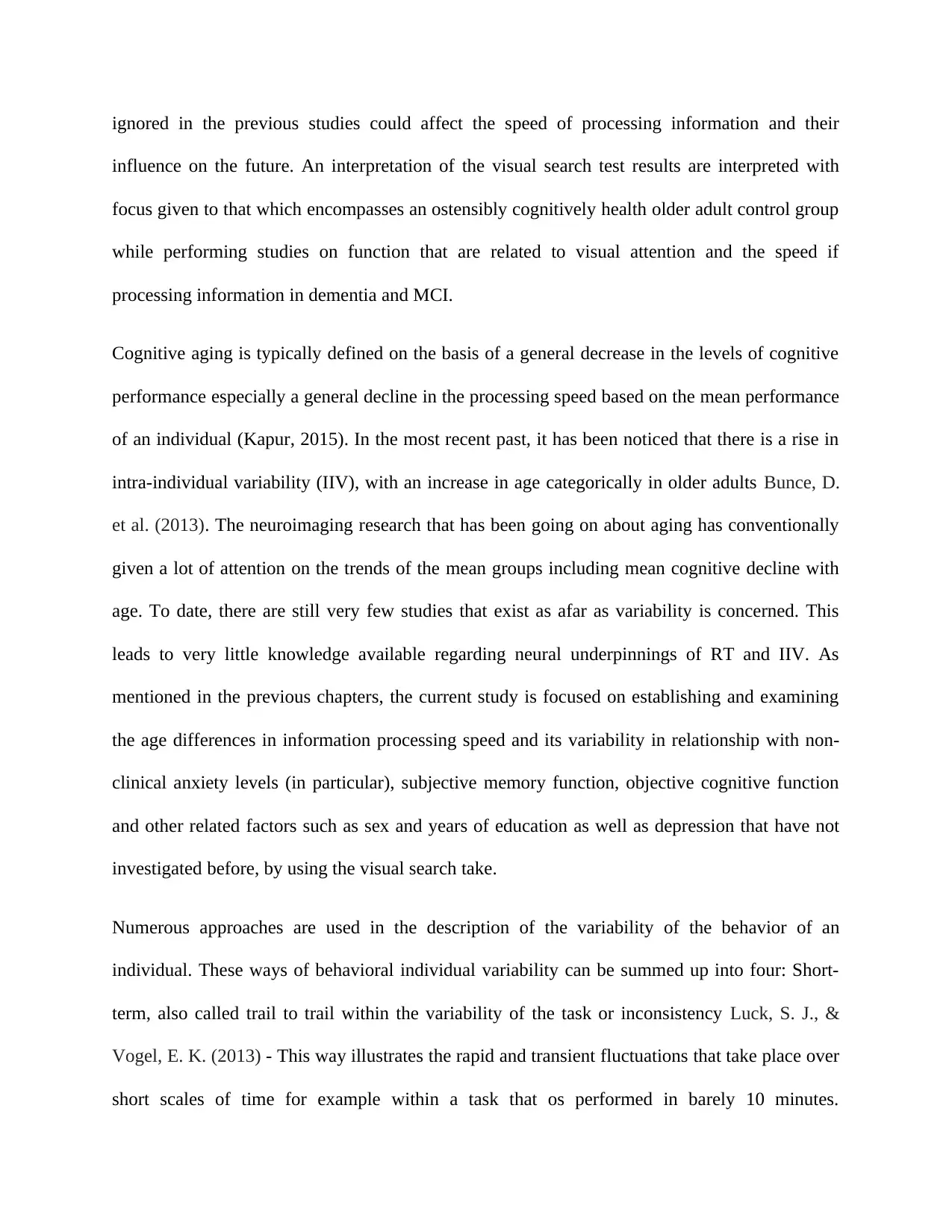
ignored in the previous studies could affect the speed of processing information and their
influence on the future. An interpretation of the visual search test results are interpreted with
focus given to that which encompasses an ostensibly cognitively health older adult control group
while performing studies on function that are related to visual attention and the speed if
processing information in dementia and MCI.
Cognitive aging is typically defined on the basis of a general decrease in the levels of cognitive
performance especially a general decline in the processing speed based on the mean performance
of an individual (Kapur, 2015). In the most recent past, it has been noticed that there is a rise in
intra-individual variability (IIV), with an increase in age categorically in older adults Bunce, D.
et al. (2013). The neuroimaging research that has been going on about aging has conventionally
given a lot of attention on the trends of the mean groups including mean cognitive decline with
age. To date, there are still very few studies that exist as afar as variability is concerned. This
leads to very little knowledge available regarding neural underpinnings of RT and IIV. As
mentioned in the previous chapters, the current study is focused on establishing and examining
the age differences in information processing speed and its variability in relationship with non-
clinical anxiety levels (in particular), subjective memory function, objective cognitive function
and other related factors such as sex and years of education as well as depression that have not
investigated before, by using the visual search take.
Numerous approaches are used in the description of the variability of the behavior of an
individual. These ways of behavioral individual variability can be summed up into four: Short-
term, also called trail to trail within the variability of the task or inconsistency Luck, S. J., &
Vogel, E. K. (2013) - This way illustrates the rapid and transient fluctuations that take place over
short scales of time for example within a task that os performed in barely 10 minutes.
influence on the future. An interpretation of the visual search test results are interpreted with
focus given to that which encompasses an ostensibly cognitively health older adult control group
while performing studies on function that are related to visual attention and the speed if
processing information in dementia and MCI.
Cognitive aging is typically defined on the basis of a general decrease in the levels of cognitive
performance especially a general decline in the processing speed based on the mean performance
of an individual (Kapur, 2015). In the most recent past, it has been noticed that there is a rise in
intra-individual variability (IIV), with an increase in age categorically in older adults Bunce, D.
et al. (2013). The neuroimaging research that has been going on about aging has conventionally
given a lot of attention on the trends of the mean groups including mean cognitive decline with
age. To date, there are still very few studies that exist as afar as variability is concerned. This
leads to very little knowledge available regarding neural underpinnings of RT and IIV. As
mentioned in the previous chapters, the current study is focused on establishing and examining
the age differences in information processing speed and its variability in relationship with non-
clinical anxiety levels (in particular), subjective memory function, objective cognitive function
and other related factors such as sex and years of education as well as depression that have not
investigated before, by using the visual search take.
Numerous approaches are used in the description of the variability of the behavior of an
individual. These ways of behavioral individual variability can be summed up into four: Short-
term, also called trail to trail within the variability of the task or inconsistency Luck, S. J., &
Vogel, E. K. (2013) - This way illustrates the rapid and transient fluctuations that take place over
short scales of time for example within a task that os performed in barely 10 minutes.
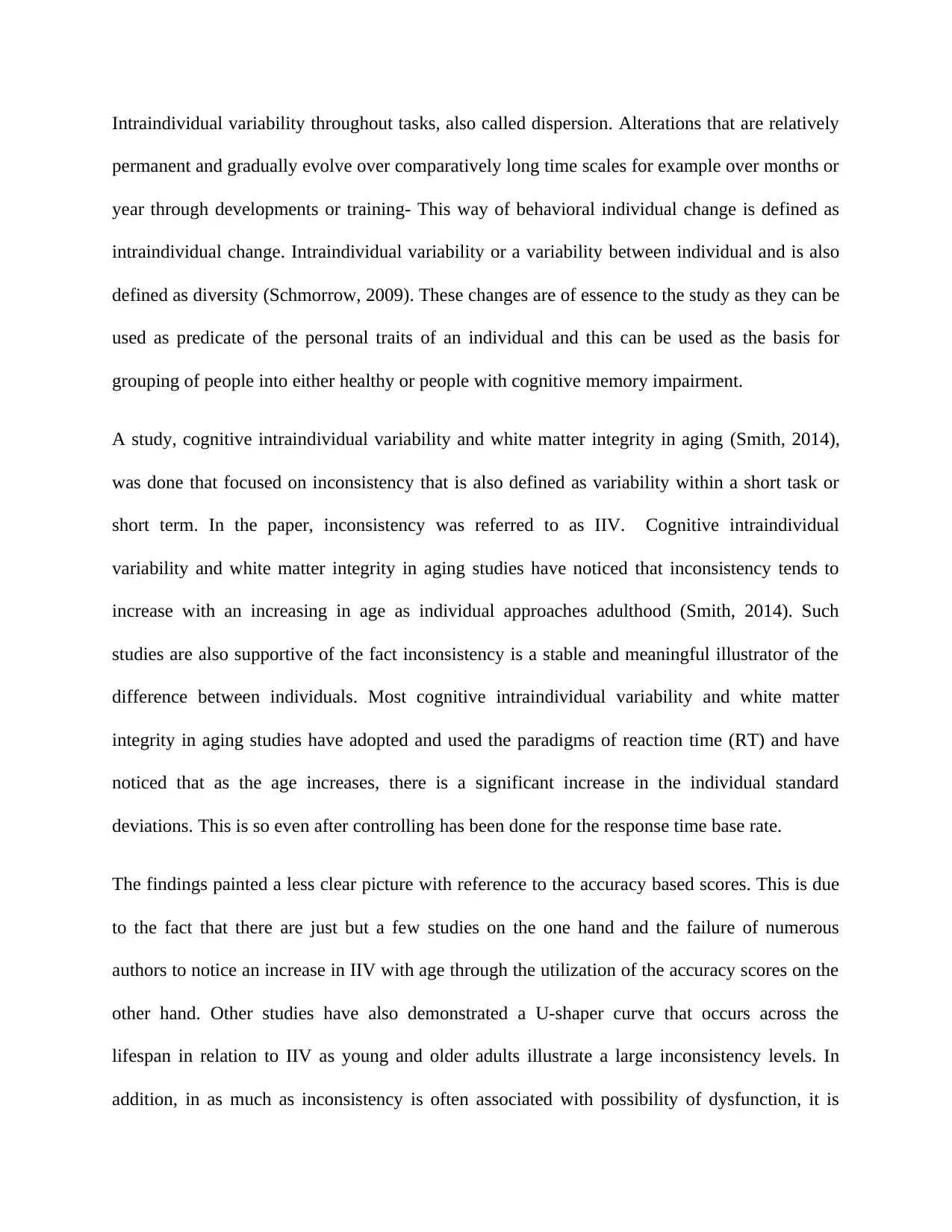
Intraindividual variability throughout tasks, also called dispersion. Alterations that are relatively
permanent and gradually evolve over comparatively long time scales for example over months or
year through developments or training- This way of behavioral individual change is defined as
intraindividual change. Intraindividual variability or a variability between individual and is also
defined as diversity (Schmorrow, 2009). These changes are of essence to the study as they can be
used as predicate of the personal traits of an individual and this can be used as the basis for
grouping of people into either healthy or people with cognitive memory impairment.
A study, cognitive intraindividual variability and white matter integrity in aging (Smith, 2014),
was done that focused on inconsistency that is also defined as variability within a short task or
short term. In the paper, inconsistency was referred to as IIV. Cognitive intraindividual
variability and white matter integrity in aging studies have noticed that inconsistency tends to
increase with an increasing in age as individual approaches adulthood (Smith, 2014). Such
studies are also supportive of the fact inconsistency is a stable and meaningful illustrator of the
difference between individuals. Most cognitive intraindividual variability and white matter
integrity in aging studies have adopted and used the paradigms of reaction time (RT) and have
noticed that as the age increases, there is a significant increase in the individual standard
deviations. This is so even after controlling has been done for the response time base rate.
The findings painted a less clear picture with reference to the accuracy based scores. This is due
to the fact that there are just but a few studies on the one hand and the failure of numerous
authors to notice an increase in IIV with age through the utilization of the accuracy scores on the
other hand. Other studies have also demonstrated a U-shaper curve that occurs across the
lifespan in relation to IIV as young and older adults illustrate a large inconsistency levels. In
addition, in as much as inconsistency is often associated with possibility of dysfunction, it is
permanent and gradually evolve over comparatively long time scales for example over months or
year through developments or training- This way of behavioral individual change is defined as
intraindividual change. Intraindividual variability or a variability between individual and is also
defined as diversity (Schmorrow, 2009). These changes are of essence to the study as they can be
used as predicate of the personal traits of an individual and this can be used as the basis for
grouping of people into either healthy or people with cognitive memory impairment.
A study, cognitive intraindividual variability and white matter integrity in aging (Smith, 2014),
was done that focused on inconsistency that is also defined as variability within a short task or
short term. In the paper, inconsistency was referred to as IIV. Cognitive intraindividual
variability and white matter integrity in aging studies have noticed that inconsistency tends to
increase with an increasing in age as individual approaches adulthood (Smith, 2014). Such
studies are also supportive of the fact inconsistency is a stable and meaningful illustrator of the
difference between individuals. Most cognitive intraindividual variability and white matter
integrity in aging studies have adopted and used the paradigms of reaction time (RT) and have
noticed that as the age increases, there is a significant increase in the individual standard
deviations. This is so even after controlling has been done for the response time base rate.
The findings painted a less clear picture with reference to the accuracy based scores. This is due
to the fact that there are just but a few studies on the one hand and the failure of numerous
authors to notice an increase in IIV with age through the utilization of the accuracy scores on the
other hand. Other studies have also demonstrated a U-shaper curve that occurs across the
lifespan in relation to IIV as young and older adults illustrate a large inconsistency levels. In
addition, in as much as inconsistency is often associated with possibility of dysfunction, it is
Secure Best Marks with AI Grader
Need help grading? Try our AI Grader for instant feedback on your assignments.
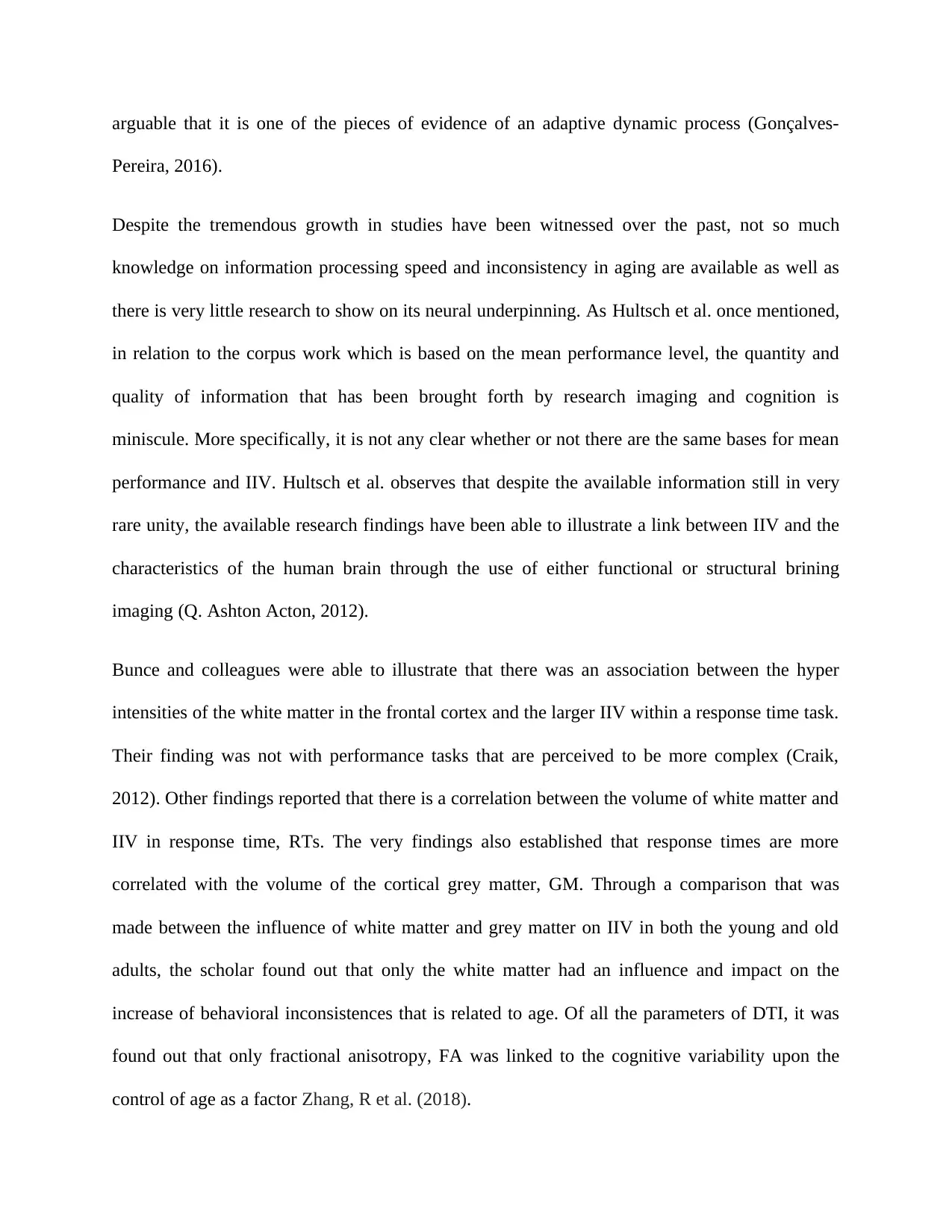
arguable that it is one of the pieces of evidence of an adaptive dynamic process (Gonçalves-
Pereira, 2016).
Despite the tremendous growth in studies have been witnessed over the past, not so much
knowledge on information processing speed and inconsistency in aging are available as well as
there is very little research to show on its neural underpinning. As Hultsch et al. once mentioned,
in relation to the corpus work which is based on the mean performance level, the quantity and
quality of information that has been brought forth by research imaging and cognition is
miniscule. More specifically, it is not any clear whether or not there are the same bases for mean
performance and IIV. Hultsch et al. observes that despite the available information still in very
rare unity, the available research findings have been able to illustrate a link between IIV and the
characteristics of the human brain through the use of either functional or structural brining
imaging (Q. Ashton Acton, 2012).
Bunce and colleagues were able to illustrate that there was an association between the hyper
intensities of the white matter in the frontal cortex and the larger IIV within a response time task.
Their finding was not with performance tasks that are perceived to be more complex (Craik,
2012). Other findings reported that there is a correlation between the volume of white matter and
IIV in response time, RTs. The very findings also established that response times are more
correlated with the volume of the cortical grey matter, GM. Through a comparison that was
made between the influence of white matter and grey matter on IIV in both the young and old
adults, the scholar found out that only the white matter had an influence and impact on the
increase of behavioral inconsistences that is related to age. Of all the parameters of DTI, it was
found out that only fractional anisotropy, FA was linked to the cognitive variability upon the
control of age as a factor Zhang, R et al. (2018).
Pereira, 2016).
Despite the tremendous growth in studies have been witnessed over the past, not so much
knowledge on information processing speed and inconsistency in aging are available as well as
there is very little research to show on its neural underpinning. As Hultsch et al. once mentioned,
in relation to the corpus work which is based on the mean performance level, the quantity and
quality of information that has been brought forth by research imaging and cognition is
miniscule. More specifically, it is not any clear whether or not there are the same bases for mean
performance and IIV. Hultsch et al. observes that despite the available information still in very
rare unity, the available research findings have been able to illustrate a link between IIV and the
characteristics of the human brain through the use of either functional or structural brining
imaging (Q. Ashton Acton, 2012).
Bunce and colleagues were able to illustrate that there was an association between the hyper
intensities of the white matter in the frontal cortex and the larger IIV within a response time task.
Their finding was not with performance tasks that are perceived to be more complex (Craik,
2012). Other findings reported that there is a correlation between the volume of white matter and
IIV in response time, RTs. The very findings also established that response times are more
correlated with the volume of the cortical grey matter, GM. Through a comparison that was
made between the influence of white matter and grey matter on IIV in both the young and old
adults, the scholar found out that only the white matter had an influence and impact on the
increase of behavioral inconsistences that is related to age. Of all the parameters of DTI, it was
found out that only fractional anisotropy, FA was linked to the cognitive variability upon the
control of age as a factor Zhang, R et al. (2018).
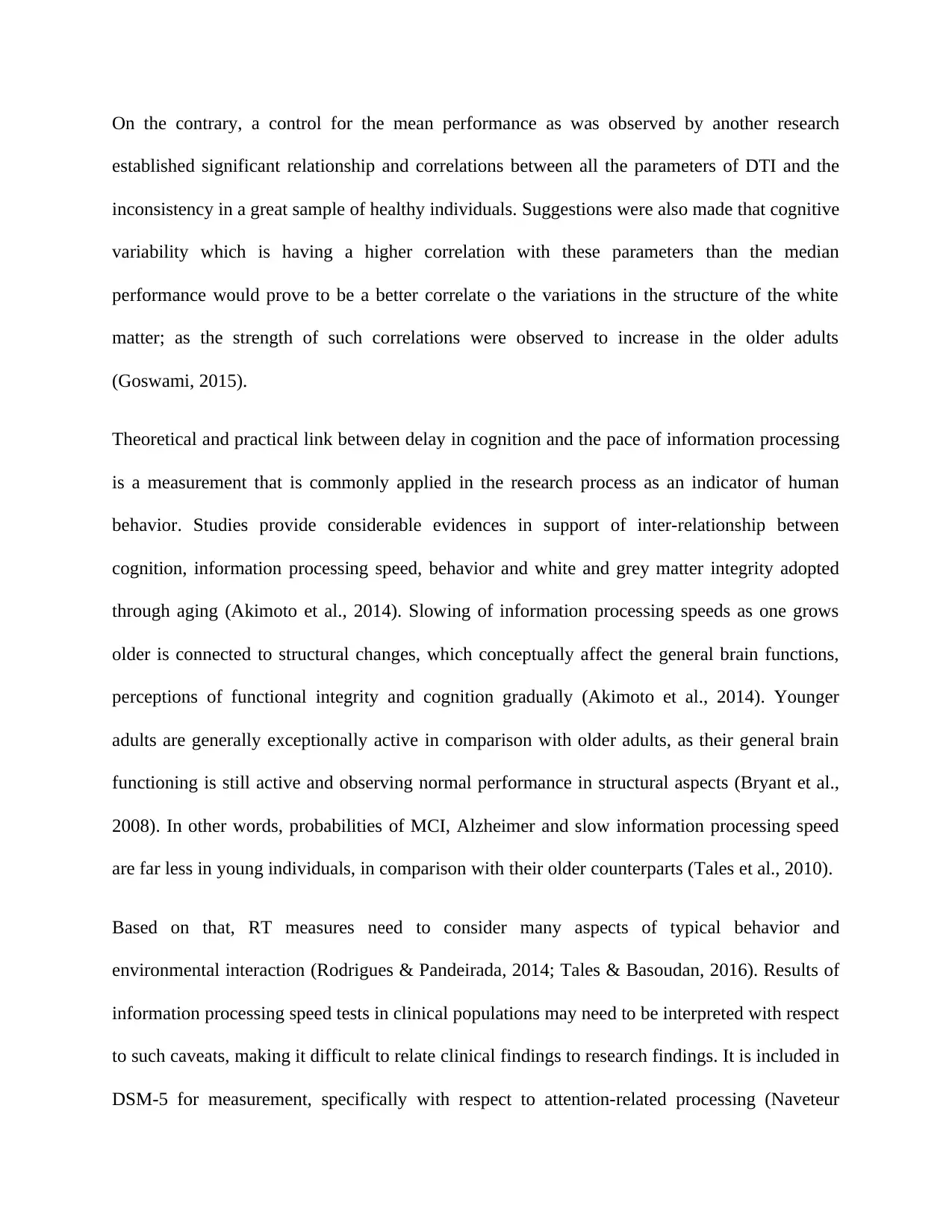
On the contrary, a control for the mean performance as was observed by another research
established significant relationship and correlations between all the parameters of DTI and the
inconsistency in a great sample of healthy individuals. Suggestions were also made that cognitive
variability which is having a higher correlation with these parameters than the median
performance would prove to be a better correlate o the variations in the structure of the white
matter; as the strength of such correlations were observed to increase in the older adults
(Goswami, 2015).
Theoretical and practical link between delay in cognition and the pace of information processing
is a measurement that is commonly applied in the research process as an indicator of human
behavior. Studies provide considerable evidences in support of inter-relationship between
cognition, information processing speed, behavior and white and grey matter integrity adopted
through aging (Akimoto et al., 2014). Slowing of information processing speeds as one grows
older is connected to structural changes, which conceptually affect the general brain functions,
perceptions of functional integrity and cognition gradually (Akimoto et al., 2014). Younger
adults are generally exceptionally active in comparison with older adults, as their general brain
functioning is still active and observing normal performance in structural aspects (Bryant et al.,
2008). In other words, probabilities of MCI, Alzheimer and slow information processing speed
are far less in young individuals, in comparison with their older counterparts (Tales et al., 2010).
Based on that, RT measures need to consider many aspects of typical behavior and
environmental interaction (Rodrigues & Pandeirada, 2014; Tales & Basoudan, 2016). Results of
information processing speed tests in clinical populations may need to be interpreted with respect
to such caveats, making it difficult to relate clinical findings to research findings. It is included in
DSM-5 for measurement, specifically with respect to attention-related processing (Naveteur
established significant relationship and correlations between all the parameters of DTI and the
inconsistency in a great sample of healthy individuals. Suggestions were also made that cognitive
variability which is having a higher correlation with these parameters than the median
performance would prove to be a better correlate o the variations in the structure of the white
matter; as the strength of such correlations were observed to increase in the older adults
(Goswami, 2015).
Theoretical and practical link between delay in cognition and the pace of information processing
is a measurement that is commonly applied in the research process as an indicator of human
behavior. Studies provide considerable evidences in support of inter-relationship between
cognition, information processing speed, behavior and white and grey matter integrity adopted
through aging (Akimoto et al., 2014). Slowing of information processing speeds as one grows
older is connected to structural changes, which conceptually affect the general brain functions,
perceptions of functional integrity and cognition gradually (Akimoto et al., 2014). Younger
adults are generally exceptionally active in comparison with older adults, as their general brain
functioning is still active and observing normal performance in structural aspects (Bryant et al.,
2008). In other words, probabilities of MCI, Alzheimer and slow information processing speed
are far less in young individuals, in comparison with their older counterparts (Tales et al., 2010).
Based on that, RT measures need to consider many aspects of typical behavior and
environmental interaction (Rodrigues & Pandeirada, 2014; Tales & Basoudan, 2016). Results of
information processing speed tests in clinical populations may need to be interpreted with respect
to such caveats, making it difficult to relate clinical findings to research findings. It is included in
DSM-5 for measurement, specifically with respect to attention-related processing (Naveteur
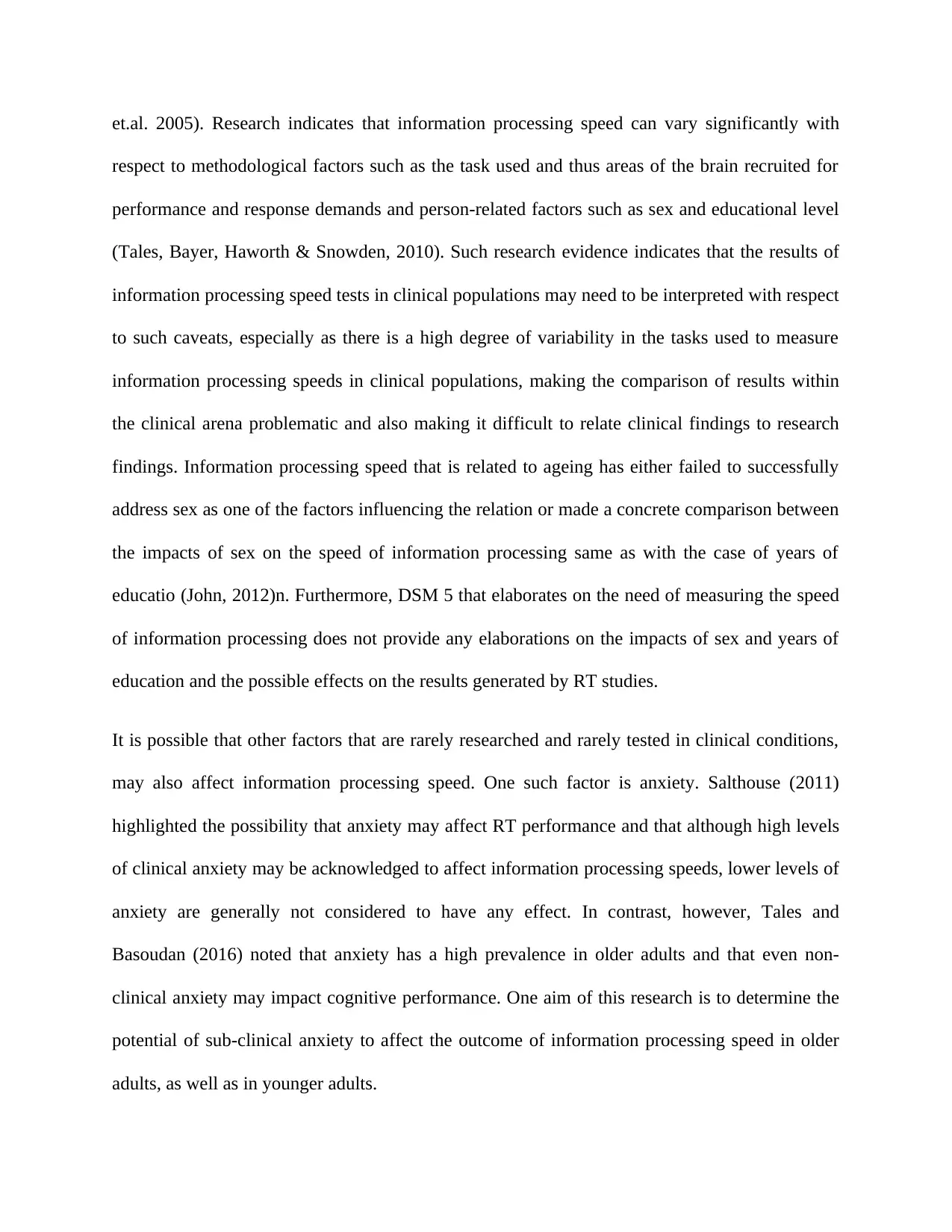
et.al. 2005). Research indicates that information processing speed can vary significantly with
respect to methodological factors such as the task used and thus areas of the brain recruited for
performance and response demands and person-related factors such as sex and educational level
(Tales, Bayer, Haworth & Snowden, 2010). Such research evidence indicates that the results of
information processing speed tests in clinical populations may need to be interpreted with respect
to such caveats, especially as there is a high degree of variability in the tasks used to measure
information processing speeds in clinical populations, making the comparison of results within
the clinical arena problematic and also making it difficult to relate clinical findings to research
findings. Information processing speed that is related to ageing has either failed to successfully
address sex as one of the factors influencing the relation or made a concrete comparison between
the impacts of sex on the speed of information processing same as with the case of years of
educatio (John, 2012)n. Furthermore, DSM 5 that elaborates on the need of measuring the speed
of information processing does not provide any elaborations on the impacts of sex and years of
education and the possible effects on the results generated by RT studies.
It is possible that other factors that are rarely researched and rarely tested in clinical conditions,
may also affect information processing speed. One such factor is anxiety. Salthouse (2011)
highlighted the possibility that anxiety may affect RT performance and that although high levels
of clinical anxiety may be acknowledged to affect information processing speeds, lower levels of
anxiety are generally not considered to have any effect. In contrast, however, Tales and
Basoudan (2016) noted that anxiety has a high prevalence in older adults and that even non-
clinical anxiety may impact cognitive performance. One aim of this research is to determine the
potential of sub-clinical anxiety to affect the outcome of information processing speed in older
adults, as well as in younger adults.
respect to methodological factors such as the task used and thus areas of the brain recruited for
performance and response demands and person-related factors such as sex and educational level
(Tales, Bayer, Haworth & Snowden, 2010). Such research evidence indicates that the results of
information processing speed tests in clinical populations may need to be interpreted with respect
to such caveats, especially as there is a high degree of variability in the tasks used to measure
information processing speeds in clinical populations, making the comparison of results within
the clinical arena problematic and also making it difficult to relate clinical findings to research
findings. Information processing speed that is related to ageing has either failed to successfully
address sex as one of the factors influencing the relation or made a concrete comparison between
the impacts of sex on the speed of information processing same as with the case of years of
educatio (John, 2012)n. Furthermore, DSM 5 that elaborates on the need of measuring the speed
of information processing does not provide any elaborations on the impacts of sex and years of
education and the possible effects on the results generated by RT studies.
It is possible that other factors that are rarely researched and rarely tested in clinical conditions,
may also affect information processing speed. One such factor is anxiety. Salthouse (2011)
highlighted the possibility that anxiety may affect RT performance and that although high levels
of clinical anxiety may be acknowledged to affect information processing speeds, lower levels of
anxiety are generally not considered to have any effect. In contrast, however, Tales and
Basoudan (2016) noted that anxiety has a high prevalence in older adults and that even non-
clinical anxiety may impact cognitive performance. One aim of this research is to determine the
potential of sub-clinical anxiety to affect the outcome of information processing speed in older
adults, as well as in younger adults.
Paraphrase This Document
Need a fresh take? Get an instant paraphrase of this document with our AI Paraphraser

Another factor that has rarely been considered in the investigation of information processing
speed in ageing and ageing-related disease is subjective cognitive function. There has been
growing concerns about cognitive decline specifically in memory mostly in older adults and it is
increasing becoming evident that both dementia and MCI could be characterized by an earlier
stage which is normally termed as subjective cognitive impairment. It should be noted however
that complaints of subjective cognitive are not always representative of a prodromal stage of
dementia with some of the causes such as sleep disorder, anxiety and anxiety being potentially
responsive. Regardless of the casualty there have been concerns on the negative impacts that
memory function can have on the everyday life as well as the mental health Donaghy, P. C.,
O'brien, J. T., & Thomas, A. J. (2015).
SCI are associated with neuropsychological test performance that is objectively defined (John,
2012). Chances are that objective change can be missing in functions including memory since
the test adopted are at times insensitive and hence cannot be used in ,measuring the specific
aspects of the memory of an individual. there can be detrimental changes that can occur in the
functions of the brain other than the fact that memory may take place in what is referred to SCI
even though this may be challenging to be described by the general public (Goswami, 2015).
Available evidence illustrates that there is significant disruption of the operations of the
fundamental brain in people with SCI. this makes it a possibility that the fundamental process of
the brain may lead to impairment of the function of the memory even though there has not been
any concrete evidence from the existing neuropsychological protocol of testing.
In as much as there is proof of existence of a relation between cognition, information processing
speed, integrity of white and grey matter and behavior especially in aging, dementia and MCI,
speed in ageing and ageing-related disease is subjective cognitive function. There has been
growing concerns about cognitive decline specifically in memory mostly in older adults and it is
increasing becoming evident that both dementia and MCI could be characterized by an earlier
stage which is normally termed as subjective cognitive impairment. It should be noted however
that complaints of subjective cognitive are not always representative of a prodromal stage of
dementia with some of the causes such as sleep disorder, anxiety and anxiety being potentially
responsive. Regardless of the casualty there have been concerns on the negative impacts that
memory function can have on the everyday life as well as the mental health Donaghy, P. C.,
O'brien, J. T., & Thomas, A. J. (2015).
SCI are associated with neuropsychological test performance that is objectively defined (John,
2012). Chances are that objective change can be missing in functions including memory since
the test adopted are at times insensitive and hence cannot be used in ,measuring the specific
aspects of the memory of an individual. there can be detrimental changes that can occur in the
functions of the brain other than the fact that memory may take place in what is referred to SCI
even though this may be challenging to be described by the general public (Goswami, 2015).
Available evidence illustrates that there is significant disruption of the operations of the
fundamental brain in people with SCI. this makes it a possibility that the fundamental process of
the brain may lead to impairment of the function of the memory even though there has not been
any concrete evidence from the existing neuropsychological protocol of testing.
In as much as there is proof of existence of a relation between cognition, information processing
speed, integrity of white and grey matter and behavior especially in aging, dementia and MCI,
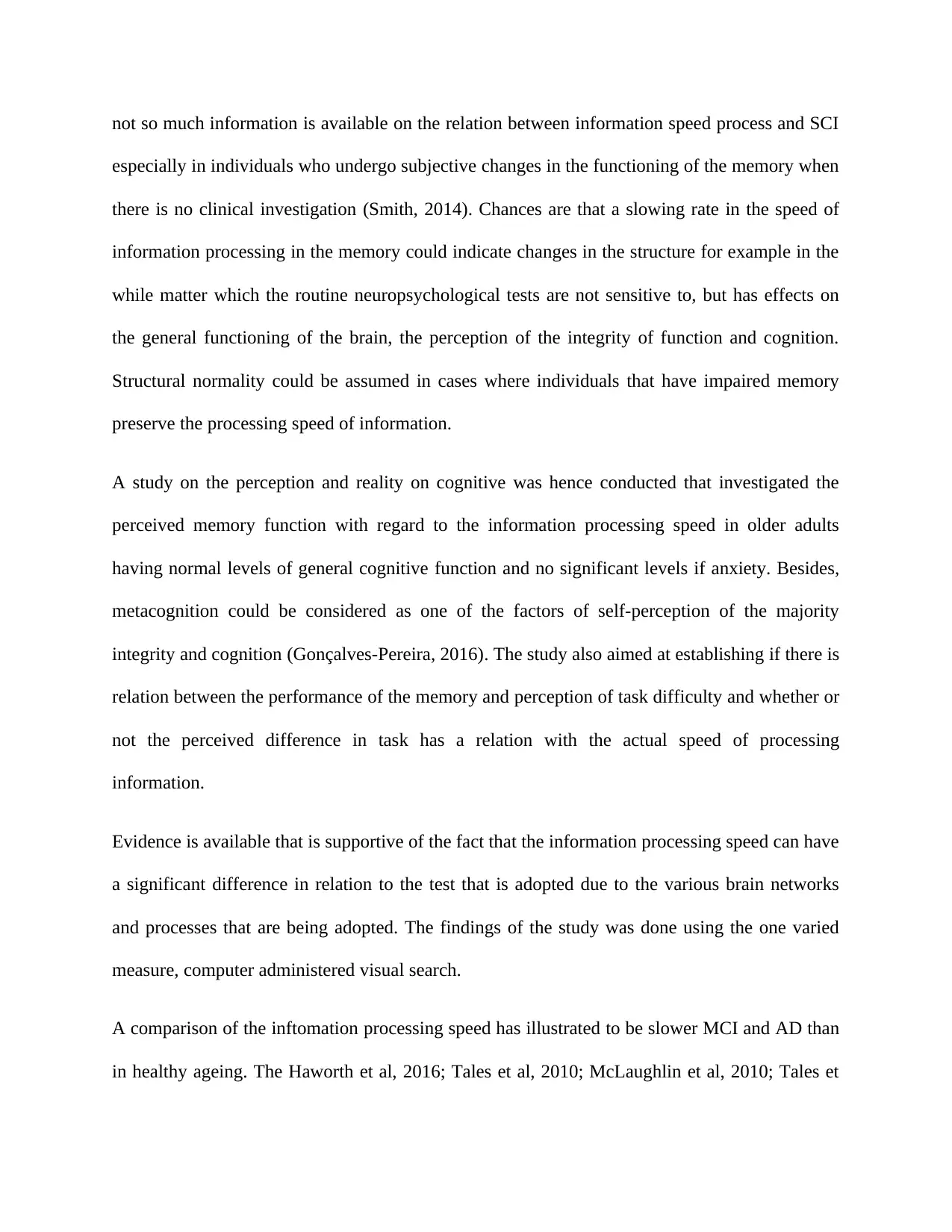
not so much information is available on the relation between information speed process and SCI
especially in individuals who undergo subjective changes in the functioning of the memory when
there is no clinical investigation (Smith, 2014). Chances are that a slowing rate in the speed of
information processing in the memory could indicate changes in the structure for example in the
while matter which the routine neuropsychological tests are not sensitive to, but has effects on
the general functioning of the brain, the perception of the integrity of function and cognition.
Structural normality could be assumed in cases where individuals that have impaired memory
preserve the processing speed of information.
A study on the perception and reality on cognitive was hence conducted that investigated the
perceived memory function with regard to the information processing speed in older adults
having normal levels of general cognitive function and no significant levels if anxiety. Besides,
metacognition could be considered as one of the factors of self-perception of the majority
integrity and cognition (Gonçalves-Pereira, 2016). The study also aimed at establishing if there is
relation between the performance of the memory and perception of task difficulty and whether or
not the perceived difference in task has a relation with the actual speed of processing
information.
Evidence is available that is supportive of the fact that the information processing speed can have
a significant difference in relation to the test that is adopted due to the various brain networks
and processes that are being adopted. The findings of the study was done using the one varied
measure, computer administered visual search.
A comparison of the inftomation processing speed has illustrated to be slower MCI and AD than
in healthy ageing. The Haworth et al, 2016; Tales et al, 2010; McLaughlin et al, 2010; Tales et
especially in individuals who undergo subjective changes in the functioning of the memory when
there is no clinical investigation (Smith, 2014). Chances are that a slowing rate in the speed of
information processing in the memory could indicate changes in the structure for example in the
while matter which the routine neuropsychological tests are not sensitive to, but has effects on
the general functioning of the brain, the perception of the integrity of function and cognition.
Structural normality could be assumed in cases where individuals that have impaired memory
preserve the processing speed of information.
A study on the perception and reality on cognitive was hence conducted that investigated the
perceived memory function with regard to the information processing speed in older adults
having normal levels of general cognitive function and no significant levels if anxiety. Besides,
metacognition could be considered as one of the factors of self-perception of the majority
integrity and cognition (Gonçalves-Pereira, 2016). The study also aimed at establishing if there is
relation between the performance of the memory and perception of task difficulty and whether or
not the perceived difference in task has a relation with the actual speed of processing
information.
Evidence is available that is supportive of the fact that the information processing speed can have
a significant difference in relation to the test that is adopted due to the various brain networks
and processes that are being adopted. The findings of the study was done using the one varied
measure, computer administered visual search.
A comparison of the inftomation processing speed has illustrated to be slower MCI and AD than
in healthy ageing. The Haworth et al, 2016; Tales et al, 2010; McLaughlin et al, 2010; Tales et
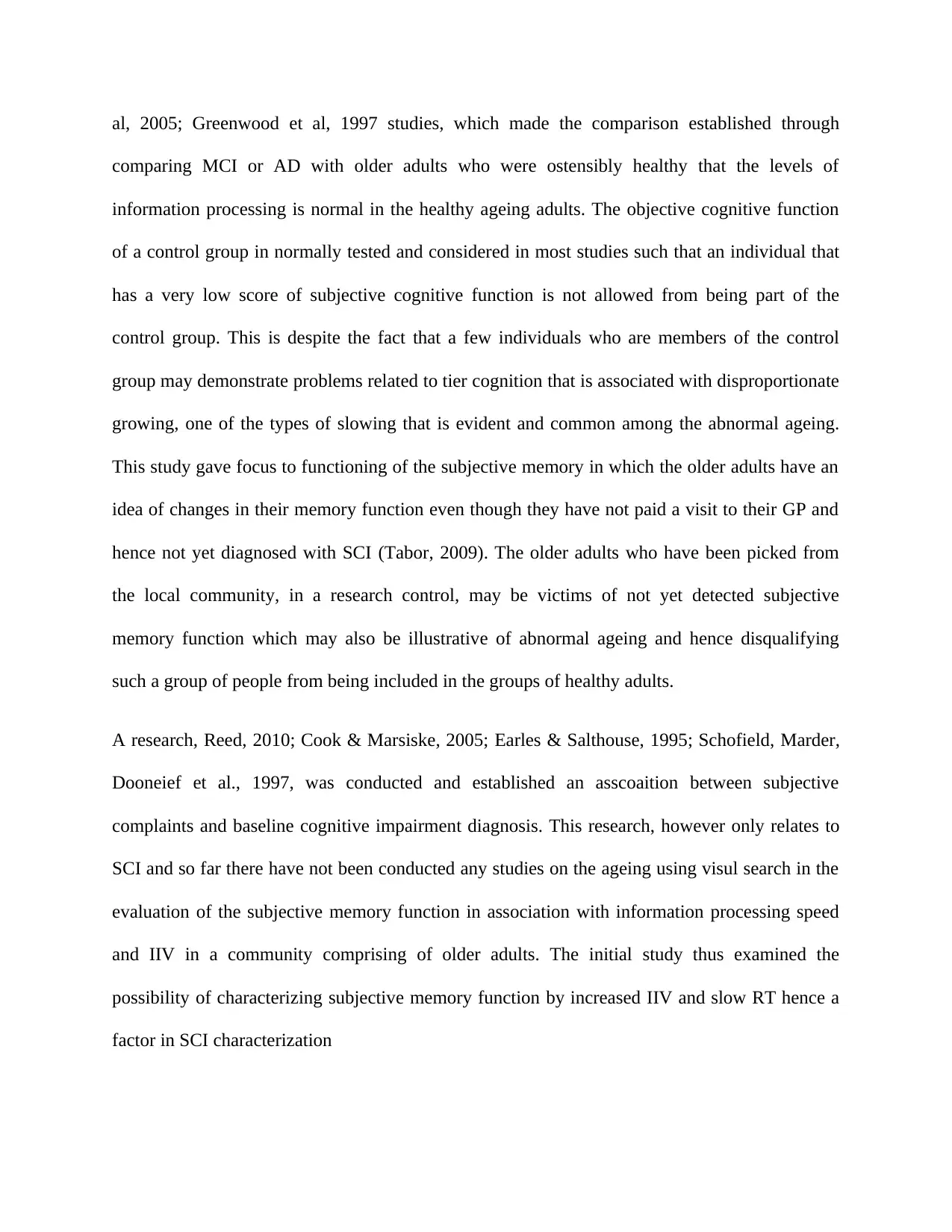
al, 2005; Greenwood et al, 1997 studies, which made the comparison established through
comparing MCI or AD with older adults who were ostensibly healthy that the levels of
information processing is normal in the healthy ageing adults. The objective cognitive function
of a control group in normally tested and considered in most studies such that an individual that
has a very low score of subjective cognitive function is not allowed from being part of the
control group. This is despite the fact that a few individuals who are members of the control
group may demonstrate problems related to tier cognition that is associated with disproportionate
growing, one of the types of slowing that is evident and common among the abnormal ageing.
This study gave focus to functioning of the subjective memory in which the older adults have an
idea of changes in their memory function even though they have not paid a visit to their GP and
hence not yet diagnosed with SCI (Tabor, 2009). The older adults who have been picked from
the local community, in a research control, may be victims of not yet detected subjective
memory function which may also be illustrative of abnormal ageing and hence disqualifying
such a group of people from being included in the groups of healthy adults.
A research, Reed, 2010; Cook & Marsiske, 2005; Earles & Salthouse, 1995; Schofield, Marder,
Dooneief et al., 1997, was conducted and established an asscoaition between subjective
complaints and baseline cognitive impairment diagnosis. This research, however only relates to
SCI and so far there have not been conducted any studies on the ageing using visul search in the
evaluation of the subjective memory function in association with information processing speed
and IIV in a community comprising of older adults. The initial study thus examined the
possibility of characterizing subjective memory function by increased IIV and slow RT hence a
factor in SCI characterization
comparing MCI or AD with older adults who were ostensibly healthy that the levels of
information processing is normal in the healthy ageing adults. The objective cognitive function
of a control group in normally tested and considered in most studies such that an individual that
has a very low score of subjective cognitive function is not allowed from being part of the
control group. This is despite the fact that a few individuals who are members of the control
group may demonstrate problems related to tier cognition that is associated with disproportionate
growing, one of the types of slowing that is evident and common among the abnormal ageing.
This study gave focus to functioning of the subjective memory in which the older adults have an
idea of changes in their memory function even though they have not paid a visit to their GP and
hence not yet diagnosed with SCI (Tabor, 2009). The older adults who have been picked from
the local community, in a research control, may be victims of not yet detected subjective
memory function which may also be illustrative of abnormal ageing and hence disqualifying
such a group of people from being included in the groups of healthy adults.
A research, Reed, 2010; Cook & Marsiske, 2005; Earles & Salthouse, 1995; Schofield, Marder,
Dooneief et al., 1997, was conducted and established an asscoaition between subjective
complaints and baseline cognitive impairment diagnosis. This research, however only relates to
SCI and so far there have not been conducted any studies on the ageing using visul search in the
evaluation of the subjective memory function in association with information processing speed
and IIV in a community comprising of older adults. The initial study thus examined the
possibility of characterizing subjective memory function by increased IIV and slow RT hence a
factor in SCI characterization
Secure Best Marks with AI Grader
Need help grading? Try our AI Grader for instant feedback on your assignments.
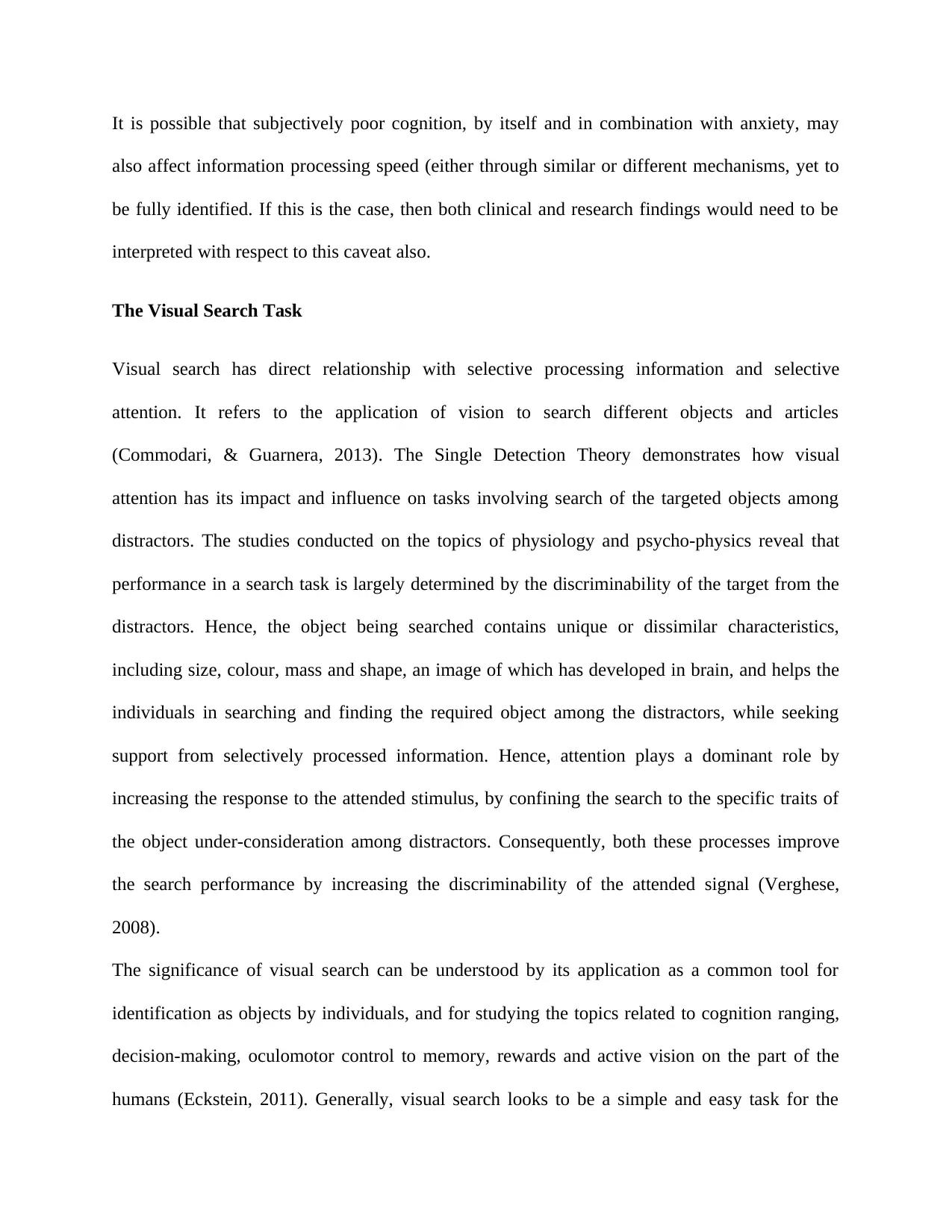
It is possible that subjectively poor cognition, by itself and in combination with anxiety, may
also affect information processing speed (either through similar or different mechanisms, yet to
be fully identified. If this is the case, then both clinical and research findings would need to be
interpreted with respect to this caveat also.
The Visual Search Task
Visual search has direct relationship with selective processing information and selective
attention. It refers to the application of vision to search different objects and articles
(Commodari, & Guarnera, 2013). The Single Detection Theory demonstrates how visual
attention has its impact and influence on tasks involving search of the targeted objects among
distractors. The studies conducted on the topics of physiology and psycho-physics reveal that
performance in a search task is largely determined by the discriminability of the target from the
distractors. Hence, the object being searched contains unique or dissimilar characteristics,
including size, colour, mass and shape, an image of which has developed in brain, and helps the
individuals in searching and finding the required object among the distractors, while seeking
support from selectively processed information. Hence, attention plays a dominant role by
increasing the response to the attended stimulus, by confining the search to the specific traits of
the object under-consideration among distractors. Consequently, both these processes improve
the search performance by increasing the discriminability of the attended signal (Verghese,
2008).
The significance of visual search can be understood by its application as a common tool for
identification as objects by individuals, and for studying the topics related to cognition ranging,
decision-making, oculomotor control to memory, rewards and active vision on the part of the
humans (Eckstein, 2011). Generally, visual search looks to be a simple and easy task for the
also affect information processing speed (either through similar or different mechanisms, yet to
be fully identified. If this is the case, then both clinical and research findings would need to be
interpreted with respect to this caveat also.
The Visual Search Task
Visual search has direct relationship with selective processing information and selective
attention. It refers to the application of vision to search different objects and articles
(Commodari, & Guarnera, 2013). The Single Detection Theory demonstrates how visual
attention has its impact and influence on tasks involving search of the targeted objects among
distractors. The studies conducted on the topics of physiology and psycho-physics reveal that
performance in a search task is largely determined by the discriminability of the target from the
distractors. Hence, the object being searched contains unique or dissimilar characteristics,
including size, colour, mass and shape, an image of which has developed in brain, and helps the
individuals in searching and finding the required object among the distractors, while seeking
support from selectively processed information. Hence, attention plays a dominant role by
increasing the response to the attended stimulus, by confining the search to the specific traits of
the object under-consideration among distractors. Consequently, both these processes improve
the search performance by increasing the discriminability of the attended signal (Verghese,
2008).
The significance of visual search can be understood by its application as a common tool for
identification as objects by individuals, and for studying the topics related to cognition ranging,
decision-making, oculomotor control to memory, rewards and active vision on the part of the
humans (Eckstein, 2011). Generally, visual search looks to be a simple and easy task for the
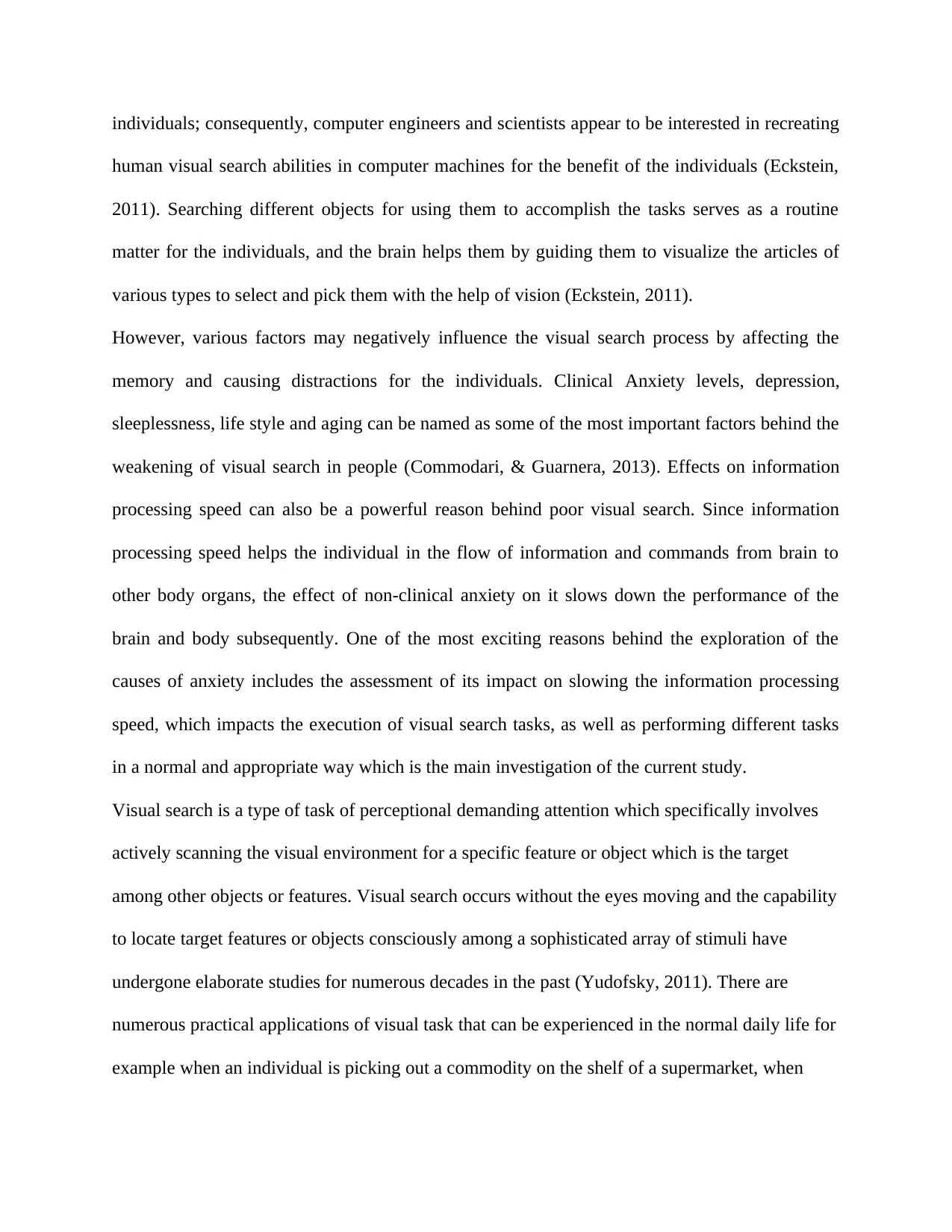
individuals; consequently, computer engineers and scientists appear to be interested in recreating
human visual search abilities in computer machines for the benefit of the individuals (Eckstein,
2011). Searching different objects for using them to accomplish the tasks serves as a routine
matter for the individuals, and the brain helps them by guiding them to visualize the articles of
various types to select and pick them with the help of vision (Eckstein, 2011).
However, various factors may negatively influence the visual search process by affecting the
memory and causing distractions for the individuals. Clinical Anxiety levels, depression,
sleeplessness, life style and aging can be named as some of the most important factors behind the
weakening of visual search in people (Commodari, & Guarnera, 2013). Effects on information
processing speed can also be a powerful reason behind poor visual search. Since information
processing speed helps the individual in the flow of information and commands from brain to
other body organs, the effect of non-clinical anxiety on it slows down the performance of the
brain and body subsequently. One of the most exciting reasons behind the exploration of the
causes of anxiety includes the assessment of its impact on slowing the information processing
speed, which impacts the execution of visual search tasks, as well as performing different tasks
in a normal and appropriate way which is the main investigation of the current study.
Visual search is a type of task of perceptional demanding attention which specifically involves
actively scanning the visual environment for a specific feature or object which is the target
among other objects or features. Visual search occurs without the eyes moving and the capability
to locate target features or objects consciously among a sophisticated array of stimuli have
undergone elaborate studies for numerous decades in the past (Yudofsky, 2011). There are
numerous practical applications of visual task that can be experienced in the normal daily life for
example when an individual is picking out a commodity on the shelf of a supermarket, when
human visual search abilities in computer machines for the benefit of the individuals (Eckstein,
2011). Searching different objects for using them to accomplish the tasks serves as a routine
matter for the individuals, and the brain helps them by guiding them to visualize the articles of
various types to select and pick them with the help of vision (Eckstein, 2011).
However, various factors may negatively influence the visual search process by affecting the
memory and causing distractions for the individuals. Clinical Anxiety levels, depression,
sleeplessness, life style and aging can be named as some of the most important factors behind the
weakening of visual search in people (Commodari, & Guarnera, 2013). Effects on information
processing speed can also be a powerful reason behind poor visual search. Since information
processing speed helps the individual in the flow of information and commands from brain to
other body organs, the effect of non-clinical anxiety on it slows down the performance of the
brain and body subsequently. One of the most exciting reasons behind the exploration of the
causes of anxiety includes the assessment of its impact on slowing the information processing
speed, which impacts the execution of visual search tasks, as well as performing different tasks
in a normal and appropriate way which is the main investigation of the current study.
Visual search is a type of task of perceptional demanding attention which specifically involves
actively scanning the visual environment for a specific feature or object which is the target
among other objects or features. Visual search occurs without the eyes moving and the capability
to locate target features or objects consciously among a sophisticated array of stimuli have
undergone elaborate studies for numerous decades in the past (Yudofsky, 2011). There are
numerous practical applications of visual task that can be experienced in the normal daily life for
example when an individual is picking out a commodity on the shelf of a supermarket, when
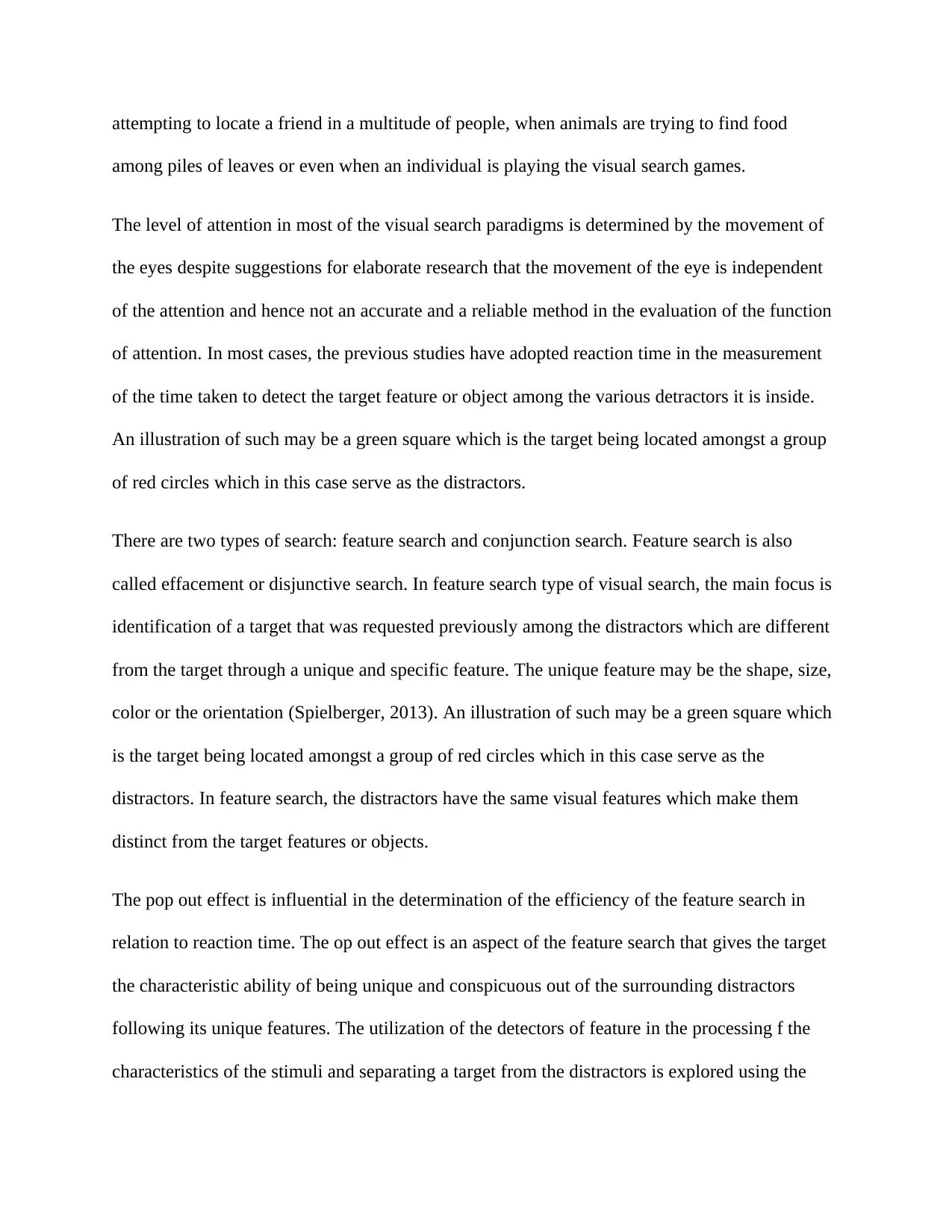
attempting to locate a friend in a multitude of people, when animals are trying to find food
among piles of leaves or even when an individual is playing the visual search games.
The level of attention in most of the visual search paradigms is determined by the movement of
the eyes despite suggestions for elaborate research that the movement of the eye is independent
of the attention and hence not an accurate and a reliable method in the evaluation of the function
of attention. In most cases, the previous studies have adopted reaction time in the measurement
of the time taken to detect the target feature or object among the various detractors it is inside.
An illustration of such may be a green square which is the target being located amongst a group
of red circles which in this case serve as the distractors.
There are two types of search: feature search and conjunction search. Feature search is also
called effacement or disjunctive search. In feature search type of visual search, the main focus is
identification of a target that was requested previously among the distractors which are different
from the target through a unique and specific feature. The unique feature may be the shape, size,
color or the orientation (Spielberger, 2013). An illustration of such may be a green square which
is the target being located amongst a group of red circles which in this case serve as the
distractors. In feature search, the distractors have the same visual features which make them
distinct from the target features or objects.
The pop out effect is influential in the determination of the efficiency of the feature search in
relation to reaction time. The op out effect is an aspect of the feature search that gives the target
the characteristic ability of being unique and conspicuous out of the surrounding distractors
following its unique features. The utilization of the detectors of feature in the processing f the
characteristics of the stimuli and separating a target from the distractors is explored using the
among piles of leaves or even when an individual is playing the visual search games.
The level of attention in most of the visual search paradigms is determined by the movement of
the eyes despite suggestions for elaborate research that the movement of the eye is independent
of the attention and hence not an accurate and a reliable method in the evaluation of the function
of attention. In most cases, the previous studies have adopted reaction time in the measurement
of the time taken to detect the target feature or object among the various detractors it is inside.
An illustration of such may be a green square which is the target being located amongst a group
of red circles which in this case serve as the distractors.
There are two types of search: feature search and conjunction search. Feature search is also
called effacement or disjunctive search. In feature search type of visual search, the main focus is
identification of a target that was requested previously among the distractors which are different
from the target through a unique and specific feature. The unique feature may be the shape, size,
color or the orientation (Spielberger, 2013). An illustration of such may be a green square which
is the target being located amongst a group of red circles which in this case serve as the
distractors. In feature search, the distractors have the same visual features which make them
distinct from the target features or objects.
The pop out effect is influential in the determination of the efficiency of the feature search in
relation to reaction time. The op out effect is an aspect of the feature search that gives the target
the characteristic ability of being unique and conspicuous out of the surrounding distractors
following its unique features. The utilization of the detectors of feature in the processing f the
characteristics of the stimuli and separating a target from the distractors is explored using the
Paraphrase This Document
Need a fresh take? Get an instant paraphrase of this document with our AI Paraphraser
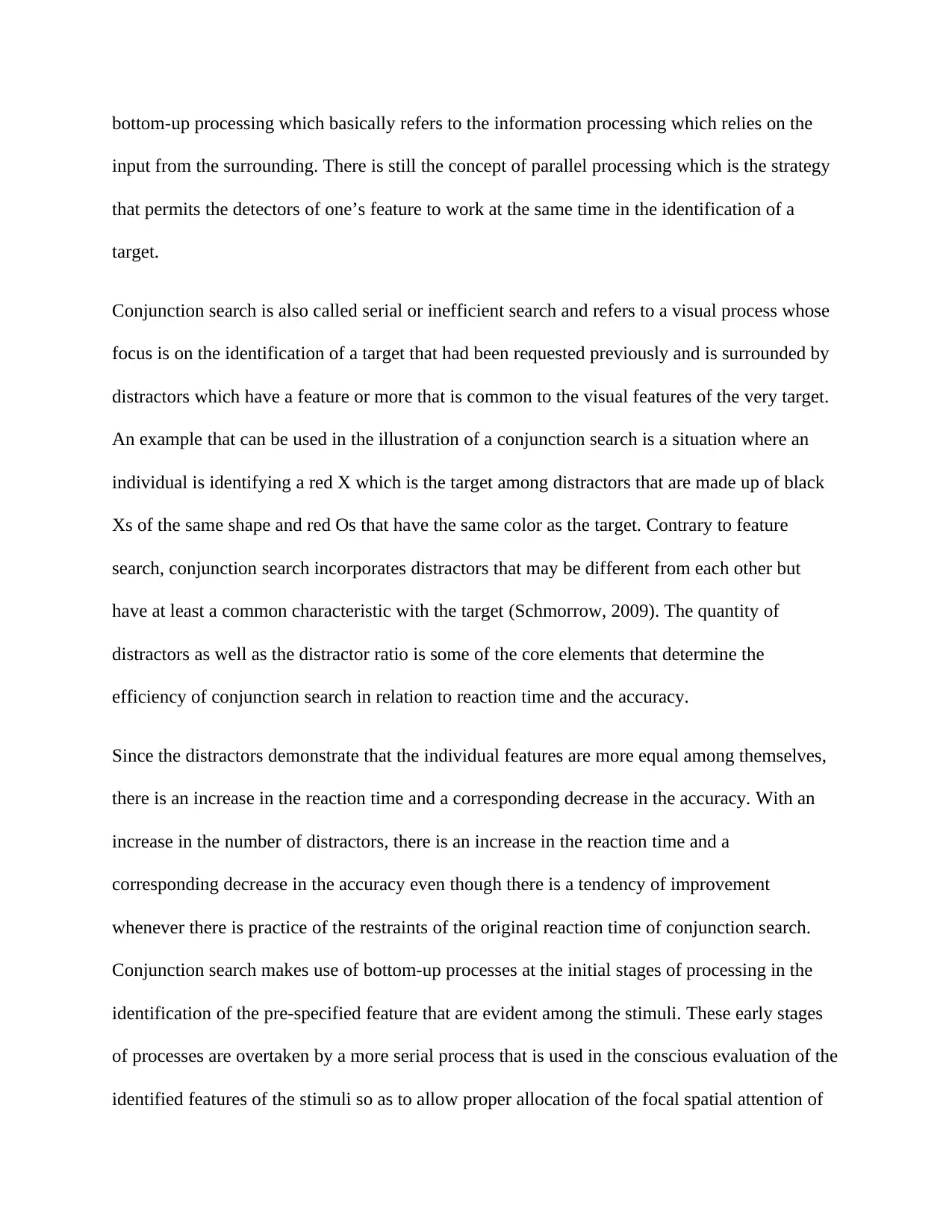
bottom-up processing which basically refers to the information processing which relies on the
input from the surrounding. There is still the concept of parallel processing which is the strategy
that permits the detectors of one’s feature to work at the same time in the identification of a
target.
Conjunction search is also called serial or inefficient search and refers to a visual process whose
focus is on the identification of a target that had been requested previously and is surrounded by
distractors which have a feature or more that is common to the visual features of the very target.
An example that can be used in the illustration of a conjunction search is a situation where an
individual is identifying a red X which is the target among distractors that are made up of black
Xs of the same shape and red Os that have the same color as the target. Contrary to feature
search, conjunction search incorporates distractors that may be different from each other but
have at least a common characteristic with the target (Schmorrow, 2009). The quantity of
distractors as well as the distractor ratio is some of the core elements that determine the
efficiency of conjunction search in relation to reaction time and the accuracy.
Since the distractors demonstrate that the individual features are more equal among themselves,
there is an increase in the reaction time and a corresponding decrease in the accuracy. With an
increase in the number of distractors, there is an increase in the reaction time and a
corresponding decrease in the accuracy even though there is a tendency of improvement
whenever there is practice of the restraints of the original reaction time of conjunction search.
Conjunction search makes use of bottom-up processes at the initial stages of processing in the
identification of the pre-specified feature that are evident among the stimuli. These early stages
of processes are overtaken by a more serial process that is used in the conscious evaluation of the
identified features of the stimuli so as to allow proper allocation of the focal spatial attention of
input from the surrounding. There is still the concept of parallel processing which is the strategy
that permits the detectors of one’s feature to work at the same time in the identification of a
target.
Conjunction search is also called serial or inefficient search and refers to a visual process whose
focus is on the identification of a target that had been requested previously and is surrounded by
distractors which have a feature or more that is common to the visual features of the very target.
An example that can be used in the illustration of a conjunction search is a situation where an
individual is identifying a red X which is the target among distractors that are made up of black
Xs of the same shape and red Os that have the same color as the target. Contrary to feature
search, conjunction search incorporates distractors that may be different from each other but
have at least a common characteristic with the target (Schmorrow, 2009). The quantity of
distractors as well as the distractor ratio is some of the core elements that determine the
efficiency of conjunction search in relation to reaction time and the accuracy.
Since the distractors demonstrate that the individual features are more equal among themselves,
there is an increase in the reaction time and a corresponding decrease in the accuracy. With an
increase in the number of distractors, there is an increase in the reaction time and a
corresponding decrease in the accuracy even though there is a tendency of improvement
whenever there is practice of the restraints of the original reaction time of conjunction search.
Conjunction search makes use of bottom-up processes at the initial stages of processing in the
identification of the pre-specified feature that are evident among the stimuli. These early stages
of processes are overtaken by a more serial process that is used in the conscious evaluation of the
identified features of the stimuli so as to allow proper allocation of the focal spatial attention of
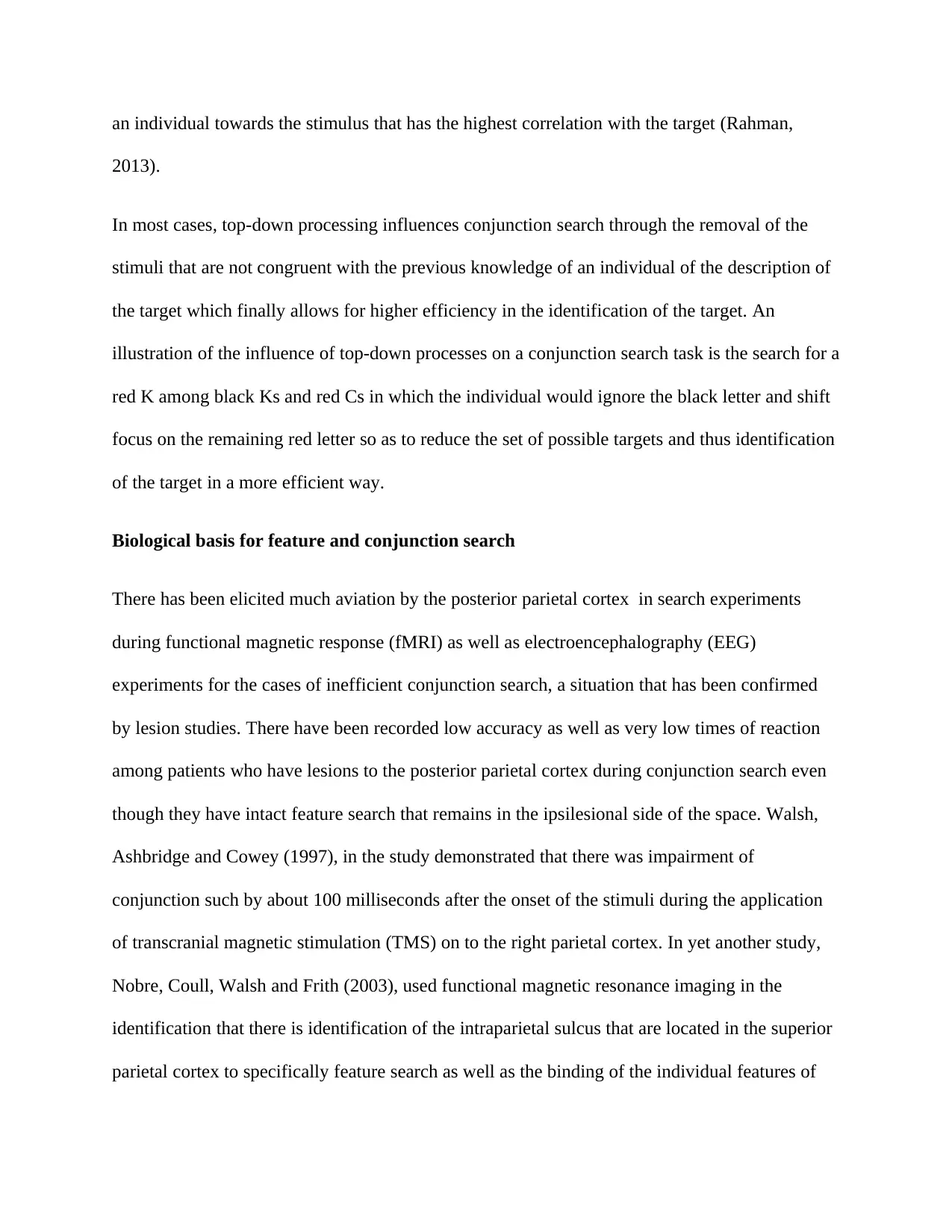
an individual towards the stimulus that has the highest correlation with the target (Rahman,
2013).
In most cases, top-down processing influences conjunction search through the removal of the
stimuli that are not congruent with the previous knowledge of an individual of the description of
the target which finally allows for higher efficiency in the identification of the target. An
illustration of the influence of top-down processes on a conjunction search task is the search for a
red K among black Ks and red Cs in which the individual would ignore the black letter and shift
focus on the remaining red letter so as to reduce the set of possible targets and thus identification
of the target in a more efficient way.
Biological basis for feature and conjunction search
There has been elicited much aviation by the posterior parietal cortex in search experiments
during functional magnetic response (fMRI) as well as electroencephalography (EEG)
experiments for the cases of inefficient conjunction search, a situation that has been confirmed
by lesion studies. There have been recorded low accuracy as well as very low times of reaction
among patients who have lesions to the posterior parietal cortex during conjunction search even
though they have intact feature search that remains in the ipsilesional side of the space. Walsh,
Ashbridge and Cowey (1997), in the study demonstrated that there was impairment of
conjunction such by about 100 milliseconds after the onset of the stimuli during the application
of transcranial magnetic stimulation (TMS) on to the right parietal cortex. In yet another study,
Nobre, Coull, Walsh and Frith (2003), used functional magnetic resonance imaging in the
identification that there is identification of the intraparietal sulcus that are located in the superior
parietal cortex to specifically feature search as well as the binding of the individual features of
2013).
In most cases, top-down processing influences conjunction search through the removal of the
stimuli that are not congruent with the previous knowledge of an individual of the description of
the target which finally allows for higher efficiency in the identification of the target. An
illustration of the influence of top-down processes on a conjunction search task is the search for a
red K among black Ks and red Cs in which the individual would ignore the black letter and shift
focus on the remaining red letter so as to reduce the set of possible targets and thus identification
of the target in a more efficient way.
Biological basis for feature and conjunction search
There has been elicited much aviation by the posterior parietal cortex in search experiments
during functional magnetic response (fMRI) as well as electroencephalography (EEG)
experiments for the cases of inefficient conjunction search, a situation that has been confirmed
by lesion studies. There have been recorded low accuracy as well as very low times of reaction
among patients who have lesions to the posterior parietal cortex during conjunction search even
though they have intact feature search that remains in the ipsilesional side of the space. Walsh,
Ashbridge and Cowey (1997), in the study demonstrated that there was impairment of
conjunction such by about 100 milliseconds after the onset of the stimuli during the application
of transcranial magnetic stimulation (TMS) on to the right parietal cortex. In yet another study,
Nobre, Coull, Walsh and Frith (2003), used functional magnetic resonance imaging in the
identification that there is identification of the intraparietal sulcus that are located in the superior
parietal cortex to specifically feature search as well as the binding of the individual features of
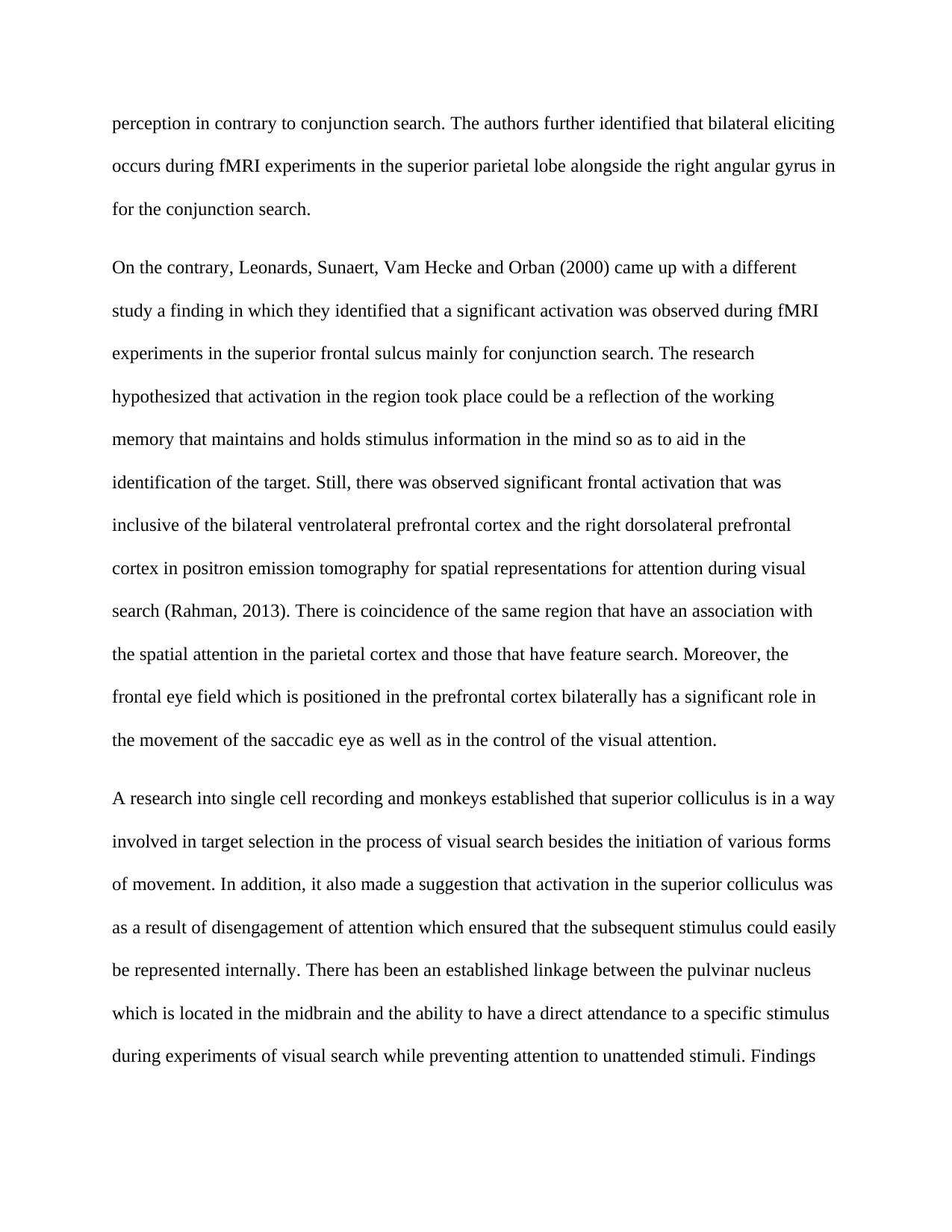
perception in contrary to conjunction search. The authors further identified that bilateral eliciting
occurs during fMRI experiments in the superior parietal lobe alongside the right angular gyrus in
for the conjunction search.
On the contrary, Leonards, Sunaert, Vam Hecke and Orban (2000) came up with a different
study a finding in which they identified that a significant activation was observed during fMRI
experiments in the superior frontal sulcus mainly for conjunction search. The research
hypothesized that activation in the region took place could be a reflection of the working
memory that maintains and holds stimulus information in the mind so as to aid in the
identification of the target. Still, there was observed significant frontal activation that was
inclusive of the bilateral ventrolateral prefrontal cortex and the right dorsolateral prefrontal
cortex in positron emission tomography for spatial representations for attention during visual
search (Rahman, 2013). There is coincidence of the same region that have an association with
the spatial attention in the parietal cortex and those that have feature search. Moreover, the
frontal eye field which is positioned in the prefrontal cortex bilaterally has a significant role in
the movement of the saccadic eye as well as in the control of the visual attention.
A research into single cell recording and monkeys established that superior colliculus is in a way
involved in target selection in the process of visual search besides the initiation of various forms
of movement. In addition, it also made a suggestion that activation in the superior colliculus was
as a result of disengagement of attention which ensured that the subsequent stimulus could easily
be represented internally. There has been an established linkage between the pulvinar nucleus
which is located in the midbrain and the ability to have a direct attendance to a specific stimulus
during experiments of visual search while preventing attention to unattended stimuli. Findings
occurs during fMRI experiments in the superior parietal lobe alongside the right angular gyrus in
for the conjunction search.
On the contrary, Leonards, Sunaert, Vam Hecke and Orban (2000) came up with a different
study a finding in which they identified that a significant activation was observed during fMRI
experiments in the superior frontal sulcus mainly for conjunction search. The research
hypothesized that activation in the region took place could be a reflection of the working
memory that maintains and holds stimulus information in the mind so as to aid in the
identification of the target. Still, there was observed significant frontal activation that was
inclusive of the bilateral ventrolateral prefrontal cortex and the right dorsolateral prefrontal
cortex in positron emission tomography for spatial representations for attention during visual
search (Rahman, 2013). There is coincidence of the same region that have an association with
the spatial attention in the parietal cortex and those that have feature search. Moreover, the
frontal eye field which is positioned in the prefrontal cortex bilaterally has a significant role in
the movement of the saccadic eye as well as in the control of the visual attention.
A research into single cell recording and monkeys established that superior colliculus is in a way
involved in target selection in the process of visual search besides the initiation of various forms
of movement. In addition, it also made a suggestion that activation in the superior colliculus was
as a result of disengagement of attention which ensured that the subsequent stimulus could easily
be represented internally. There has been an established linkage between the pulvinar nucleus
which is located in the midbrain and the ability to have a direct attendance to a specific stimulus
during experiments of visual search while preventing attention to unattended stimuli. Findings
Secure Best Marks with AI Grader
Need help grading? Try our AI Grader for instant feedback on your assignments.
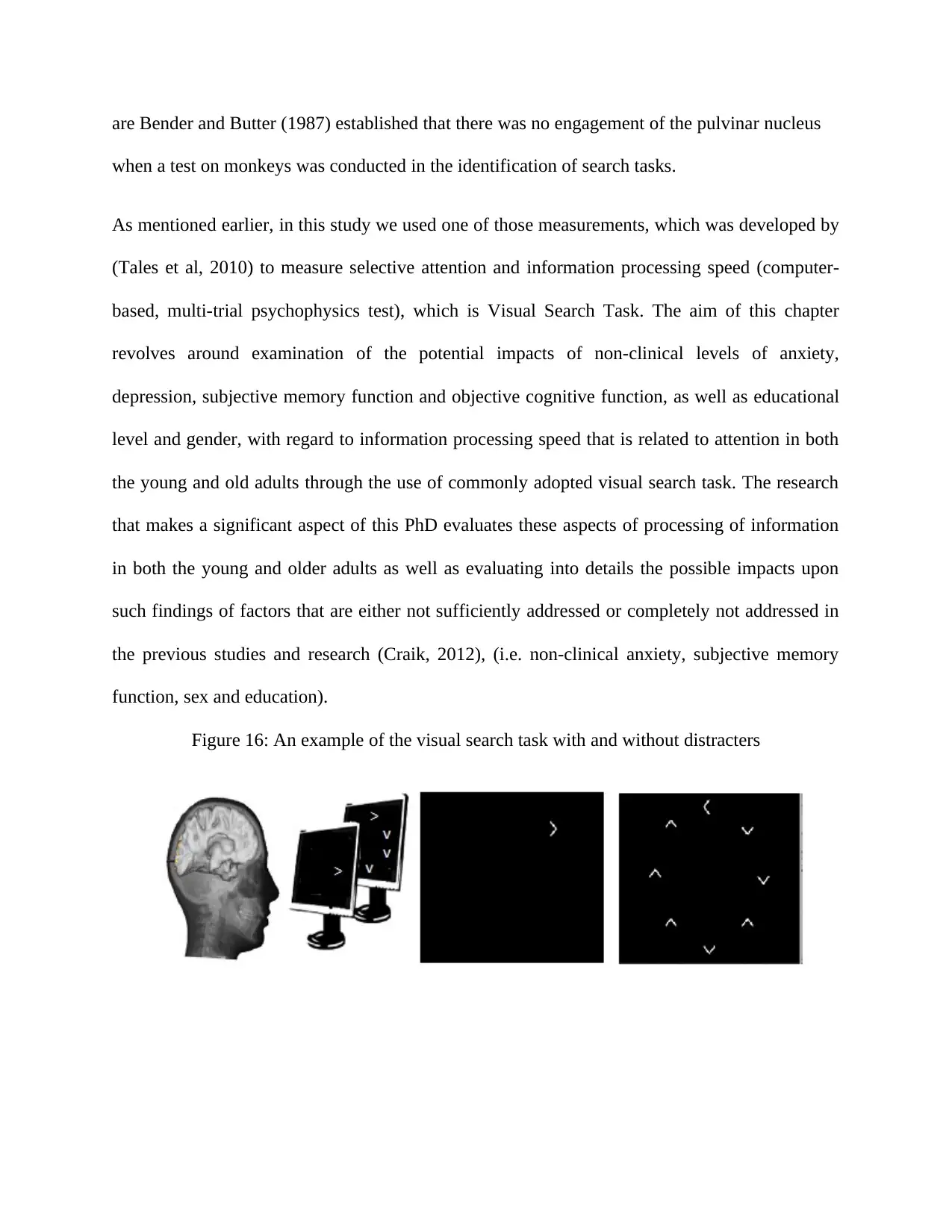
are Bender and Butter (1987) established that there was no engagement of the pulvinar nucleus
when a test on monkeys was conducted in the identification of search tasks.
As mentioned earlier, in this study we used one of those measurements, which was developed by
(Tales et al, 2010) to measure selective attention and information processing speed (computer-
based, multi-trial psychophysics test), which is Visual Search Task. The aim of this chapter
revolves around examination of the potential impacts of non-clinical levels of anxiety,
depression, subjective memory function and objective cognitive function, as well as educational
level and gender, with regard to information processing speed that is related to attention in both
the young and old adults through the use of commonly adopted visual search task. The research
that makes a significant aspect of this PhD evaluates these aspects of processing of information
in both the young and older adults as well as evaluating into details the possible impacts upon
such findings of factors that are either not sufficiently addressed or completely not addressed in
the previous studies and research (Craik, 2012), (i.e. non-clinical anxiety, subjective memory
function, sex and education).
Figure 16: An example of the visual search task with and without distracters
when a test on monkeys was conducted in the identification of search tasks.
As mentioned earlier, in this study we used one of those measurements, which was developed by
(Tales et al, 2010) to measure selective attention and information processing speed (computer-
based, multi-trial psychophysics test), which is Visual Search Task. The aim of this chapter
revolves around examination of the potential impacts of non-clinical levels of anxiety,
depression, subjective memory function and objective cognitive function, as well as educational
level and gender, with regard to information processing speed that is related to attention in both
the young and old adults through the use of commonly adopted visual search task. The research
that makes a significant aspect of this PhD evaluates these aspects of processing of information
in both the young and older adults as well as evaluating into details the possible impacts upon
such findings of factors that are either not sufficiently addressed or completely not addressed in
the previous studies and research (Craik, 2012), (i.e. non-clinical anxiety, subjective memory
function, sex and education).
Figure 16: An example of the visual search task with and without distracters
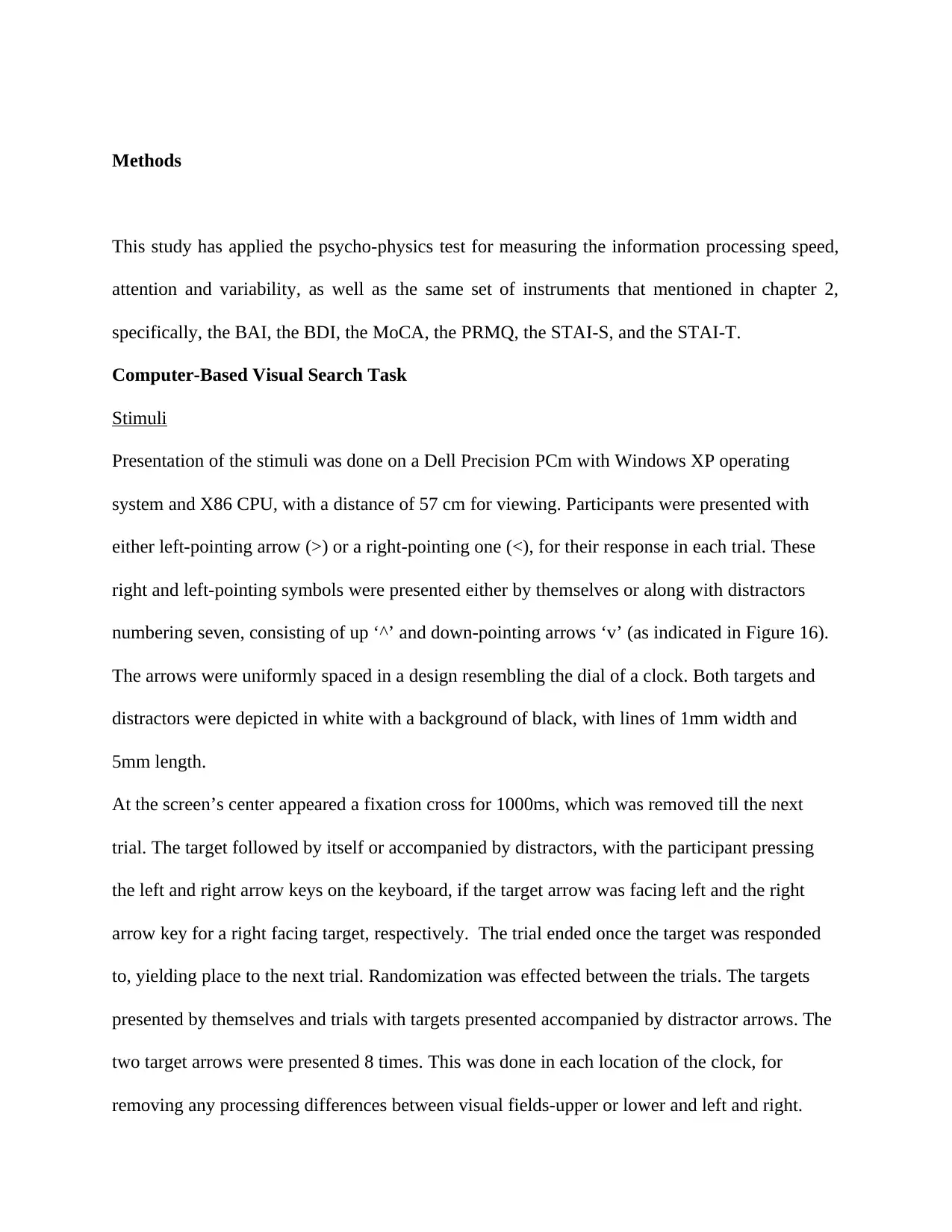
Methods
This study has applied the psycho-physics test for measuring the information processing speed,
attention and variability, as well as the same set of instruments that mentioned in chapter 2,
specifically, the BAI, the BDI, the MoCA, the PRMQ, the STAI-S, and the STAI-T.
Computer-Based Visual Search Task
Stimuli
Presentation of the stimuli was done on a Dell Precision PCm with Windows XP operating
system and X86 CPU, with a distance of 57 cm for viewing. Participants were presented with
either left-pointing arrow (>) or a right-pointing one (<), for their response in each trial. These
right and left-pointing symbols were presented either by themselves or along with distractors
numbering seven, consisting of up ‘^’ and down-pointing arrows ‘v’ (as indicated in Figure 16).
The arrows were uniformly spaced in a design resembling the dial of a clock. Both targets and
distractors were depicted in white with a background of black, with lines of 1mm width and
5mm length.
At the screen’s center appeared a fixation cross for 1000ms, which was removed till the next
trial. The target followed by itself or accompanied by distractors, with the participant pressing
the left and right arrow keys on the keyboard, if the target arrow was facing left and the right
arrow key for a right facing target, respectively. The trial ended once the target was responded
to, yielding place to the next trial. Randomization was effected between the trials. The targets
presented by themselves and trials with targets presented accompanied by distractor arrows. The
two target arrows were presented 8 times. This was done in each location of the clock, for
removing any processing differences between visual fields-upper or lower and left and right.
This study has applied the psycho-physics test for measuring the information processing speed,
attention and variability, as well as the same set of instruments that mentioned in chapter 2,
specifically, the BAI, the BDI, the MoCA, the PRMQ, the STAI-S, and the STAI-T.
Computer-Based Visual Search Task
Stimuli
Presentation of the stimuli was done on a Dell Precision PCm with Windows XP operating
system and X86 CPU, with a distance of 57 cm for viewing. Participants were presented with
either left-pointing arrow (>) or a right-pointing one (<), for their response in each trial. These
right and left-pointing symbols were presented either by themselves or along with distractors
numbering seven, consisting of up ‘^’ and down-pointing arrows ‘v’ (as indicated in Figure 16).
The arrows were uniformly spaced in a design resembling the dial of a clock. Both targets and
distractors were depicted in white with a background of black, with lines of 1mm width and
5mm length.
At the screen’s center appeared a fixation cross for 1000ms, which was removed till the next
trial. The target followed by itself or accompanied by distractors, with the participant pressing
the left and right arrow keys on the keyboard, if the target arrow was facing left and the right
arrow key for a right facing target, respectively. The trial ended once the target was responded
to, yielding place to the next trial. Randomization was effected between the trials. The targets
presented by themselves and trials with targets presented accompanied by distractor arrows. The
two target arrows were presented 8 times. This was done in each location of the clock, for
removing any processing differences between visual fields-upper or lower and left and right.
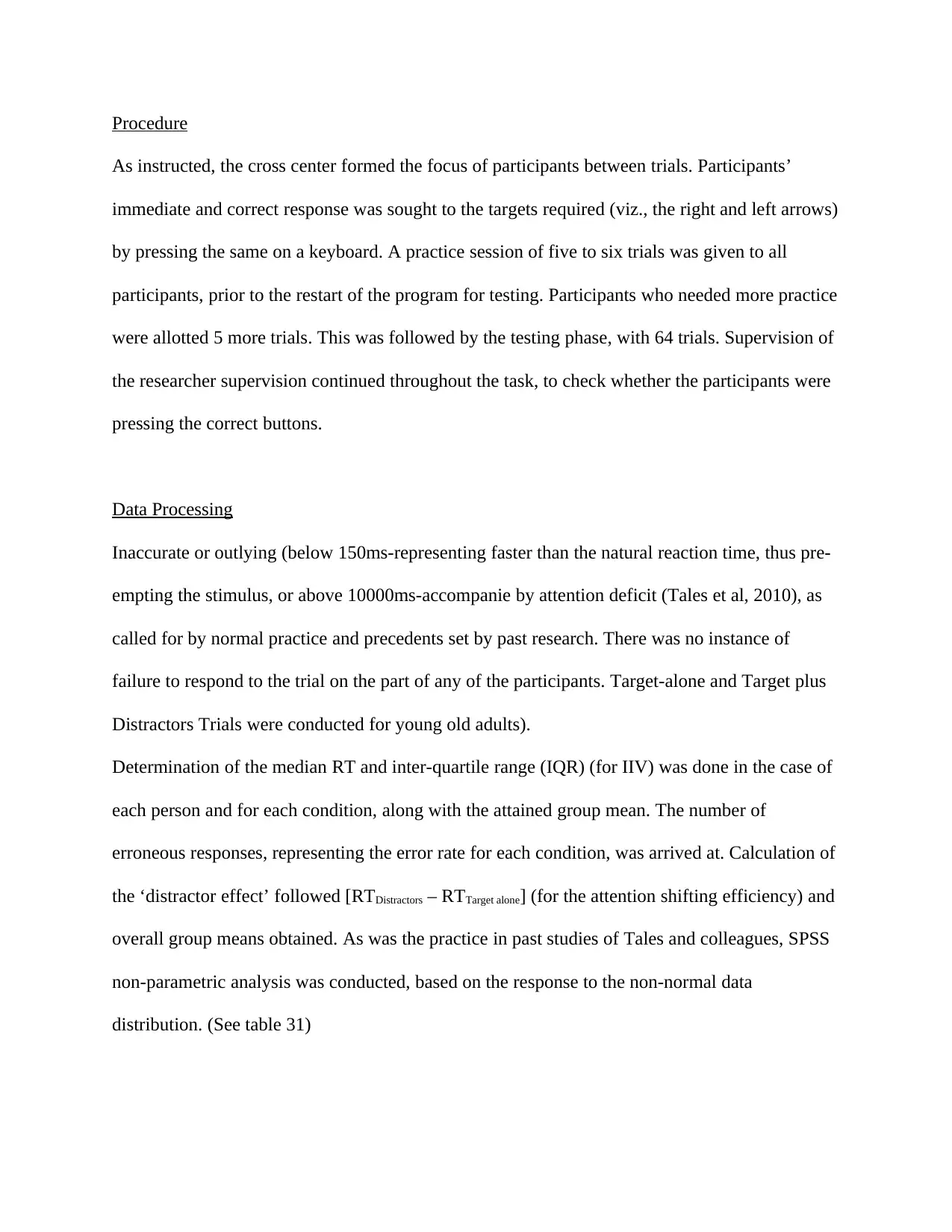
Procedure
As instructed, the cross center formed the focus of participants between trials. Participants’
immediate and correct response was sought to the targets required (viz., the right and left arrows)
by pressing the same on a keyboard. A practice session of five to six trials was given to all
participants, prior to the restart of the program for testing. Participants who needed more practice
were allotted 5 more trials. This was followed by the testing phase, with 64 trials. Supervision of
the researcher supervision continued throughout the task, to check whether the participants were
pressing the correct buttons.
Data Processing
Inaccurate or outlying (below 150ms-representing faster than the natural reaction time, thus pre-
empting the stimulus, or above 10000ms-accompanie by attention deficit (Tales et al, 2010), as
called for by normal practice and precedents set by past research. There was no instance of
failure to respond to the trial on the part of any of the participants. Target-alone and Target plus
Distractors Trials were conducted for young old adults).
Determination of the median RT and inter-quartile range (IQR) (for IIV) was done in the case of
each person and for each condition, along with the attained group mean. The number of
erroneous responses, representing the error rate for each condition, was arrived at. Calculation of
the ‘distractor effect’ followed [RTDistractors – RTTarget alone] (for the attention shifting efficiency) and
overall group means obtained. As was the practice in past studies of Tales and colleagues, SPSS
non-parametric analysis was conducted, based on the response to the non-normal data
distribution. (See table 31)
As instructed, the cross center formed the focus of participants between trials. Participants’
immediate and correct response was sought to the targets required (viz., the right and left arrows)
by pressing the same on a keyboard. A practice session of five to six trials was given to all
participants, prior to the restart of the program for testing. Participants who needed more practice
were allotted 5 more trials. This was followed by the testing phase, with 64 trials. Supervision of
the researcher supervision continued throughout the task, to check whether the participants were
pressing the correct buttons.
Data Processing
Inaccurate or outlying (below 150ms-representing faster than the natural reaction time, thus pre-
empting the stimulus, or above 10000ms-accompanie by attention deficit (Tales et al, 2010), as
called for by normal practice and precedents set by past research. There was no instance of
failure to respond to the trial on the part of any of the participants. Target-alone and Target plus
Distractors Trials were conducted for young old adults).
Determination of the median RT and inter-quartile range (IQR) (for IIV) was done in the case of
each person and for each condition, along with the attained group mean. The number of
erroneous responses, representing the error rate for each condition, was arrived at. Calculation of
the ‘distractor effect’ followed [RTDistractors – RTTarget alone] (for the attention shifting efficiency) and
overall group means obtained. As was the practice in past studies of Tales and colleagues, SPSS
non-parametric analysis was conducted, based on the response to the non-normal data
distribution. (See table 31)
Paraphrase This Document
Need a fresh take? Get an instant paraphrase of this document with our AI Paraphraser
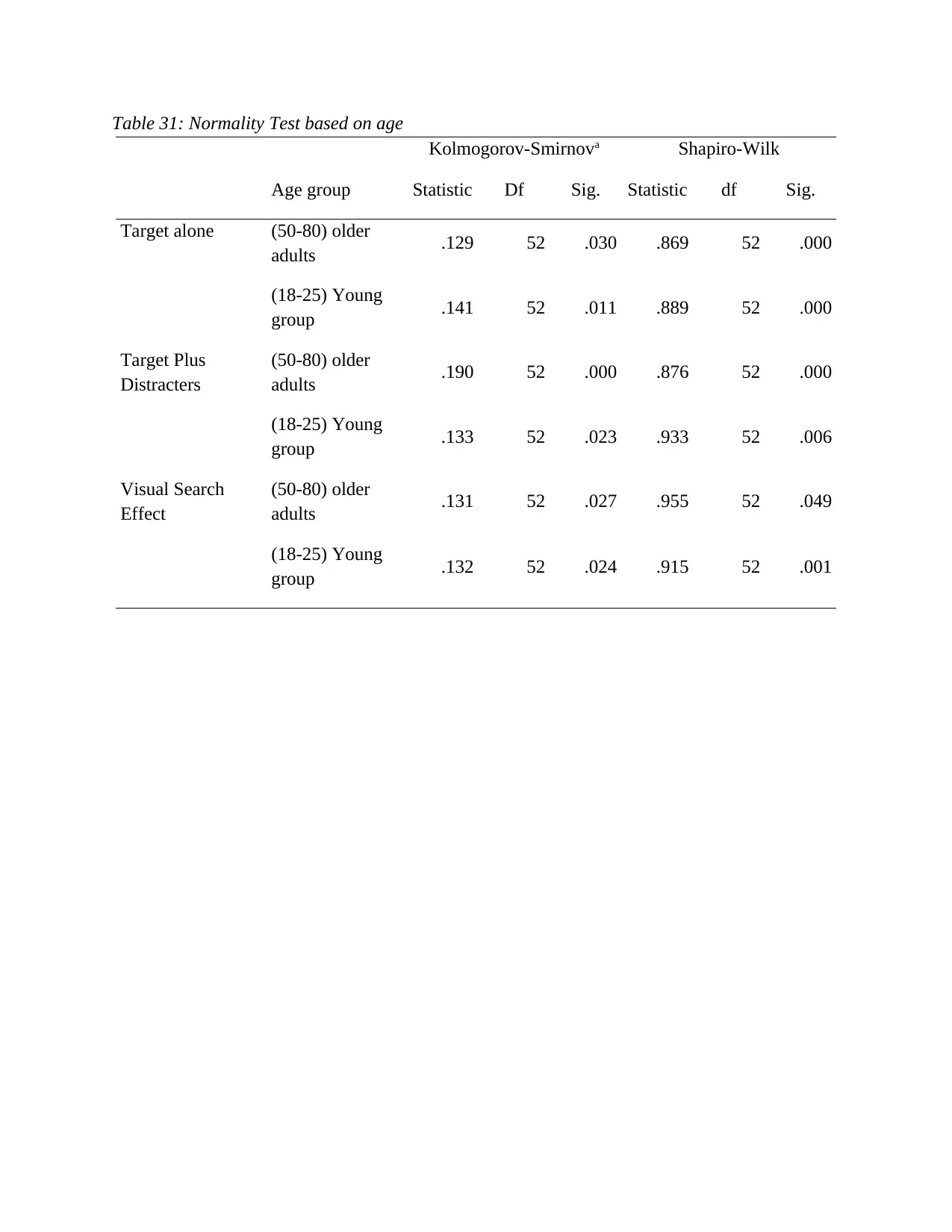
Table 31: Normality Test based on age
Age group
Kolmogorov-Smirnova Shapiro-Wilk
Statistic Df Sig. Statistic df Sig.
Target alone (50-80) older
adults .129 52 .030 .869 52 .000
(18-25) Young
group .141 52 .011 .889 52 .000
Target Plus
Distracters
(50-80) older
adults .190 52 .000 .876 52 .000
(18-25) Young
group .133 52 .023 .933 52 .006
Visual Search
Effect
(50-80) older
adults .131 52 .027 .955 52 .049
(18-25) Young
group .132 52 .024 .915 52 .001
Age group
Kolmogorov-Smirnova Shapiro-Wilk
Statistic Df Sig. Statistic df Sig.
Target alone (50-80) older
adults .129 52 .030 .869 52 .000
(18-25) Young
group .141 52 .011 .889 52 .000
Target Plus
Distracters
(50-80) older
adults .190 52 .000 .876 52 .000
(18-25) Young
group .133 52 .023 .933 52 .006
Visual Search
Effect
(50-80) older
adults .131 52 .027 .955 52 .049
(18-25) Young
group .132 52 .024 .915 52 .001

Results
Visual search task: Information processing speed as per age group
Age comparison
The average information processing speed for the visual target alone RT in older adults was
982.40 (SD=384.33) while that for the young group was 798.81 (SD=262.42). The average
information processing speed for visual target + distracters RT was 1618.96 (SD=394.69) in
older adults and 1344.21 (SD=223.31) in the young group as illustrated in figure 17. The average
visual search effect was 635.56 (SD=204.46) in older adults which was higher than that in the
younger group 545.40 (SD=192.23) as illustrated in figure 18. Generally, the speed in the older
group is faster than the younger group in all the conditions.
Figure 17: Box plot of mean for visual task conditions (Age differences)
Figure 18: Simple scatter of mean for visual task effect (Age differences)
Visual search task: Information processing speed as per age group
Age comparison
The average information processing speed for the visual target alone RT in older adults was
982.40 (SD=384.33) while that for the young group was 798.81 (SD=262.42). The average
information processing speed for visual target + distracters RT was 1618.96 (SD=394.69) in
older adults and 1344.21 (SD=223.31) in the young group as illustrated in figure 17. The average
visual search effect was 635.56 (SD=204.46) in older adults which was higher than that in the
younger group 545.40 (SD=192.23) as illustrated in figure 18. Generally, the speed in the older
group is faster than the younger group in all the conditions.
Figure 17: Box plot of mean for visual task conditions (Age differences)
Figure 18: Simple scatter of mean for visual task effect (Age differences)
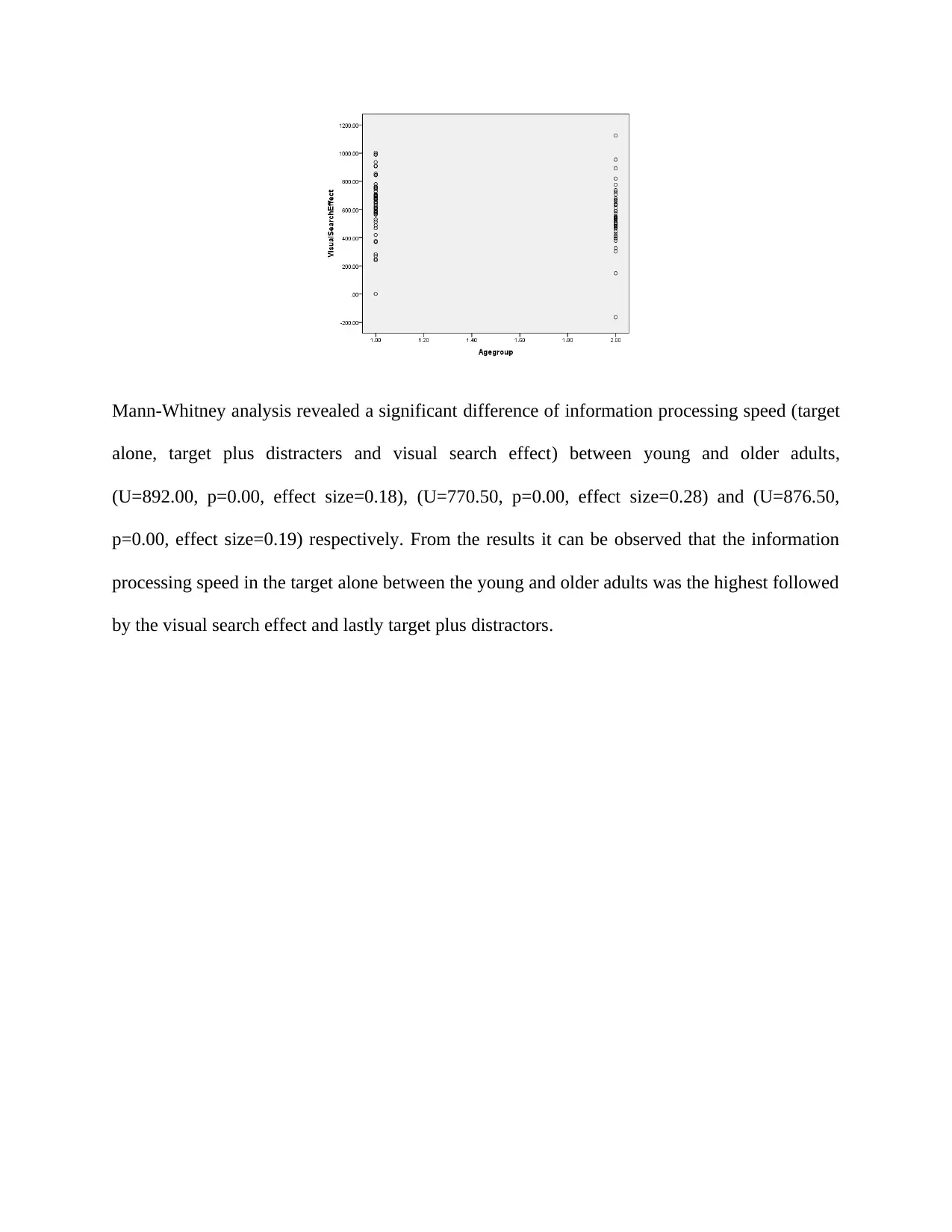
Mann-Whitney analysis revealed a significant difference of information processing speed (target
alone, target plus distracters and visual search effect) between young and older adults,
(U=892.00, p=0.00, effect size=0.18), (U=770.50, p=0.00, effect size=0.28) and (U=876.50,
p=0.00, effect size=0.19) respectively. From the results it can be observed that the information
processing speed in the target alone between the young and older adults was the highest followed
by the visual search effect and lastly target plus distractors.
alone, target plus distracters and visual search effect) between young and older adults,
(U=892.00, p=0.00, effect size=0.18), (U=770.50, p=0.00, effect size=0.28) and (U=876.50,
p=0.00, effect size=0.19) respectively. From the results it can be observed that the information
processing speed in the target alone between the young and older adults was the highest followed
by the visual search effect and lastly target plus distractors.
Secure Best Marks with AI Grader
Need help grading? Try our AI Grader for instant feedback on your assignments.
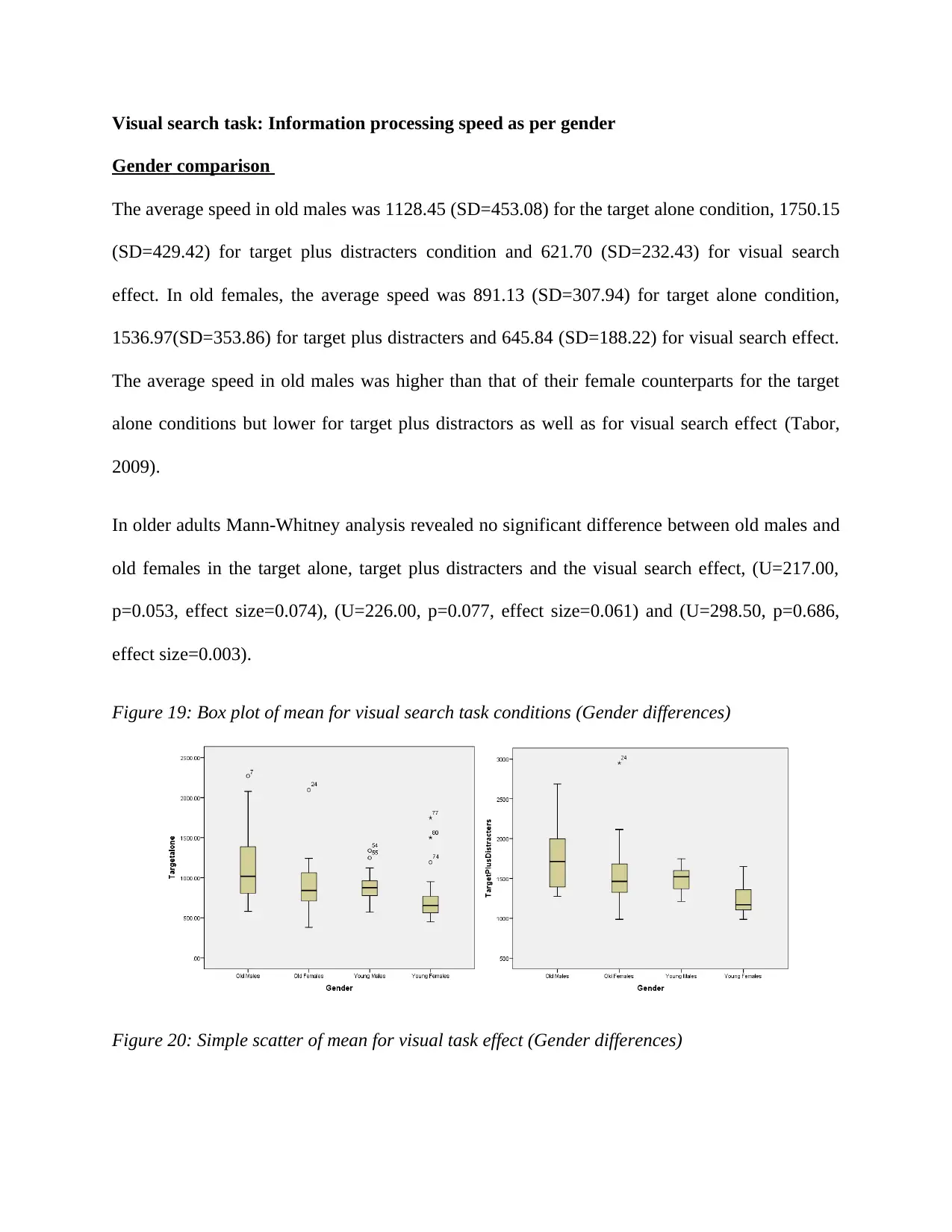
Visual search task: Information processing speed as per gender
Gender comparison
The average speed in old males was 1128.45 (SD=453.08) for the target alone condition, 1750.15
(SD=429.42) for target plus distracters condition and 621.70 (SD=232.43) for visual search
effect. In old females, the average speed was 891.13 (SD=307.94) for target alone condition,
1536.97(SD=353.86) for target plus distracters and 645.84 (SD=188.22) for visual search effect.
The average speed in old males was higher than that of their female counterparts for the target
alone conditions but lower for target plus distractors as well as for visual search effect (Tabor,
2009).
In older adults Mann-Whitney analysis revealed no significant difference between old males and
old females in the target alone, target plus distracters and the visual search effect, (U=217.00,
p=0.053, effect size=0.074), (U=226.00, p=0.077, effect size=0.061) and (U=298.50, p=0.686,
effect size=0.003).
Figure 19: Box plot of mean for visual search task conditions (Gender differences)
Figure 20: Simple scatter of mean for visual task effect (Gender differences)
Gender comparison
The average speed in old males was 1128.45 (SD=453.08) for the target alone condition, 1750.15
(SD=429.42) for target plus distracters condition and 621.70 (SD=232.43) for visual search
effect. In old females, the average speed was 891.13 (SD=307.94) for target alone condition,
1536.97(SD=353.86) for target plus distracters and 645.84 (SD=188.22) for visual search effect.
The average speed in old males was higher than that of their female counterparts for the target
alone conditions but lower for target plus distractors as well as for visual search effect (Tabor,
2009).
In older adults Mann-Whitney analysis revealed no significant difference between old males and
old females in the target alone, target plus distracters and the visual search effect, (U=217.00,
p=0.053, effect size=0.074), (U=226.00, p=0.077, effect size=0.061) and (U=298.50, p=0.686,
effect size=0.003).
Figure 19: Box plot of mean for visual search task conditions (Gender differences)
Figure 20: Simple scatter of mean for visual task effect (Gender differences)
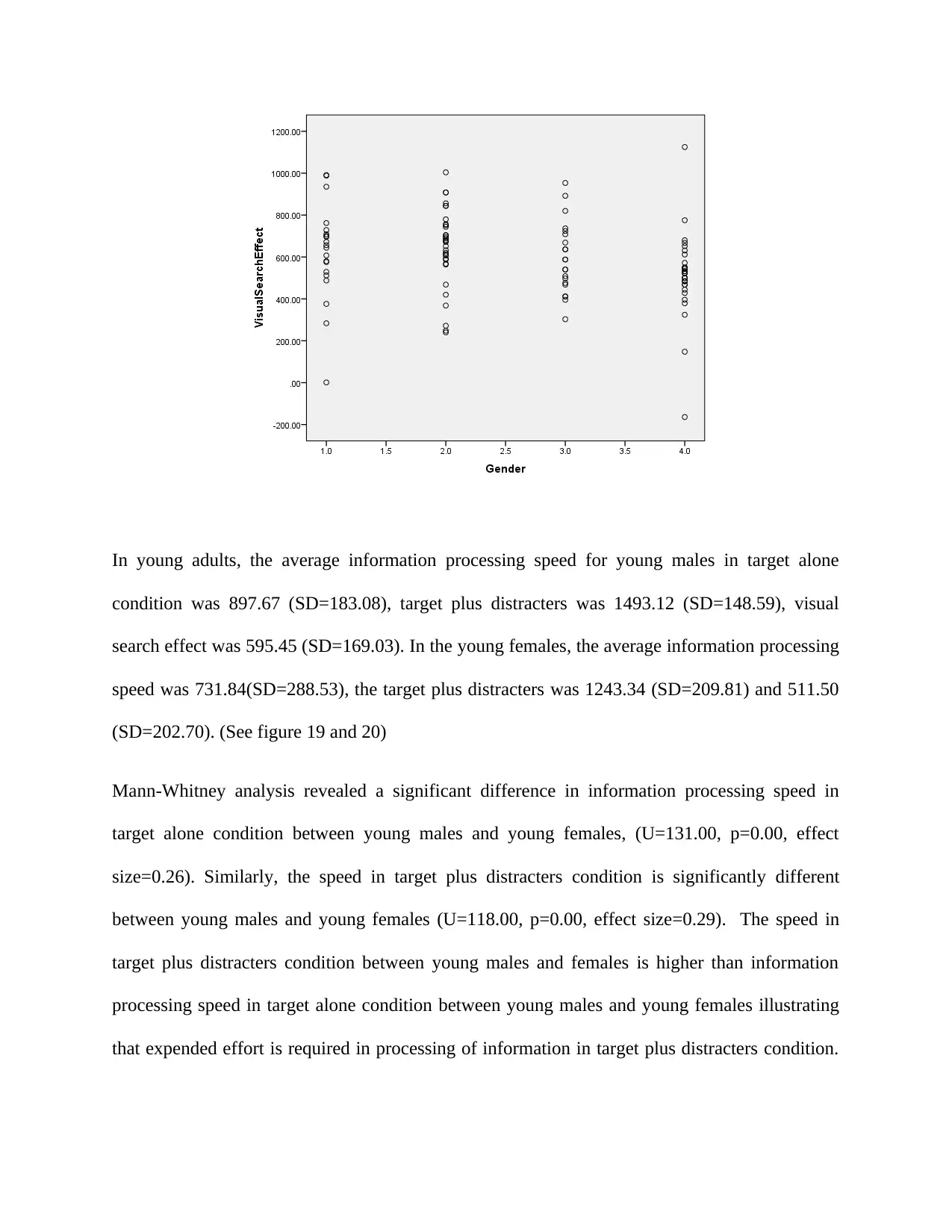
In young adults, the average information processing speed for young males in target alone
condition was 897.67 (SD=183.08), target plus distracters was 1493.12 (SD=148.59), visual
search effect was 595.45 (SD=169.03). In the young females, the average information processing
speed was 731.84(SD=288.53), the target plus distracters was 1243.34 (SD=209.81) and 511.50
(SD=202.70). (See figure 19 and 20)
Mann-Whitney analysis revealed a significant difference in information processing speed in
target alone condition between young males and young females, (U=131.00, p=0.00, effect
size=0.26). Similarly, the speed in target plus distracters condition is significantly different
between young males and young females (U=118.00, p=0.00, effect size=0.29). The speed in
target plus distracters condition between young males and females is higher than information
processing speed in target alone condition between young males and young females illustrating
that expended effort is required in processing of information in target plus distracters condition.
condition was 897.67 (SD=183.08), target plus distracters was 1493.12 (SD=148.59), visual
search effect was 595.45 (SD=169.03). In the young females, the average information processing
speed was 731.84(SD=288.53), the target plus distracters was 1243.34 (SD=209.81) and 511.50
(SD=202.70). (See figure 19 and 20)
Mann-Whitney analysis revealed a significant difference in information processing speed in
target alone condition between young males and young females, (U=131.00, p=0.00, effect
size=0.26). Similarly, the speed in target plus distracters condition is significantly different
between young males and young females (U=118.00, p=0.00, effect size=0.29). The speed in
target plus distracters condition between young males and females is higher than information
processing speed in target alone condition between young males and young females illustrating
that expended effort is required in processing of information in target plus distracters condition.
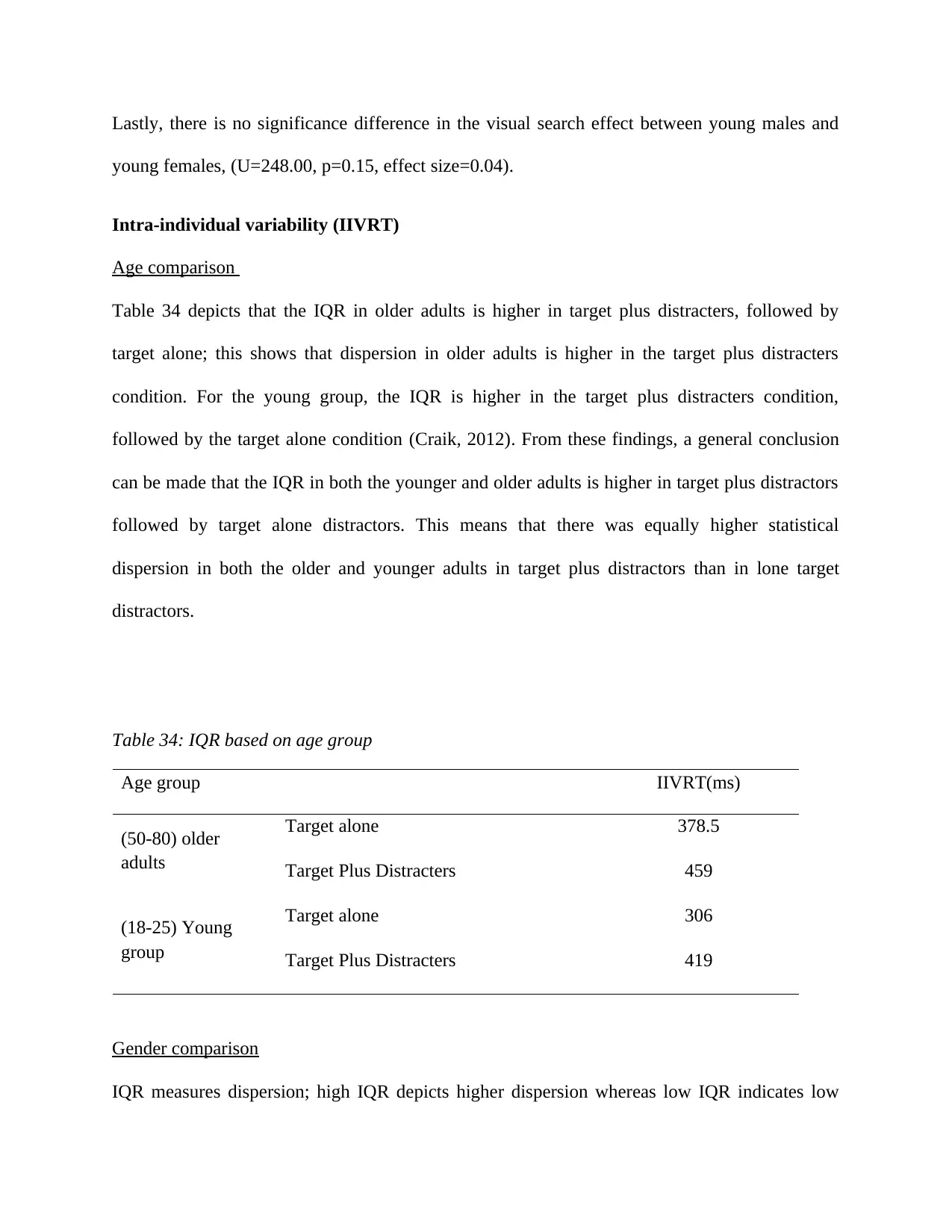
Lastly, there is no significance difference in the visual search effect between young males and
young females, (U=248.00, p=0.15, effect size=0.04).
Intra-individual variability (IIVRT)
Age comparison
Table 34 depicts that the IQR in older adults is higher in target plus distracters, followed by
target alone; this shows that dispersion in older adults is higher in the target plus distracters
condition. For the young group, the IQR is higher in the target plus distracters condition,
followed by the target alone condition (Craik, 2012). From these findings, a general conclusion
can be made that the IQR in both the younger and older adults is higher in target plus distractors
followed by target alone distractors. This means that there was equally higher statistical
dispersion in both the older and younger adults in target plus distractors than in lone target
distractors.
Table 34: IQR based on age group
Age group IIVRT(ms)
(50-80) older
adults
Target alone 378.5
Target Plus Distracters 459
(18-25) Young
group
Target alone 306
Target Plus Distracters 419
Gender comparison
IQR measures dispersion; high IQR depicts higher dispersion whereas low IQR indicates low
young females, (U=248.00, p=0.15, effect size=0.04).
Intra-individual variability (IIVRT)
Age comparison
Table 34 depicts that the IQR in older adults is higher in target plus distracters, followed by
target alone; this shows that dispersion in older adults is higher in the target plus distracters
condition. For the young group, the IQR is higher in the target plus distracters condition,
followed by the target alone condition (Craik, 2012). From these findings, a general conclusion
can be made that the IQR in both the younger and older adults is higher in target plus distractors
followed by target alone distractors. This means that there was equally higher statistical
dispersion in both the older and younger adults in target plus distractors than in lone target
distractors.
Table 34: IQR based on age group
Age group IIVRT(ms)
(50-80) older
adults
Target alone 378.5
Target Plus Distracters 459
(18-25) Young
group
Target alone 306
Target Plus Distracters 419
Gender comparison
IQR measures dispersion; high IQR depicts higher dispersion whereas low IQR indicates low
Paraphrase This Document
Need a fresh take? Get an instant paraphrase of this document with our AI Paraphraser

dispersion. Table 35 indicates that the IQR was higher in target plus distracters, followed by the
target alone condition in old males. In old females, IQR was higher in the target plus distracters,
followed by the target alone condition. In young males, the IQR was higher in target plus
distracters, followed by the target alone condition. Finally, in young females, the IQR was high
in target plus distracters followed by target alone condition. Therefore, dispersion was high in
target plus distracters. From these findings, a general conclusion can be made that the IQR in
both the males and females of all age groups is higher in target plus distractors followed by
target alone distractors (Rahman, 2013). This means that there was equally higher statistical
dispersion in both the genders in target plus distractors than in lone target distractors.
Table 35: IQR based on gender
Gender IIVRT(ms)
Old Males
Target alone 600.5
Target Plus Distracters 612
Old Females
Target alone 373
Target Plus Distracters 371
Young Males
Target alone 203.5
Target Plus Distracters 241
Young Females
Target alone 237
Target Plus Distracters 294
Errors in visual search
Age comparison
target alone condition in old males. In old females, IQR was higher in the target plus distracters,
followed by the target alone condition. In young males, the IQR was higher in target plus
distracters, followed by the target alone condition. Finally, in young females, the IQR was high
in target plus distracters followed by target alone condition. Therefore, dispersion was high in
target plus distracters. From these findings, a general conclusion can be made that the IQR in
both the males and females of all age groups is higher in target plus distractors followed by
target alone distractors (Rahman, 2013). This means that there was equally higher statistical
dispersion in both the genders in target plus distractors than in lone target distractors.
Table 35: IQR based on gender
Gender IIVRT(ms)
Old Males
Target alone 600.5
Target Plus Distracters 612
Old Females
Target alone 373
Target Plus Distracters 371
Young Males
Target alone 203.5
Target Plus Distracters 241
Young Females
Target alone 237
Target Plus Distracters 294
Errors in visual search
Age comparison

The average errors in target alone in older adults was 0.0784 (SD=0.27) while in young adults
there were no errors. For the target plus distracters condition, the average errors in older adults
was 0.56(SD=1.09) while the younger adults had 0.21(SD=0.54). Thus, the older adults had
more errors than the younger adults.
There is a significant difference in target alone errors between the old and young groups,
(U=1222.00, p=0.04, effect size= 0.08) illustrating the inaccuracy in the equipment that was used
in conducting the test. For target plus distracters and the total errors, there was no significant
difference between the older and the young group, (U=1157.00, p=0.80, effect size= 0.06) and
(U=1147.00, p=0.69, effect size =0.06).
Gender comparison
In the target alone condition, the errors were higher in older females 0.94(SD=0.296), followed
by older males 0.053(SD=0.229); there was no error in young males and females. For the target
plus distracters, the average errors were high in older females 0.59 (SD=1.24), followed by older
males 0.50(SD=0.82), young males 0.33(SD=0.66) and finally young females 0.13(SD=0.43).
For the total errors, the average errors were high in older females 0.68 (SD=1.40), followed by
older males 0.55 (SD=0.88), young males 0.33(SD=0.66) and finally young females
0.12(SD=0.42) (Spielberger, 2013).
In older adults Mann-Whitney analysis revealed no significant difference in the target alone
errors, target plus distracters errors and the total error between old males and females (U=291.50,
p=0.601, effect size=0.01), (U=299.50, p=0.629, effect size=0.00) and (U=301.50, p=0.66, effect
size=0.00) respectively.
there were no errors. For the target plus distracters condition, the average errors in older adults
was 0.56(SD=1.09) while the younger adults had 0.21(SD=0.54). Thus, the older adults had
more errors than the younger adults.
There is a significant difference in target alone errors between the old and young groups,
(U=1222.00, p=0.04, effect size= 0.08) illustrating the inaccuracy in the equipment that was used
in conducting the test. For target plus distracters and the total errors, there was no significant
difference between the older and the young group, (U=1157.00, p=0.80, effect size= 0.06) and
(U=1147.00, p=0.69, effect size =0.06).
Gender comparison
In the target alone condition, the errors were higher in older females 0.94(SD=0.296), followed
by older males 0.053(SD=0.229); there was no error in young males and females. For the target
plus distracters, the average errors were high in older females 0.59 (SD=1.24), followed by older
males 0.50(SD=0.82), young males 0.33(SD=0.66) and finally young females 0.13(SD=0.43).
For the total errors, the average errors were high in older females 0.68 (SD=1.40), followed by
older males 0.55 (SD=0.88), young males 0.33(SD=0.66) and finally young females
0.12(SD=0.42) (Spielberger, 2013).
In older adults Mann-Whitney analysis revealed no significant difference in the target alone
errors, target plus distracters errors and the total error between old males and females (U=291.50,
p=0.601, effect size=0.01), (U=299.50, p=0.629, effect size=0.00) and (U=301.50, p=0.66, effect
size=0.00) respectively.
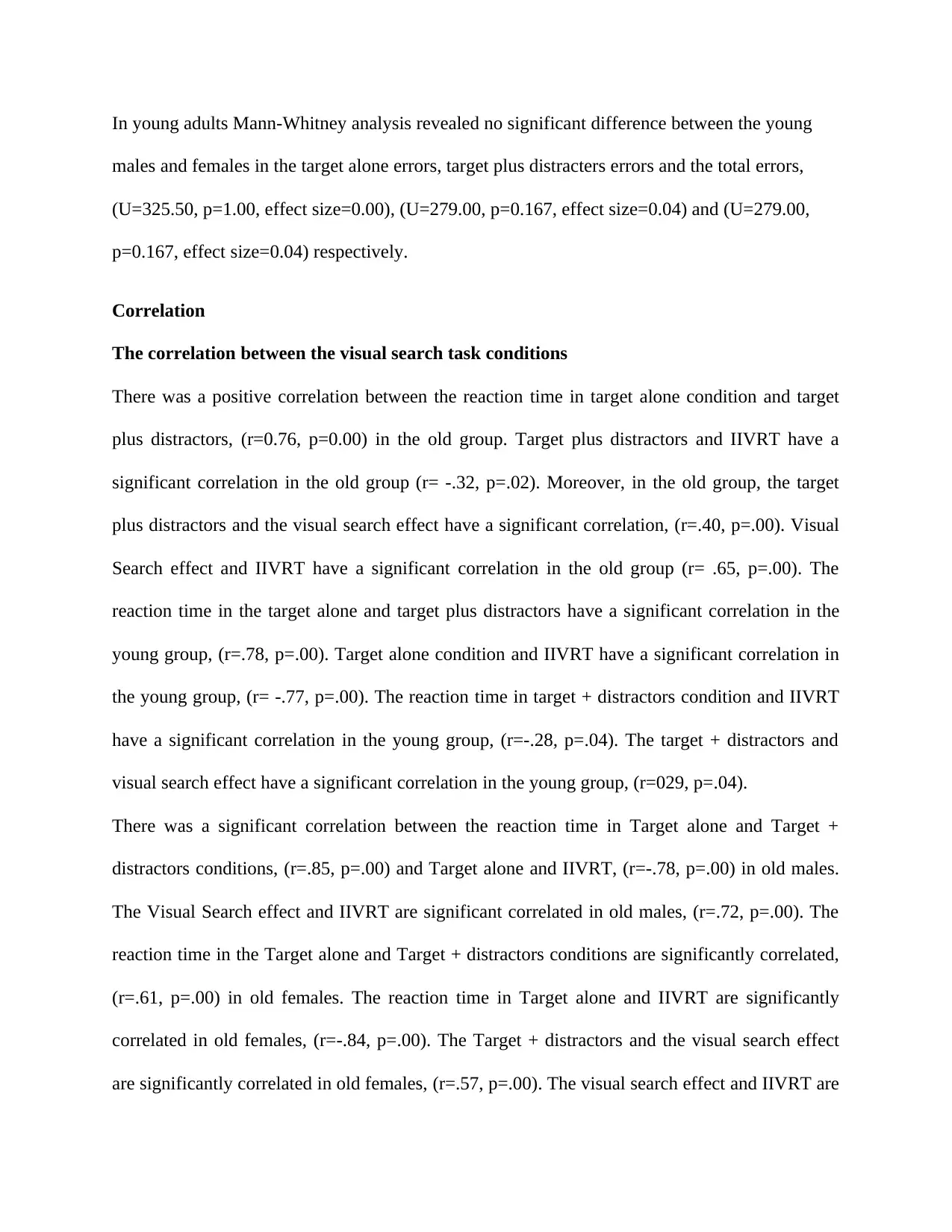
In young adults Mann-Whitney analysis revealed no significant difference between the young
males and females in the target alone errors, target plus distracters errors and the total errors,
(U=325.50, p=1.00, effect size=0.00), (U=279.00, p=0.167, effect size=0.04) and (U=279.00,
p=0.167, effect size=0.04) respectively.
Correlation
The correlation between the visual search task conditions
There was a positive correlation between the reaction time in target alone condition and target
plus distractors, (r=0.76, p=0.00) in the old group. Target plus distractors and IIVRT have a
significant correlation in the old group (r= -.32, p=.02). Moreover, in the old group, the target
plus distractors and the visual search effect have a significant correlation, (r=.40, p=.00). Visual
Search effect and IIVRT have a significant correlation in the old group (r= .65, p=.00). The
reaction time in the target alone and target plus distractors have a significant correlation in the
young group, (r=.78, p=.00). Target alone condition and IIVRT have a significant correlation in
the young group, (r= -.77, p=.00). The reaction time in target + distractors condition and IIVRT
have a significant correlation in the young group, (r=-.28, p=.04). The target + distractors and
visual search effect have a significant correlation in the young group, (r=029, p=.04).
There was a significant correlation between the reaction time in Target alone and Target +
distractors conditions, (r=.85, p=.00) and Target alone and IIVRT, (r=-.78, p=.00) in old males.
The Visual Search effect and IIVRT are significant correlated in old males, (r=.72, p=.00). The
reaction time in the Target alone and Target + distractors conditions are significantly correlated,
(r=.61, p=.00) in old females. The reaction time in Target alone and IIVRT are significantly
correlated in old females, (r=-.84, p=.00). The Target + distractors and the visual search effect
are significantly correlated in old females, (r=.57, p=.00). The visual search effect and IIVRT are
males and females in the target alone errors, target plus distracters errors and the total errors,
(U=325.50, p=1.00, effect size=0.00), (U=279.00, p=0.167, effect size=0.04) and (U=279.00,
p=0.167, effect size=0.04) respectively.
Correlation
The correlation between the visual search task conditions
There was a positive correlation between the reaction time in target alone condition and target
plus distractors, (r=0.76, p=0.00) in the old group. Target plus distractors and IIVRT have a
significant correlation in the old group (r= -.32, p=.02). Moreover, in the old group, the target
plus distractors and the visual search effect have a significant correlation, (r=.40, p=.00). Visual
Search effect and IIVRT have a significant correlation in the old group (r= .65, p=.00). The
reaction time in the target alone and target plus distractors have a significant correlation in the
young group, (r=.78, p=.00). Target alone condition and IIVRT have a significant correlation in
the young group, (r= -.77, p=.00). The reaction time in target + distractors condition and IIVRT
have a significant correlation in the young group, (r=-.28, p=.04). The target + distractors and
visual search effect have a significant correlation in the young group, (r=029, p=.04).
There was a significant correlation between the reaction time in Target alone and Target +
distractors conditions, (r=.85, p=.00) and Target alone and IIVRT, (r=-.78, p=.00) in old males.
The Visual Search effect and IIVRT are significant correlated in old males, (r=.72, p=.00). The
reaction time in the Target alone and Target + distractors conditions are significantly correlated,
(r=.61, p=.00) in old females. The reaction time in Target alone and IIVRT are significantly
correlated in old females, (r=-.84, p=.00). The Target + distractors and the visual search effect
are significantly correlated in old females, (r=.57, p=.00). The visual search effect and IIVRT are
Secure Best Marks with AI Grader
Need help grading? Try our AI Grader for instant feedback on your assignments.
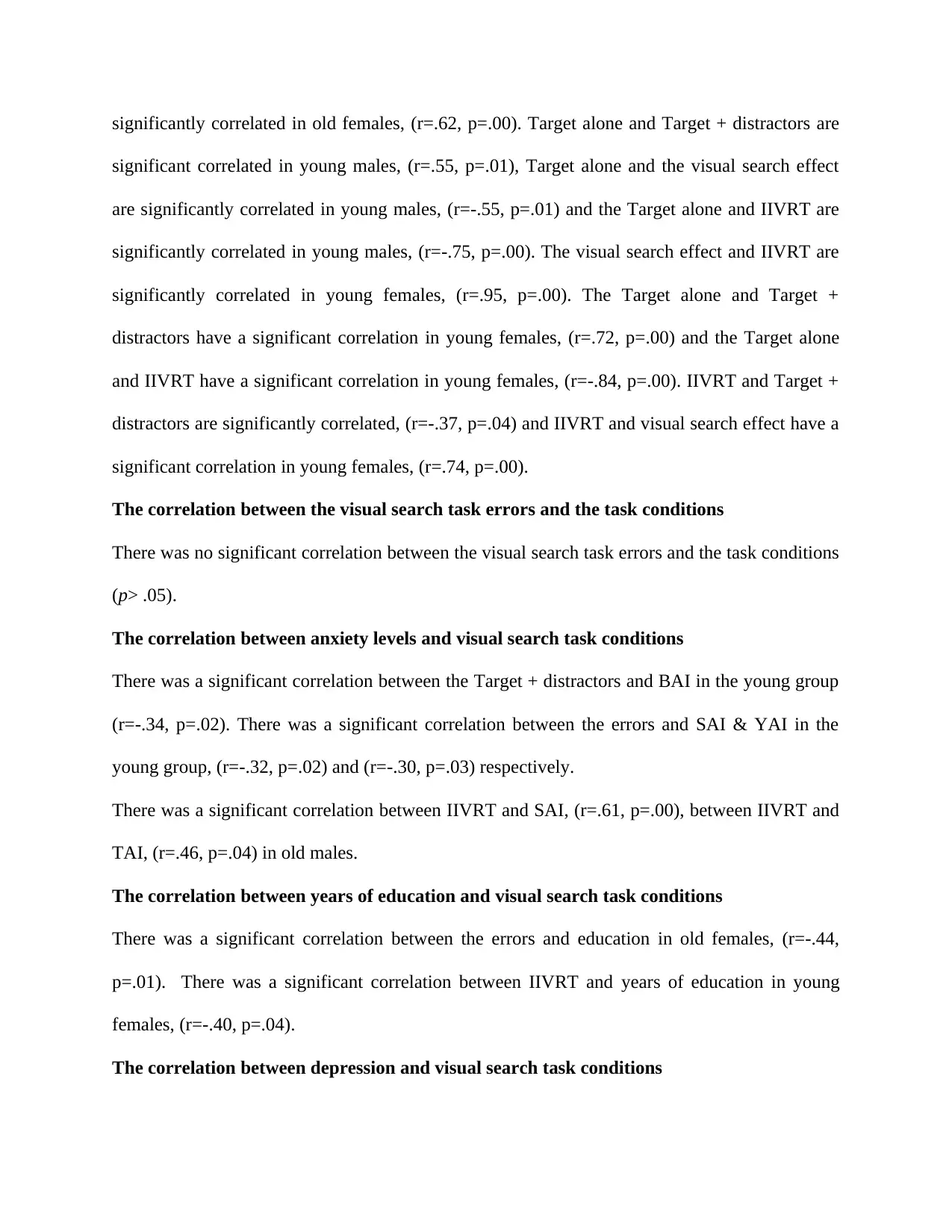
significantly correlated in old females, (r=.62, p=.00). Target alone and Target + distractors are
significant correlated in young males, (r=.55, p=.01), Target alone and the visual search effect
are significantly correlated in young males, (r=-.55, p=.01) and the Target alone and IIVRT are
significantly correlated in young males, (r=-.75, p=.00). The visual search effect and IIVRT are
significantly correlated in young females, (r=.95, p=.00). The Target alone and Target +
distractors have a significant correlation in young females, (r=.72, p=.00) and the Target alone
and IIVRT have a significant correlation in young females, (r=-.84, p=.00). IIVRT and Target +
distractors are significantly correlated, (r=-.37, p=.04) and IIVRT and visual search effect have a
significant correlation in young females, (r=.74, p=.00).
The correlation between the visual search task errors and the task conditions
There was no significant correlation between the visual search task errors and the task conditions
(p> .05).
The correlation between anxiety levels and visual search task conditions
There was a significant correlation between the Target + distractors and BAI in the young group
(r=-.34, p=.02). There was a significant correlation between the errors and SAI & YAI in the
young group, (r=-.32, p=.02) and (r=-.30, p=.03) respectively.
There was a significant correlation between IIVRT and SAI, (r=.61, p=.00), between IIVRT and
TAI, (r=.46, p=.04) in old males.
The correlation between years of education and visual search task conditions
There was a significant correlation between the errors and education in old females, (r=-.44,
p=.01). There was a significant correlation between IIVRT and years of education in young
females, (r=-.40, p=.04).
The correlation between depression and visual search task conditions
significant correlated in young males, (r=.55, p=.01), Target alone and the visual search effect
are significantly correlated in young males, (r=-.55, p=.01) and the Target alone and IIVRT are
significantly correlated in young males, (r=-.75, p=.00). The visual search effect and IIVRT are
significantly correlated in young females, (r=.95, p=.00). The Target alone and Target +
distractors have a significant correlation in young females, (r=.72, p=.00) and the Target alone
and IIVRT have a significant correlation in young females, (r=-.84, p=.00). IIVRT and Target +
distractors are significantly correlated, (r=-.37, p=.04) and IIVRT and visual search effect have a
significant correlation in young females, (r=.74, p=.00).
The correlation between the visual search task errors and the task conditions
There was no significant correlation between the visual search task errors and the task conditions
(p> .05).
The correlation between anxiety levels and visual search task conditions
There was a significant correlation between the Target + distractors and BAI in the young group
(r=-.34, p=.02). There was a significant correlation between the errors and SAI & YAI in the
young group, (r=-.32, p=.02) and (r=-.30, p=.03) respectively.
There was a significant correlation between IIVRT and SAI, (r=.61, p=.00), between IIVRT and
TAI, (r=.46, p=.04) in old males.
The correlation between years of education and visual search task conditions
There was a significant correlation between the errors and education in old females, (r=-.44,
p=.01). There was a significant correlation between IIVRT and years of education in young
females, (r=-.40, p=.04).
The correlation between depression and visual search task conditions
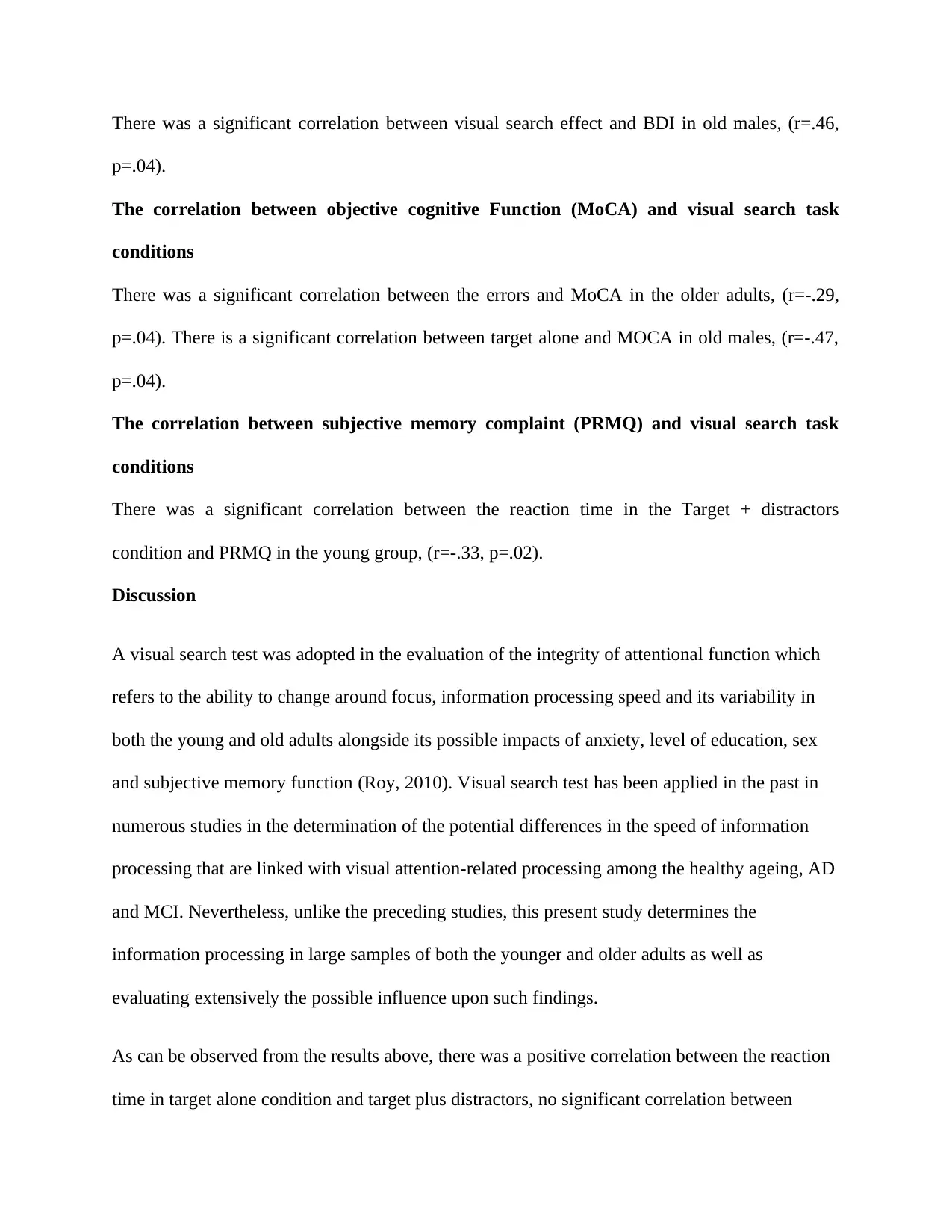
There was a significant correlation between visual search effect and BDI in old males, (r=.46,
p=.04).
The correlation between objective cognitive Function (MoCA) and visual search task
conditions
There was a significant correlation between the errors and MoCA in the older adults, (r=-.29,
p=.04). There is a significant correlation between target alone and MOCA in old males, (r=-.47,
p=.04).
The correlation between subjective memory complaint (PRMQ) and visual search task
conditions
There was a significant correlation between the reaction time in the Target + distractors
condition and PRMQ in the young group, (r=-.33, p=.02).
Discussion
A visual search test was adopted in the evaluation of the integrity of attentional function which
refers to the ability to change around focus, information processing speed and its variability in
both the young and old adults alongside its possible impacts of anxiety, level of education, sex
and subjective memory function (Roy, 2010). Visual search test has been applied in the past in
numerous studies in the determination of the potential differences in the speed of information
processing that are linked with visual attention-related processing among the healthy ageing, AD
and MCI. Nevertheless, unlike the preceding studies, this present study determines the
information processing in large samples of both the younger and older adults as well as
evaluating extensively the possible influence upon such findings.
As can be observed from the results above, there was a positive correlation between the reaction
time in target alone condition and target plus distractors, no significant correlation between
p=.04).
The correlation between objective cognitive Function (MoCA) and visual search task
conditions
There was a significant correlation between the errors and MoCA in the older adults, (r=-.29,
p=.04). There is a significant correlation between target alone and MOCA in old males, (r=-.47,
p=.04).
The correlation between subjective memory complaint (PRMQ) and visual search task
conditions
There was a significant correlation between the reaction time in the Target + distractors
condition and PRMQ in the young group, (r=-.33, p=.02).
Discussion
A visual search test was adopted in the evaluation of the integrity of attentional function which
refers to the ability to change around focus, information processing speed and its variability in
both the young and old adults alongside its possible impacts of anxiety, level of education, sex
and subjective memory function (Roy, 2010). Visual search test has been applied in the past in
numerous studies in the determination of the potential differences in the speed of information
processing that are linked with visual attention-related processing among the healthy ageing, AD
and MCI. Nevertheless, unlike the preceding studies, this present study determines the
information processing in large samples of both the younger and older adults as well as
evaluating extensively the possible influence upon such findings.
As can be observed from the results above, there was a positive correlation between the reaction
time in target alone condition and target plus distractors, no significant correlation between
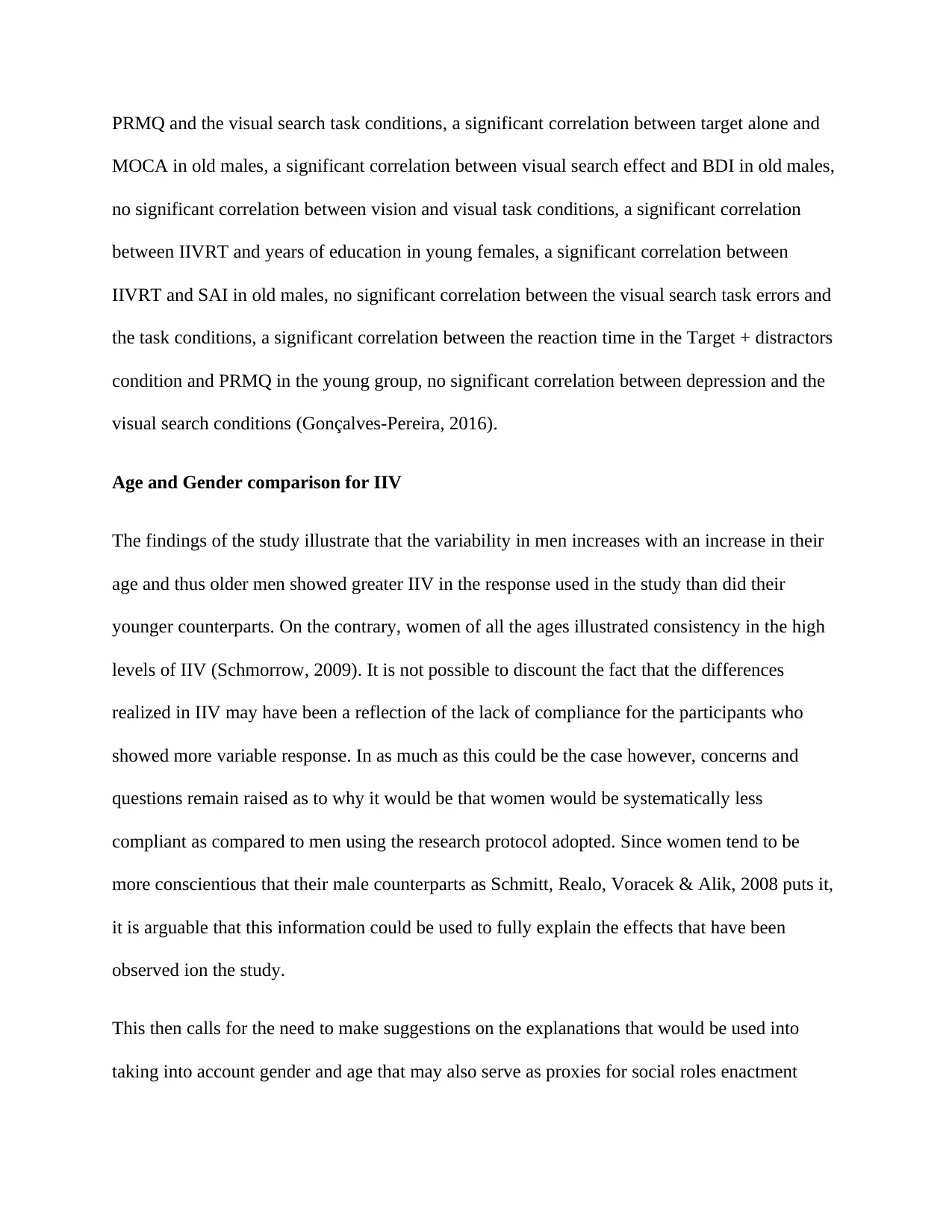
PRMQ and the visual search task conditions, a significant correlation between target alone and
MOCA in old males, a significant correlation between visual search effect and BDI in old males,
no significant correlation between vision and visual task conditions, a significant correlation
between IIVRT and years of education in young females, a significant correlation between
IIVRT and SAI in old males, no significant correlation between the visual search task errors and
the task conditions, a significant correlation between the reaction time in the Target + distractors
condition and PRMQ in the young group, no significant correlation between depression and the
visual search conditions (Gonçalves-Pereira, 2016).
Age and Gender comparison for IIV
The findings of the study illustrate that the variability in men increases with an increase in their
age and thus older men showed greater IIV in the response used in the study than did their
younger counterparts. On the contrary, women of all the ages illustrated consistency in the high
levels of IIV (Schmorrow, 2009). It is not possible to discount the fact that the differences
realized in IIV may have been a reflection of the lack of compliance for the participants who
showed more variable response. In as much as this could be the case however, concerns and
questions remain raised as to why it would be that women would be systematically less
compliant as compared to men using the research protocol adopted. Since women tend to be
more conscientious that their male counterparts as Schmitt, Realo, Voracek & Alik, 2008 puts it,
it is arguable that this information could be used to fully explain the effects that have been
observed ion the study.
This then calls for the need to make suggestions on the explanations that would be used into
taking into account gender and age that may also serve as proxies for social roles enactment
MOCA in old males, a significant correlation between visual search effect and BDI in old males,
no significant correlation between vision and visual task conditions, a significant correlation
between IIVRT and years of education in young females, a significant correlation between
IIVRT and SAI in old males, no significant correlation between the visual search task errors and
the task conditions, a significant correlation between the reaction time in the Target + distractors
condition and PRMQ in the young group, no significant correlation between depression and the
visual search conditions (Gonçalves-Pereira, 2016).
Age and Gender comparison for IIV
The findings of the study illustrate that the variability in men increases with an increase in their
age and thus older men showed greater IIV in the response used in the study than did their
younger counterparts. On the contrary, women of all the ages illustrated consistency in the high
levels of IIV (Schmorrow, 2009). It is not possible to discount the fact that the differences
realized in IIV may have been a reflection of the lack of compliance for the participants who
showed more variable response. In as much as this could be the case however, concerns and
questions remain raised as to why it would be that women would be systematically less
compliant as compared to men using the research protocol adopted. Since women tend to be
more conscientious that their male counterparts as Schmitt, Realo, Voracek & Alik, 2008 puts it,
it is arguable that this information could be used to fully explain the effects that have been
observed ion the study.
This then calls for the need to make suggestions on the explanations that would be used into
taking into account gender and age that may also serve as proxies for social roles enactment
Paraphrase This Document
Need a fresh take? Get an instant paraphrase of this document with our AI Paraphraser
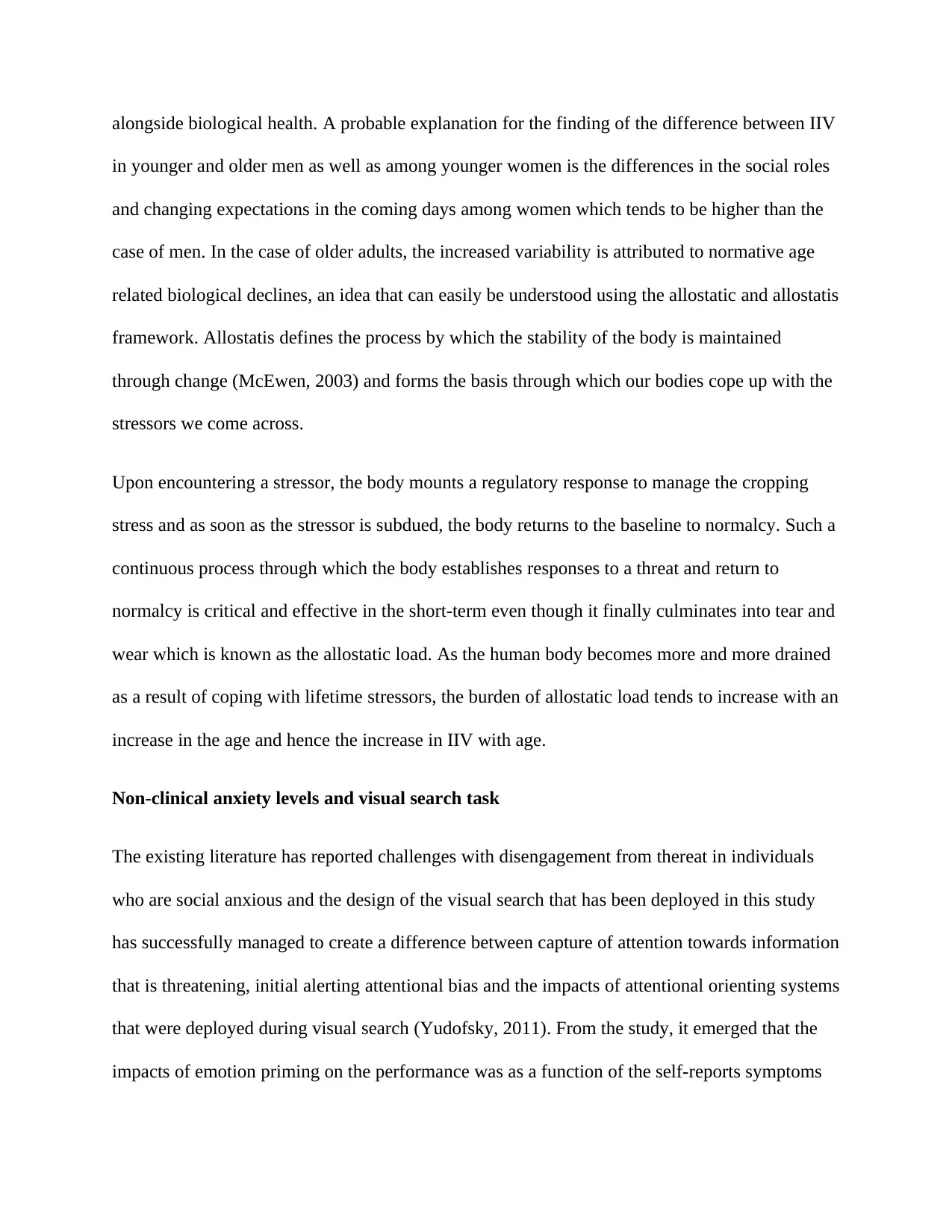
alongside biological health. A probable explanation for the finding of the difference between IIV
in younger and older men as well as among younger women is the differences in the social roles
and changing expectations in the coming days among women which tends to be higher than the
case of men. In the case of older adults, the increased variability is attributed to normative age
related biological declines, an idea that can easily be understood using the allostatic and allostatis
framework. Allostatis defines the process by which the stability of the body is maintained
through change (McEwen, 2003) and forms the basis through which our bodies cope up with the
stressors we come across.
Upon encountering a stressor, the body mounts a regulatory response to manage the cropping
stress and as soon as the stressor is subdued, the body returns to the baseline to normalcy. Such a
continuous process through which the body establishes responses to a threat and return to
normalcy is critical and effective in the short-term even though it finally culminates into tear and
wear which is known as the allostatic load. As the human body becomes more and more drained
as a result of coping with lifetime stressors, the burden of allostatic load tends to increase with an
increase in the age and hence the increase in IIV with age.
Non-clinical anxiety levels and visual search task
The existing literature has reported challenges with disengagement from thereat in individuals
who are social anxious and the design of the visual search that has been deployed in this study
has successfully managed to create a difference between capture of attention towards information
that is threatening, initial alerting attentional bias and the impacts of attentional orienting systems
that were deployed during visual search (Yudofsky, 2011). From the study, it emerged that the
impacts of emotion priming on the performance was as a function of the self-reports symptoms
in younger and older men as well as among younger women is the differences in the social roles
and changing expectations in the coming days among women which tends to be higher than the
case of men. In the case of older adults, the increased variability is attributed to normative age
related biological declines, an idea that can easily be understood using the allostatic and allostatis
framework. Allostatis defines the process by which the stability of the body is maintained
through change (McEwen, 2003) and forms the basis through which our bodies cope up with the
stressors we come across.
Upon encountering a stressor, the body mounts a regulatory response to manage the cropping
stress and as soon as the stressor is subdued, the body returns to the baseline to normalcy. Such a
continuous process through which the body establishes responses to a threat and return to
normalcy is critical and effective in the short-term even though it finally culminates into tear and
wear which is known as the allostatic load. As the human body becomes more and more drained
as a result of coping with lifetime stressors, the burden of allostatic load tends to increase with an
increase in the age and hence the increase in IIV with age.
Non-clinical anxiety levels and visual search task
The existing literature has reported challenges with disengagement from thereat in individuals
who are social anxious and the design of the visual search that has been deployed in this study
has successfully managed to create a difference between capture of attention towards information
that is threatening, initial alerting attentional bias and the impacts of attentional orienting systems
that were deployed during visual search (Yudofsky, 2011). From the study, it emerged that the
impacts of emotion priming on the performance was as a function of the self-reports symptoms
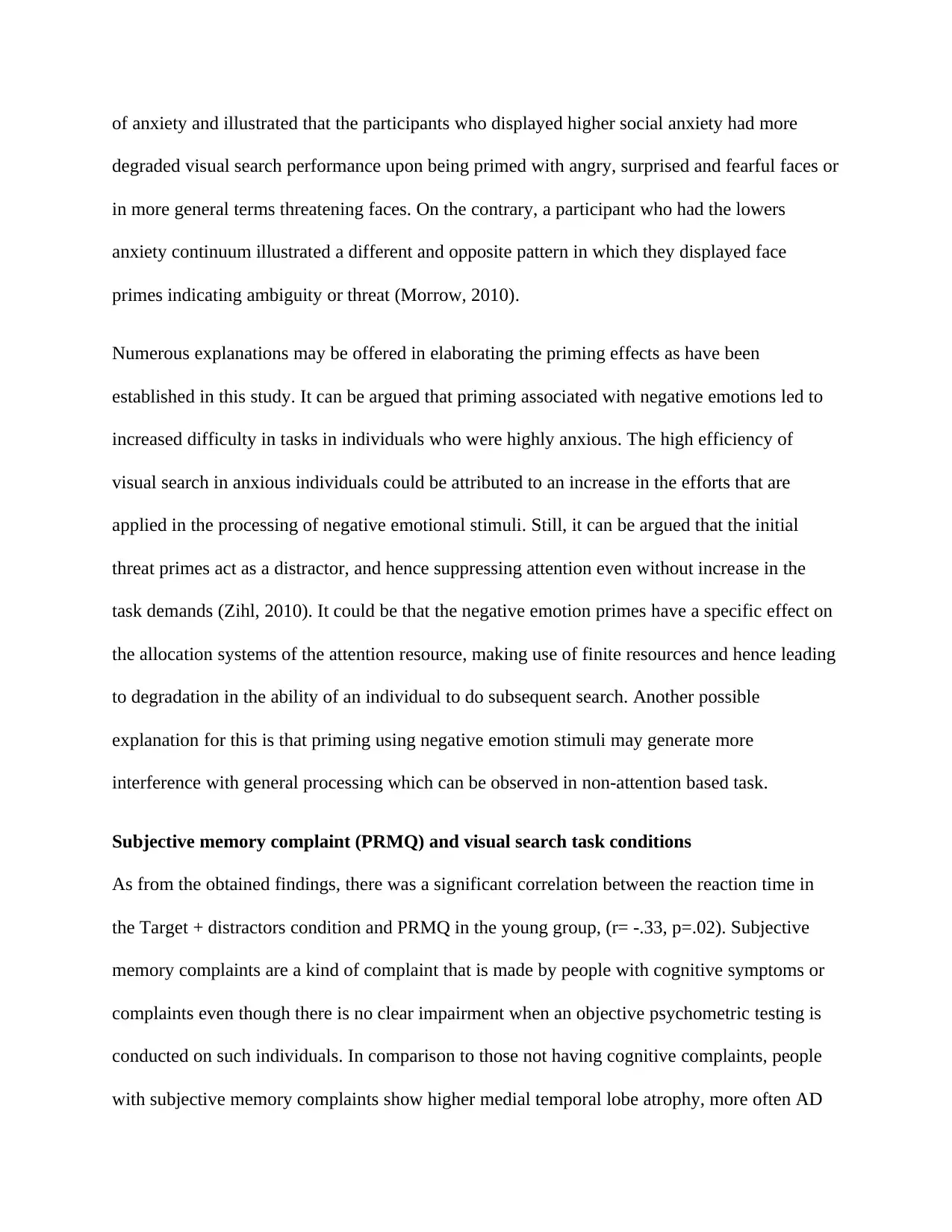
of anxiety and illustrated that the participants who displayed higher social anxiety had more
degraded visual search performance upon being primed with angry, surprised and fearful faces or
in more general terms threatening faces. On the contrary, a participant who had the lowers
anxiety continuum illustrated a different and opposite pattern in which they displayed face
primes indicating ambiguity or threat (Morrow, 2010).
Numerous explanations may be offered in elaborating the priming effects as have been
established in this study. It can be argued that priming associated with negative emotions led to
increased difficulty in tasks in individuals who were highly anxious. The high efficiency of
visual search in anxious individuals could be attributed to an increase in the efforts that are
applied in the processing of negative emotional stimuli. Still, it can be argued that the initial
threat primes act as a distractor, and hence suppressing attention even without increase in the
task demands (Zihl, 2010). It could be that the negative emotion primes have a specific effect on
the allocation systems of the attention resource, making use of finite resources and hence leading
to degradation in the ability of an individual to do subsequent search. Another possible
explanation for this is that priming using negative emotion stimuli may generate more
interference with general processing which can be observed in non-attention based task.
Subjective memory complaint (PRMQ) and visual search task conditions
As from the obtained findings, there was a significant correlation between the reaction time in
the Target + distractors condition and PRMQ in the young group, (r= -.33, p=.02). Subjective
memory complaints are a kind of complaint that is made by people with cognitive symptoms or
complaints even though there is no clear impairment when an objective psychometric testing is
conducted on such individuals. In comparison to those not having cognitive complaints, people
with subjective memory complaints show higher medial temporal lobe atrophy, more often AD
degraded visual search performance upon being primed with angry, surprised and fearful faces or
in more general terms threatening faces. On the contrary, a participant who had the lowers
anxiety continuum illustrated a different and opposite pattern in which they displayed face
primes indicating ambiguity or threat (Morrow, 2010).
Numerous explanations may be offered in elaborating the priming effects as have been
established in this study. It can be argued that priming associated with negative emotions led to
increased difficulty in tasks in individuals who were highly anxious. The high efficiency of
visual search in anxious individuals could be attributed to an increase in the efforts that are
applied in the processing of negative emotional stimuli. Still, it can be argued that the initial
threat primes act as a distractor, and hence suppressing attention even without increase in the
task demands (Zihl, 2010). It could be that the negative emotion primes have a specific effect on
the allocation systems of the attention resource, making use of finite resources and hence leading
to degradation in the ability of an individual to do subsequent search. Another possible
explanation for this is that priming using negative emotion stimuli may generate more
interference with general processing which can be observed in non-attention based task.
Subjective memory complaint (PRMQ) and visual search task conditions
As from the obtained findings, there was a significant correlation between the reaction time in
the Target + distractors condition and PRMQ in the young group, (r= -.33, p=.02). Subjective
memory complaints are a kind of complaint that is made by people with cognitive symptoms or
complaints even though there is no clear impairment when an objective psychometric testing is
conducted on such individuals. In comparison to those not having cognitive complaints, people
with subjective memory complaints show higher medial temporal lobe atrophy, more often AD
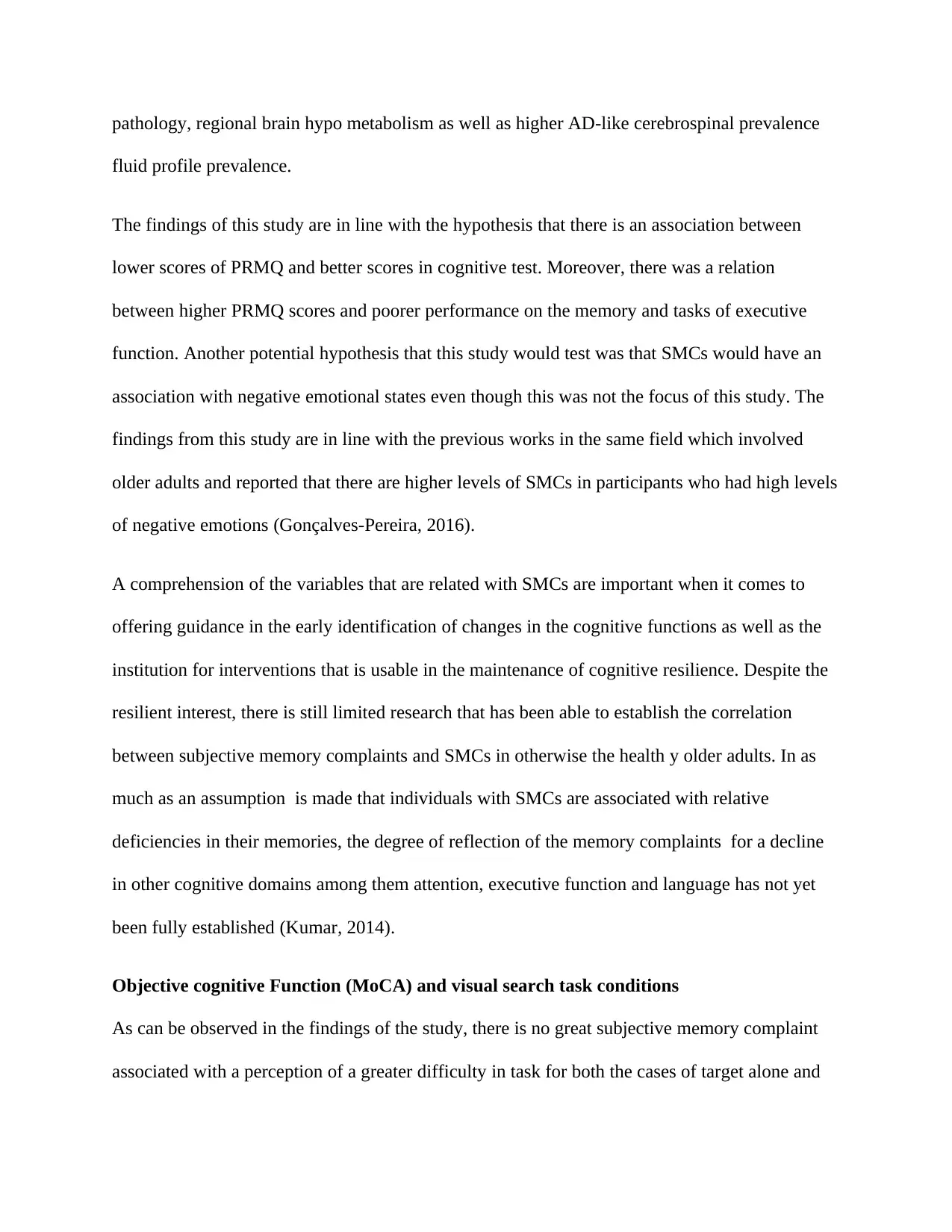
pathology, regional brain hypo metabolism as well as higher AD-like cerebrospinal prevalence
fluid profile prevalence.
The findings of this study are in line with the hypothesis that there is an association between
lower scores of PRMQ and better scores in cognitive test. Moreover, there was a relation
between higher PRMQ scores and poorer performance on the memory and tasks of executive
function. Another potential hypothesis that this study would test was that SMCs would have an
association with negative emotional states even though this was not the focus of this study. The
findings from this study are in line with the previous works in the same field which involved
older adults and reported that there are higher levels of SMCs in participants who had high levels
of negative emotions (Gonçalves-Pereira, 2016).
A comprehension of the variables that are related with SMCs are important when it comes to
offering guidance in the early identification of changes in the cognitive functions as well as the
institution for interventions that is usable in the maintenance of cognitive resilience. Despite the
resilient interest, there is still limited research that has been able to establish the correlation
between subjective memory complaints and SMCs in otherwise the health y older adults. In as
much as an assumption is made that individuals with SMCs are associated with relative
deficiencies in their memories, the degree of reflection of the memory complaints for a decline
in other cognitive domains among them attention, executive function and language has not yet
been fully established (Kumar, 2014).
Objective cognitive Function (MoCA) and visual search task conditions
As can be observed in the findings of the study, there is no great subjective memory complaint
associated with a perception of a greater difficulty in task for both the cases of target alone and
fluid profile prevalence.
The findings of this study are in line with the hypothesis that there is an association between
lower scores of PRMQ and better scores in cognitive test. Moreover, there was a relation
between higher PRMQ scores and poorer performance on the memory and tasks of executive
function. Another potential hypothesis that this study would test was that SMCs would have an
association with negative emotional states even though this was not the focus of this study. The
findings from this study are in line with the previous works in the same field which involved
older adults and reported that there are higher levels of SMCs in participants who had high levels
of negative emotions (Gonçalves-Pereira, 2016).
A comprehension of the variables that are related with SMCs are important when it comes to
offering guidance in the early identification of changes in the cognitive functions as well as the
institution for interventions that is usable in the maintenance of cognitive resilience. Despite the
resilient interest, there is still limited research that has been able to establish the correlation
between subjective memory complaints and SMCs in otherwise the health y older adults. In as
much as an assumption is made that individuals with SMCs are associated with relative
deficiencies in their memories, the degree of reflection of the memory complaints for a decline
in other cognitive domains among them attention, executive function and language has not yet
been fully established (Kumar, 2014).
Objective cognitive Function (MoCA) and visual search task conditions
As can be observed in the findings of the study, there is no great subjective memory complaint
associated with a perception of a greater difficulty in task for both the cases of target alone and
Secure Best Marks with AI Grader
Need help grading? Try our AI Grader for instant feedback on your assignments.
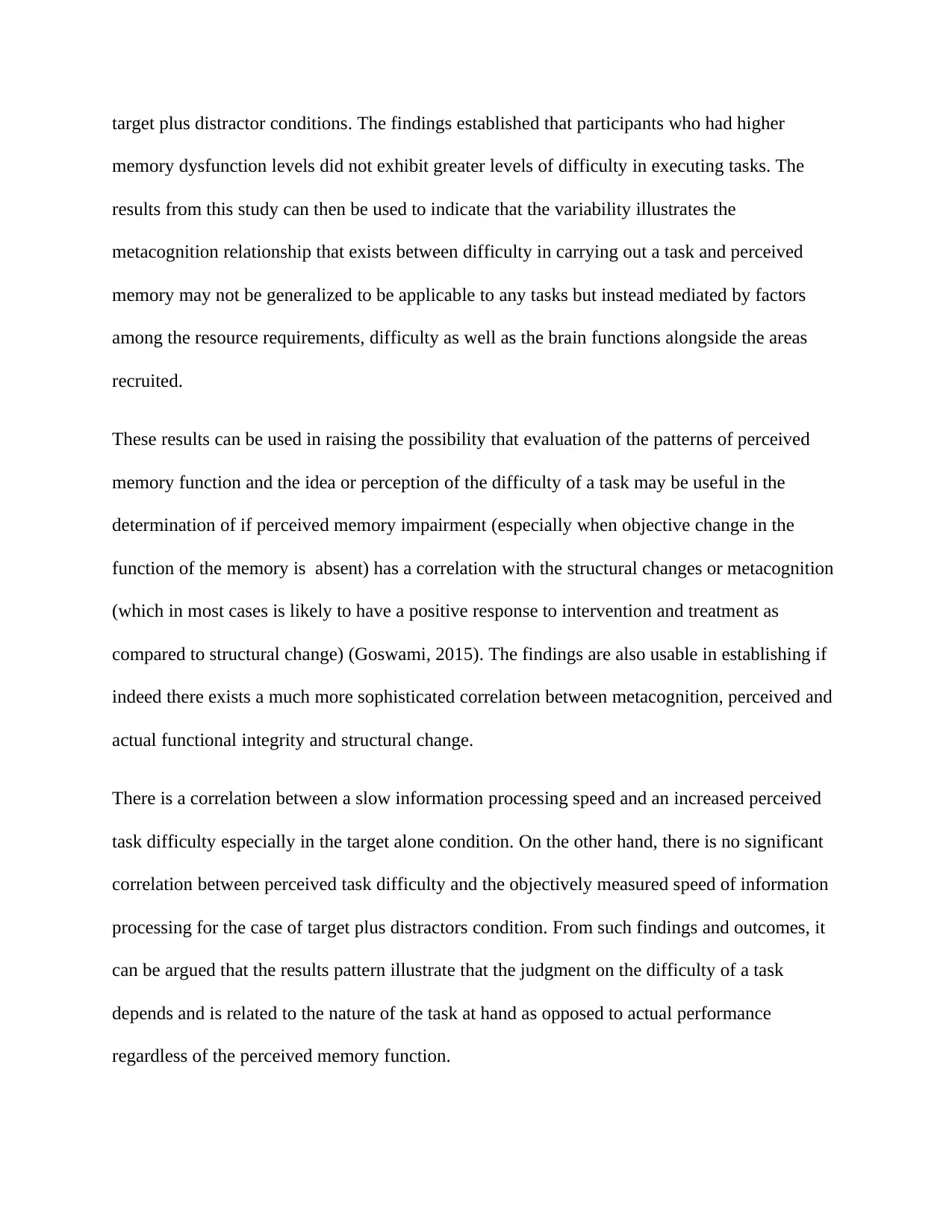
target plus distractor conditions. The findings established that participants who had higher
memory dysfunction levels did not exhibit greater levels of difficulty in executing tasks. The
results from this study can then be used to indicate that the variability illustrates the
metacognition relationship that exists between difficulty in carrying out a task and perceived
memory may not be generalized to be applicable to any tasks but instead mediated by factors
among the resource requirements, difficulty as well as the brain functions alongside the areas
recruited.
These results can be used in raising the possibility that evaluation of the patterns of perceived
memory function and the idea or perception of the difficulty of a task may be useful in the
determination of if perceived memory impairment (especially when objective change in the
function of the memory is absent) has a correlation with the structural changes or metacognition
(which in most cases is likely to have a positive response to intervention and treatment as
compared to structural change) (Goswami, 2015). The findings are also usable in establishing if
indeed there exists a much more sophisticated correlation between metacognition, perceived and
actual functional integrity and structural change.
There is a correlation between a slow information processing speed and an increased perceived
task difficulty especially in the target alone condition. On the other hand, there is no significant
correlation between perceived task difficulty and the objectively measured speed of information
processing for the case of target plus distractors condition. From such findings and outcomes, it
can be argued that the results pattern illustrate that the judgment on the difficulty of a task
depends and is related to the nature of the task at hand as opposed to actual performance
regardless of the perceived memory function.
memory dysfunction levels did not exhibit greater levels of difficulty in executing tasks. The
results from this study can then be used to indicate that the variability illustrates the
metacognition relationship that exists between difficulty in carrying out a task and perceived
memory may not be generalized to be applicable to any tasks but instead mediated by factors
among the resource requirements, difficulty as well as the brain functions alongside the areas
recruited.
These results can be used in raising the possibility that evaluation of the patterns of perceived
memory function and the idea or perception of the difficulty of a task may be useful in the
determination of if perceived memory impairment (especially when objective change in the
function of the memory is absent) has a correlation with the structural changes or metacognition
(which in most cases is likely to have a positive response to intervention and treatment as
compared to structural change) (Goswami, 2015). The findings are also usable in establishing if
indeed there exists a much more sophisticated correlation between metacognition, perceived and
actual functional integrity and structural change.
There is a correlation between a slow information processing speed and an increased perceived
task difficulty especially in the target alone condition. On the other hand, there is no significant
correlation between perceived task difficulty and the objectively measured speed of information
processing for the case of target plus distractors condition. From such findings and outcomes, it
can be argued that the results pattern illustrate that the judgment on the difficulty of a task
depends and is related to the nature of the task at hand as opposed to actual performance
regardless of the perceived memory function.
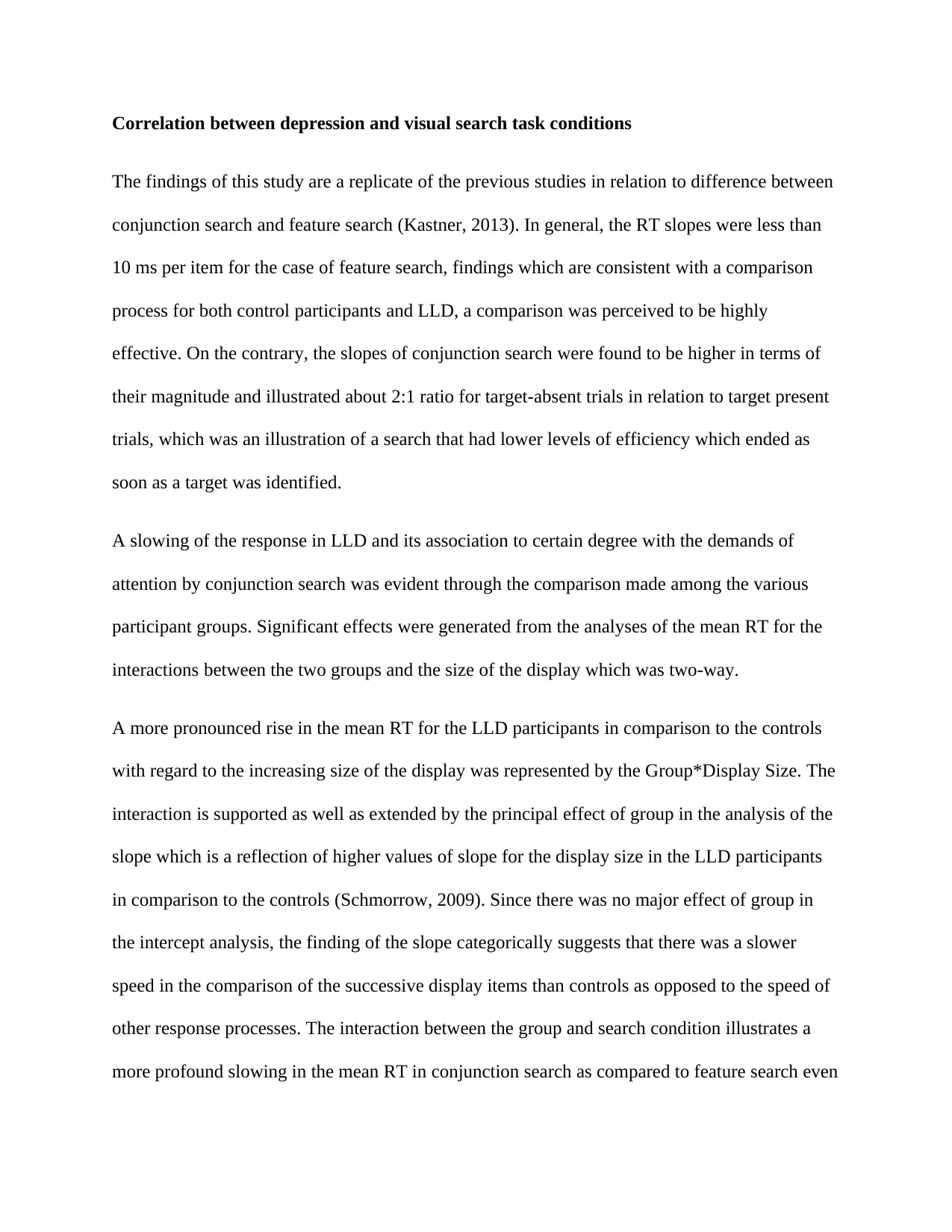
Correlation between depression and visual search task conditions
The findings of this study are a replicate of the previous studies in relation to difference between
conjunction search and feature search (Kastner, 2013). In general, the RT slopes were less than
10 ms per item for the case of feature search, findings which are consistent with a comparison
process for both control participants and LLD, a comparison was perceived to be highly
effective. On the contrary, the slopes of conjunction search were found to be higher in terms of
their magnitude and illustrated about 2:1 ratio for target-absent trials in relation to target present
trials, which was an illustration of a search that had lower levels of efficiency which ended as
soon as a target was identified.
A slowing of the response in LLD and its association to certain degree with the demands of
attention by conjunction search was evident through the comparison made among the various
participant groups. Significant effects were generated from the analyses of the mean RT for the
interactions between the two groups and the size of the display which was two-way.
A more pronounced rise in the mean RT for the LLD participants in comparison to the controls
with regard to the increasing size of the display was represented by the Group*Display Size. The
interaction is supported as well as extended by the principal effect of group in the analysis of the
slope which is a reflection of higher values of slope for the display size in the LLD participants
in comparison to the controls (Schmorrow, 2009). Since there was no major effect of group in
the intercept analysis, the finding of the slope categorically suggests that there was a slower
speed in the comparison of the successive display items than controls as opposed to the speed of
other response processes. The interaction between the group and search condition illustrates a
more profound slowing in the mean RT in conjunction search as compared to feature search even
The findings of this study are a replicate of the previous studies in relation to difference between
conjunction search and feature search (Kastner, 2013). In general, the RT slopes were less than
10 ms per item for the case of feature search, findings which are consistent with a comparison
process for both control participants and LLD, a comparison was perceived to be highly
effective. On the contrary, the slopes of conjunction search were found to be higher in terms of
their magnitude and illustrated about 2:1 ratio for target-absent trials in relation to target present
trials, which was an illustration of a search that had lower levels of efficiency which ended as
soon as a target was identified.
A slowing of the response in LLD and its association to certain degree with the demands of
attention by conjunction search was evident through the comparison made among the various
participant groups. Significant effects were generated from the analyses of the mean RT for the
interactions between the two groups and the size of the display which was two-way.
A more pronounced rise in the mean RT for the LLD participants in comparison to the controls
with regard to the increasing size of the display was represented by the Group*Display Size. The
interaction is supported as well as extended by the principal effect of group in the analysis of the
slope which is a reflection of higher values of slope for the display size in the LLD participants
in comparison to the controls (Schmorrow, 2009). Since there was no major effect of group in
the intercept analysis, the finding of the slope categorically suggests that there was a slower
speed in the comparison of the successive display items than controls as opposed to the speed of
other response processes. The interaction between the group and search condition illustrates a
more profound slowing in the mean RT in conjunction search as compared to feature search even
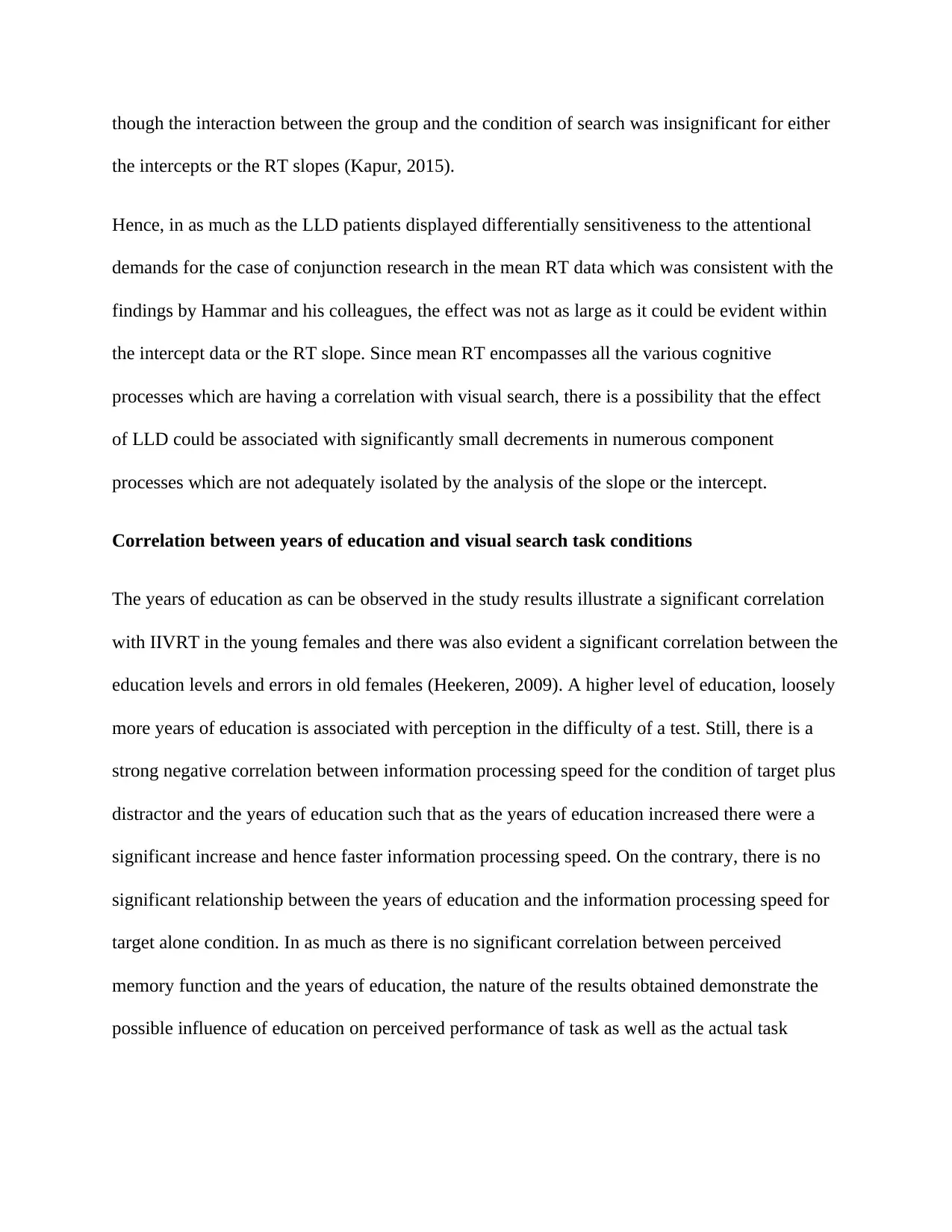
though the interaction between the group and the condition of search was insignificant for either
the intercepts or the RT slopes (Kapur, 2015).
Hence, in as much as the LLD patients displayed differentially sensitiveness to the attentional
demands for the case of conjunction research in the mean RT data which was consistent with the
findings by Hammar and his colleagues, the effect was not as large as it could be evident within
the intercept data or the RT slope. Since mean RT encompasses all the various cognitive
processes which are having a correlation with visual search, there is a possibility that the effect
of LLD could be associated with significantly small decrements in numerous component
processes which are not adequately isolated by the analysis of the slope or the intercept.
Correlation between years of education and visual search task conditions
The years of education as can be observed in the study results illustrate a significant correlation
with IIVRT in the young females and there was also evident a significant correlation between the
education levels and errors in old females (Heekeren, 2009). A higher level of education, loosely
more years of education is associated with perception in the difficulty of a test. Still, there is a
strong negative correlation between information processing speed for the condition of target plus
distractor and the years of education such that as the years of education increased there were a
significant increase and hence faster information processing speed. On the contrary, there is no
significant relationship between the years of education and the information processing speed for
target alone condition. In as much as there is no significant correlation between perceived
memory function and the years of education, the nature of the results obtained demonstrate the
possible influence of education on perceived performance of task as well as the actual task
the intercepts or the RT slopes (Kapur, 2015).
Hence, in as much as the LLD patients displayed differentially sensitiveness to the attentional
demands for the case of conjunction research in the mean RT data which was consistent with the
findings by Hammar and his colleagues, the effect was not as large as it could be evident within
the intercept data or the RT slope. Since mean RT encompasses all the various cognitive
processes which are having a correlation with visual search, there is a possibility that the effect
of LLD could be associated with significantly small decrements in numerous component
processes which are not adequately isolated by the analysis of the slope or the intercept.
Correlation between years of education and visual search task conditions
The years of education as can be observed in the study results illustrate a significant correlation
with IIVRT in the young females and there was also evident a significant correlation between the
education levels and errors in old females (Heekeren, 2009). A higher level of education, loosely
more years of education is associated with perception in the difficulty of a test. Still, there is a
strong negative correlation between information processing speed for the condition of target plus
distractor and the years of education such that as the years of education increased there were a
significant increase and hence faster information processing speed. On the contrary, there is no
significant relationship between the years of education and the information processing speed for
target alone condition. In as much as there is no significant correlation between perceived
memory function and the years of education, the nature of the results obtained demonstrate the
possible influence of education on perceived performance of task as well as the actual task
Paraphrase This Document
Need a fresh take? Get an instant paraphrase of this document with our AI Paraphraser
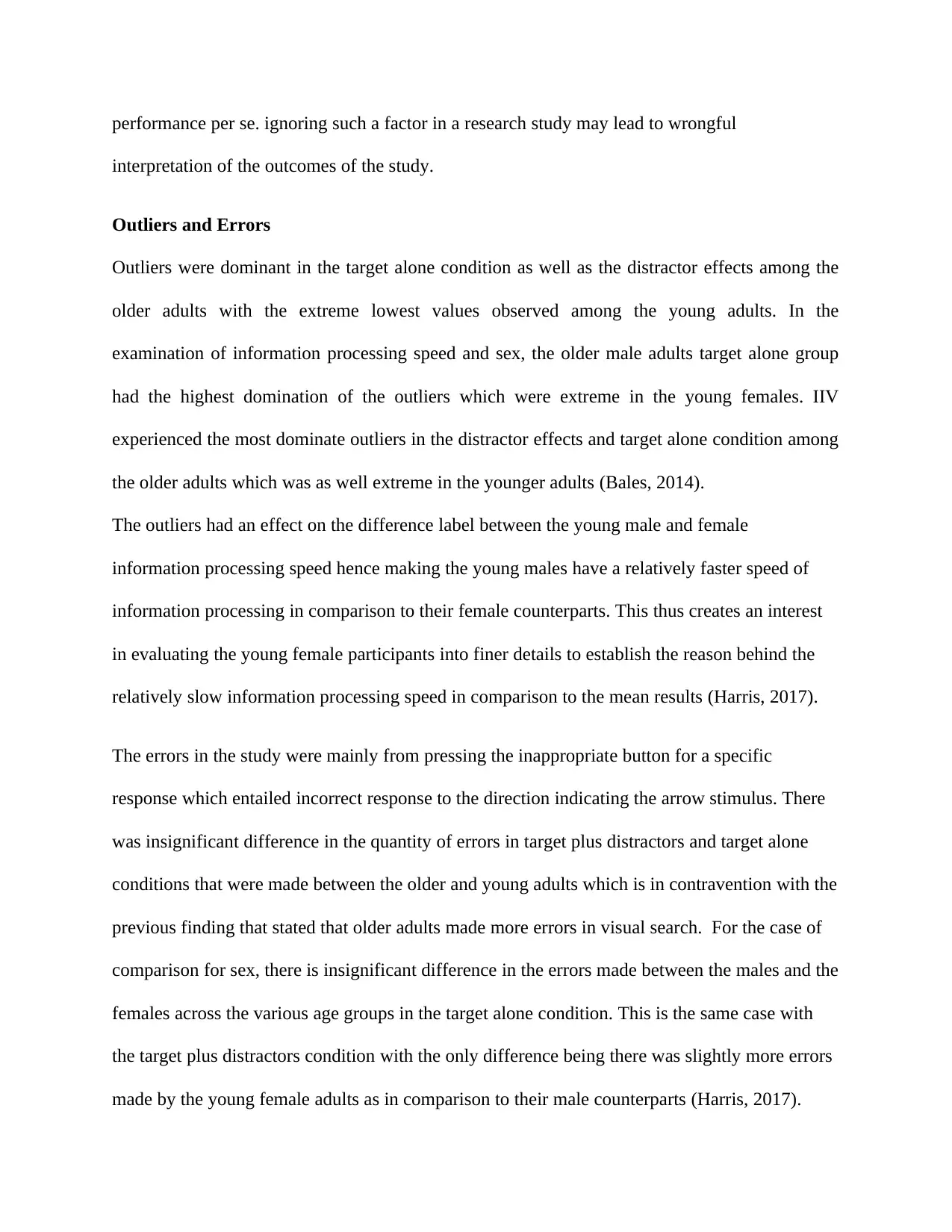
performance per se. ignoring such a factor in a research study may lead to wrongful
interpretation of the outcomes of the study.
Outliers and Errors
Outliers were dominant in the target alone condition as well as the distractor effects among the
older adults with the extreme lowest values observed among the young adults. In the
examination of information processing speed and sex, the older male adults target alone group
had the highest domination of the outliers which were extreme in the young females. IIV
experienced the most dominate outliers in the distractor effects and target alone condition among
the older adults which was as well extreme in the younger adults (Bales, 2014).
The outliers had an effect on the difference label between the young male and female
information processing speed hence making the young males have a relatively faster speed of
information processing in comparison to their female counterparts. This thus creates an interest
in evaluating the young female participants into finer details to establish the reason behind the
relatively slow information processing speed in comparison to the mean results (Harris, 2017).
The errors in the study were mainly from pressing the inappropriate button for a specific
response which entailed incorrect response to the direction indicating the arrow stimulus. There
was insignificant difference in the quantity of errors in target plus distractors and target alone
conditions that were made between the older and young adults which is in contravention with the
previous finding that stated that older adults made more errors in visual search. For the case of
comparison for sex, there is insignificant difference in the errors made between the males and the
females across the various age groups in the target alone condition. This is the same case with
the target plus distractors condition with the only difference being there was slightly more errors
made by the young female adults as in comparison to their male counterparts (Harris, 2017).
interpretation of the outcomes of the study.
Outliers and Errors
Outliers were dominant in the target alone condition as well as the distractor effects among the
older adults with the extreme lowest values observed among the young adults. In the
examination of information processing speed and sex, the older male adults target alone group
had the highest domination of the outliers which were extreme in the young females. IIV
experienced the most dominate outliers in the distractor effects and target alone condition among
the older adults which was as well extreme in the younger adults (Bales, 2014).
The outliers had an effect on the difference label between the young male and female
information processing speed hence making the young males have a relatively faster speed of
information processing in comparison to their female counterparts. This thus creates an interest
in evaluating the young female participants into finer details to establish the reason behind the
relatively slow information processing speed in comparison to the mean results (Harris, 2017).
The errors in the study were mainly from pressing the inappropriate button for a specific
response which entailed incorrect response to the direction indicating the arrow stimulus. There
was insignificant difference in the quantity of errors in target plus distractors and target alone
conditions that were made between the older and young adults which is in contravention with the
previous finding that stated that older adults made more errors in visual search. For the case of
comparison for sex, there is insignificant difference in the errors made between the males and the
females across the various age groups in the target alone condition. This is the same case with
the target plus distractors condition with the only difference being there was slightly more errors
made by the young female adults as in comparison to their male counterparts (Harris, 2017).
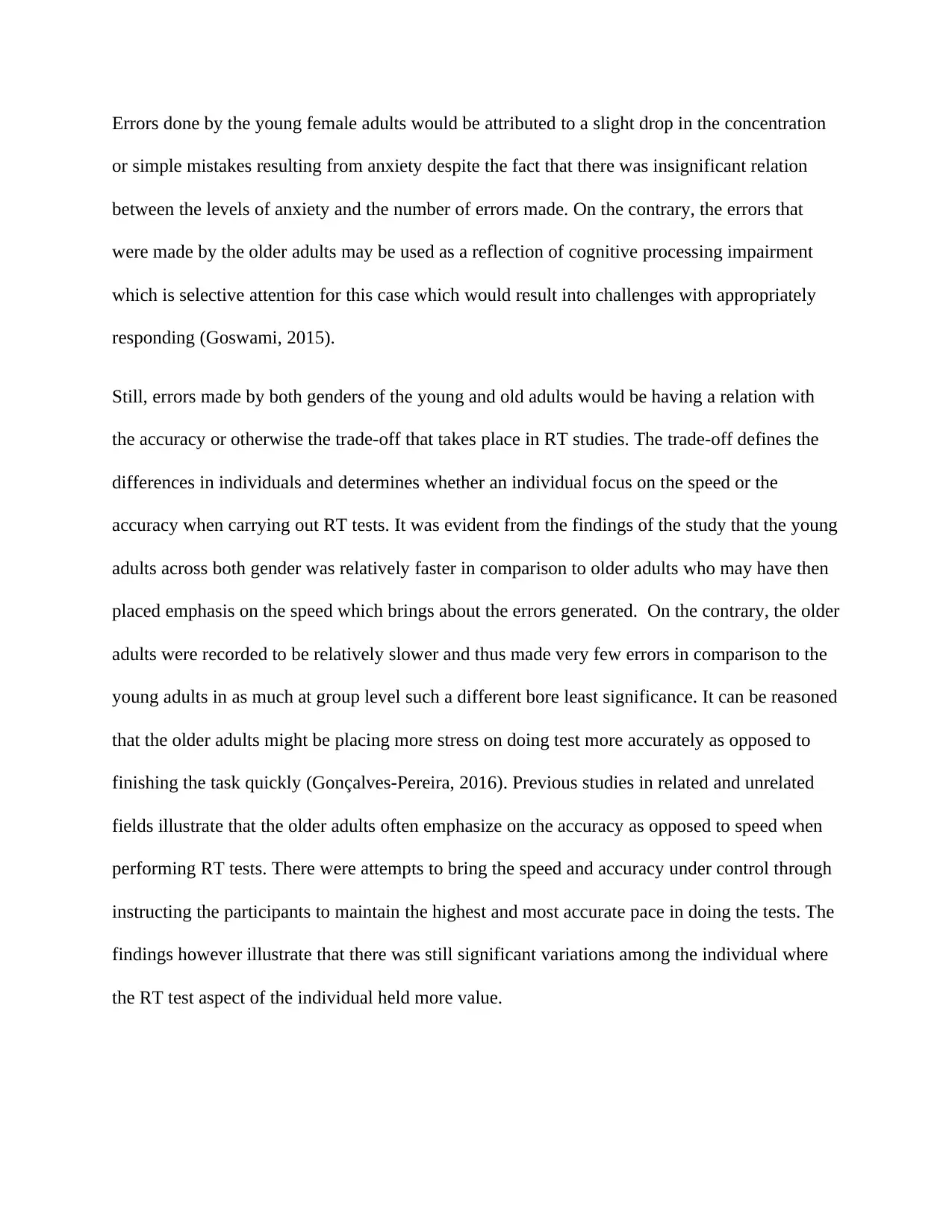
Errors done by the young female adults would be attributed to a slight drop in the concentration
or simple mistakes resulting from anxiety despite the fact that there was insignificant relation
between the levels of anxiety and the number of errors made. On the contrary, the errors that
were made by the older adults may be used as a reflection of cognitive processing impairment
which is selective attention for this case which would result into challenges with appropriately
responding (Goswami, 2015).
Still, errors made by both genders of the young and old adults would be having a relation with
the accuracy or otherwise the trade-off that takes place in RT studies. The trade-off defines the
differences in individuals and determines whether an individual focus on the speed or the
accuracy when carrying out RT tests. It was evident from the findings of the study that the young
adults across both gender was relatively faster in comparison to older adults who may have then
placed emphasis on the speed which brings about the errors generated. On the contrary, the older
adults were recorded to be relatively slower and thus made very few errors in comparison to the
young adults in as much at group level such a different bore least significance. It can be reasoned
that the older adults might be placing more stress on doing test more accurately as opposed to
finishing the task quickly (Gonçalves-Pereira, 2016). Previous studies in related and unrelated
fields illustrate that the older adults often emphasize on the accuracy as opposed to speed when
performing RT tests. There were attempts to bring the speed and accuracy under control through
instructing the participants to maintain the highest and most accurate pace in doing the tests. The
findings however illustrate that there was still significant variations among the individual where
the RT test aspect of the individual held more value.
or simple mistakes resulting from anxiety despite the fact that there was insignificant relation
between the levels of anxiety and the number of errors made. On the contrary, the errors that
were made by the older adults may be used as a reflection of cognitive processing impairment
which is selective attention for this case which would result into challenges with appropriately
responding (Goswami, 2015).
Still, errors made by both genders of the young and old adults would be having a relation with
the accuracy or otherwise the trade-off that takes place in RT studies. The trade-off defines the
differences in individuals and determines whether an individual focus on the speed or the
accuracy when carrying out RT tests. It was evident from the findings of the study that the young
adults across both gender was relatively faster in comparison to older adults who may have then
placed emphasis on the speed which brings about the errors generated. On the contrary, the older
adults were recorded to be relatively slower and thus made very few errors in comparison to the
young adults in as much at group level such a different bore least significance. It can be reasoned
that the older adults might be placing more stress on doing test more accurately as opposed to
finishing the task quickly (Gonçalves-Pereira, 2016). Previous studies in related and unrelated
fields illustrate that the older adults often emphasize on the accuracy as opposed to speed when
performing RT tests. There were attempts to bring the speed and accuracy under control through
instructing the participants to maintain the highest and most accurate pace in doing the tests. The
findings however illustrate that there was still significant variations among the individual where
the RT test aspect of the individual held more value.
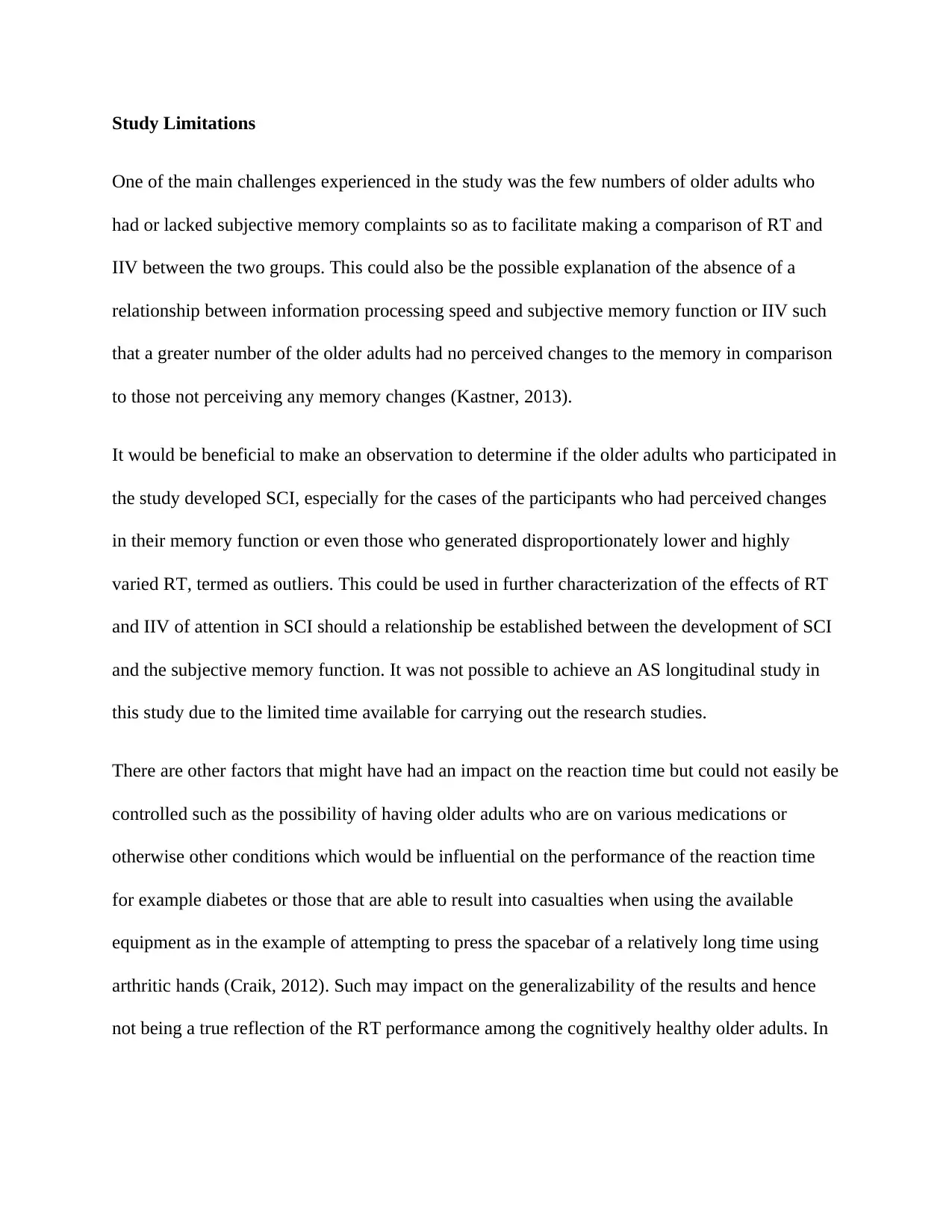
Study Limitations
One of the main challenges experienced in the study was the few numbers of older adults who
had or lacked subjective memory complaints so as to facilitate making a comparison of RT and
IIV between the two groups. This could also be the possible explanation of the absence of a
relationship between information processing speed and subjective memory function or IIV such
that a greater number of the older adults had no perceived changes to the memory in comparison
to those not perceiving any memory changes (Kastner, 2013).
It would be beneficial to make an observation to determine if the older adults who participated in
the study developed SCI, especially for the cases of the participants who had perceived changes
in their memory function or even those who generated disproportionately lower and highly
varied RT, termed as outliers. This could be used in further characterization of the effects of RT
and IIV of attention in SCI should a relationship be established between the development of SCI
and the subjective memory function. It was not possible to achieve an AS longitudinal study in
this study due to the limited time available for carrying out the research studies.
There are other factors that might have had an impact on the reaction time but could not easily be
controlled such as the possibility of having older adults who are on various medications or
otherwise other conditions which would be influential on the performance of the reaction time
for example diabetes or those that are able to result into casualties when using the available
equipment as in the example of attempting to press the spacebar of a relatively long time using
arthritic hands (Craik, 2012). Such may impact on the generalizability of the results and hence
not being a true reflection of the RT performance among the cognitively healthy older adults. In
One of the main challenges experienced in the study was the few numbers of older adults who
had or lacked subjective memory complaints so as to facilitate making a comparison of RT and
IIV between the two groups. This could also be the possible explanation of the absence of a
relationship between information processing speed and subjective memory function or IIV such
that a greater number of the older adults had no perceived changes to the memory in comparison
to those not perceiving any memory changes (Kastner, 2013).
It would be beneficial to make an observation to determine if the older adults who participated in
the study developed SCI, especially for the cases of the participants who had perceived changes
in their memory function or even those who generated disproportionately lower and highly
varied RT, termed as outliers. This could be used in further characterization of the effects of RT
and IIV of attention in SCI should a relationship be established between the development of SCI
and the subjective memory function. It was not possible to achieve an AS longitudinal study in
this study due to the limited time available for carrying out the research studies.
There are other factors that might have had an impact on the reaction time but could not easily be
controlled such as the possibility of having older adults who are on various medications or
otherwise other conditions which would be influential on the performance of the reaction time
for example diabetes or those that are able to result into casualties when using the available
equipment as in the example of attempting to press the spacebar of a relatively long time using
arthritic hands (Craik, 2012). Such may impact on the generalizability of the results and hence
not being a true reflection of the RT performance among the cognitively healthy older adults. In
Secure Best Marks with AI Grader
Need help grading? Try our AI Grader for instant feedback on your assignments.

such cases, it is not possible to have control for the situation which has a significant impact on
the attention.
Acquisition of reliable, accurate and consistent reaction time ranging from the responding all the
way to the trial depended on the ability of the participant to maintain his eyes focused on cross at
the start of each of the trails before a search for the target could be commenced. This called for
keeping a close watch by the researcher during the test which could results in slight anxiety
levels in the participant hence inability to perform the task to their optimum capacity. The
impacts of distraction could go all the way onto having a researcher in the room hence interfering
with the performance of the participant. It would be of significant benefit to take measurements
of the eye movement with the aid of an eye tracker to ensure they remained on track which is a
probable measure for future testing.
The use of computer is accompanied by a minute of delay between the natural reaction of a
person to a stimulus and the time taken by the software to take recordings of the RT upon
pressing the keyboard button. This results into a latency effect which in most case cases is not as
significant enough to have any significant impact on the findings as they undergo corrections by
the computer programs despite having a potential impact on the real RT performance of a
participant (Bales, 2014). The program that was used in this study attempted to reduce this effect
and the same computer was adopted for all the participants hence any latency effect which would
have been present would have an effect on all the participants in equal measure. However, it is of
importance to have this latency effect at the back of the mind when taking measurements and
doing comparisons on tasks of computer based reactions. Concerns over the reliability of the
subjective scores also come up which raise questions regarding the honesty of the responses of
the participants in relation with their cognitive concerns.
the attention.
Acquisition of reliable, accurate and consistent reaction time ranging from the responding all the
way to the trial depended on the ability of the participant to maintain his eyes focused on cross at
the start of each of the trails before a search for the target could be commenced. This called for
keeping a close watch by the researcher during the test which could results in slight anxiety
levels in the participant hence inability to perform the task to their optimum capacity. The
impacts of distraction could go all the way onto having a researcher in the room hence interfering
with the performance of the participant. It would be of significant benefit to take measurements
of the eye movement with the aid of an eye tracker to ensure they remained on track which is a
probable measure for future testing.
The use of computer is accompanied by a minute of delay between the natural reaction of a
person to a stimulus and the time taken by the software to take recordings of the RT upon
pressing the keyboard button. This results into a latency effect which in most case cases is not as
significant enough to have any significant impact on the findings as they undergo corrections by
the computer programs despite having a potential impact on the real RT performance of a
participant (Bales, 2014). The program that was used in this study attempted to reduce this effect
and the same computer was adopted for all the participants hence any latency effect which would
have been present would have an effect on all the participants in equal measure. However, it is of
importance to have this latency effect at the back of the mind when taking measurements and
doing comparisons on tasks of computer based reactions. Concerns over the reliability of the
subjective scores also come up which raise questions regarding the honesty of the responses of
the participants in relation with their cognitive concerns.
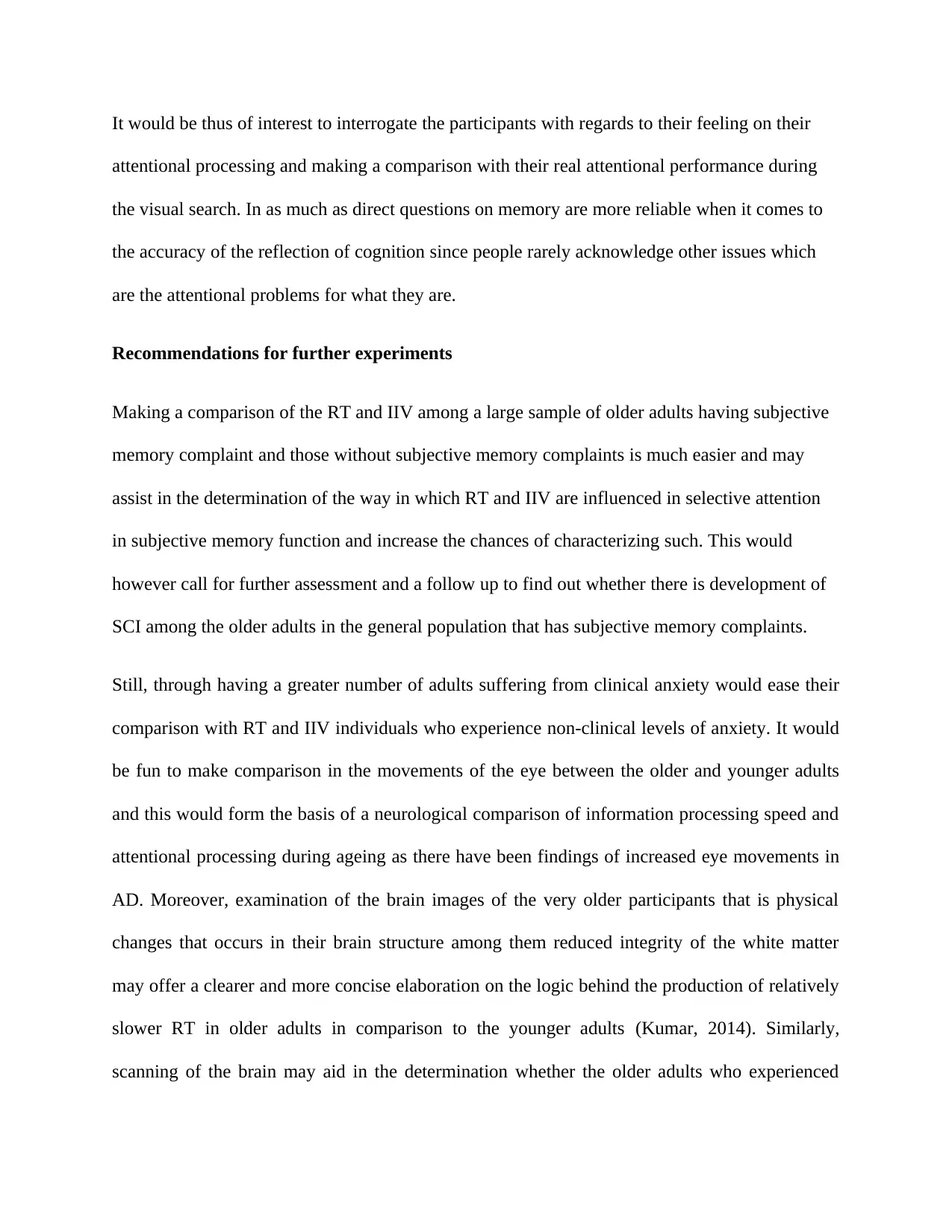
It would be thus of interest to interrogate the participants with regards to their feeling on their
attentional processing and making a comparison with their real attentional performance during
the visual search. In as much as direct questions on memory are more reliable when it comes to
the accuracy of the reflection of cognition since people rarely acknowledge other issues which
are the attentional problems for what they are.
Recommendations for further experiments
Making a comparison of the RT and IIV among a large sample of older adults having subjective
memory complaint and those without subjective memory complaints is much easier and may
assist in the determination of the way in which RT and IIV are influenced in selective attention
in subjective memory function and increase the chances of characterizing such. This would
however call for further assessment and a follow up to find out whether there is development of
SCI among the older adults in the general population that has subjective memory complaints.
Still, through having a greater number of adults suffering from clinical anxiety would ease their
comparison with RT and IIV individuals who experience non-clinical levels of anxiety. It would
be fun to make comparison in the movements of the eye between the older and younger adults
and this would form the basis of a neurological comparison of information processing speed and
attentional processing during ageing as there have been findings of increased eye movements in
AD. Moreover, examination of the brain images of the very older participants that is physical
changes that occurs in their brain structure among them reduced integrity of the white matter
may offer a clearer and more concise elaboration on the logic behind the production of relatively
slower RT in older adults in comparison to the younger adults (Kumar, 2014). Similarly,
scanning of the brain may aid in the determination whether the older adults who experienced
attentional processing and making a comparison with their real attentional performance during
the visual search. In as much as direct questions on memory are more reliable when it comes to
the accuracy of the reflection of cognition since people rarely acknowledge other issues which
are the attentional problems for what they are.
Recommendations for further experiments
Making a comparison of the RT and IIV among a large sample of older adults having subjective
memory complaint and those without subjective memory complaints is much easier and may
assist in the determination of the way in which RT and IIV are influenced in selective attention
in subjective memory function and increase the chances of characterizing such. This would
however call for further assessment and a follow up to find out whether there is development of
SCI among the older adults in the general population that has subjective memory complaints.
Still, through having a greater number of adults suffering from clinical anxiety would ease their
comparison with RT and IIV individuals who experience non-clinical levels of anxiety. It would
be fun to make comparison in the movements of the eye between the older and younger adults
and this would form the basis of a neurological comparison of information processing speed and
attentional processing during ageing as there have been findings of increased eye movements in
AD. Moreover, examination of the brain images of the very older participants that is physical
changes that occurs in their brain structure among them reduced integrity of the white matter
may offer a clearer and more concise elaboration on the logic behind the production of relatively
slower RT in older adults in comparison to the younger adults (Kumar, 2014). Similarly,
scanning of the brain may aid in the determination whether the older adults who experienced
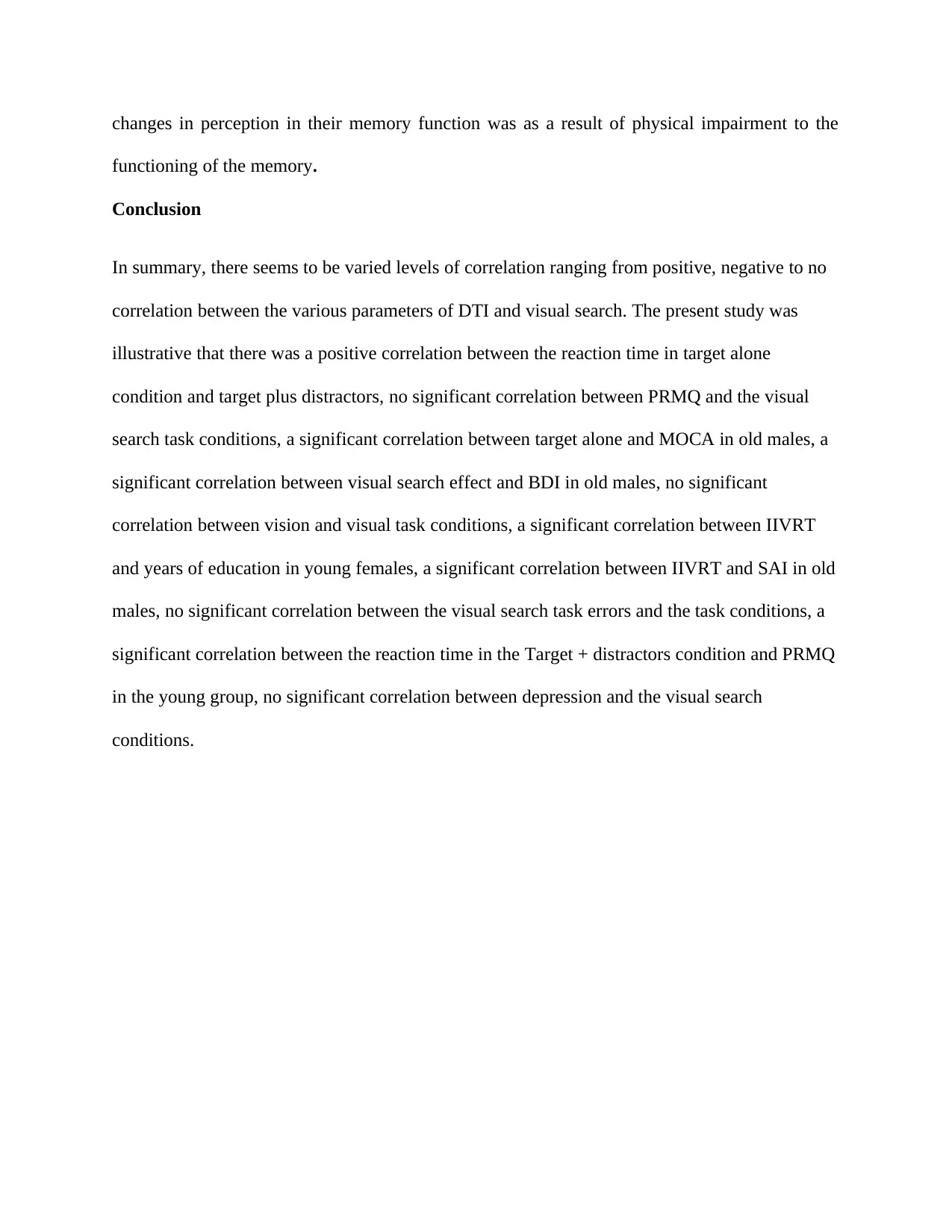
changes in perception in their memory function was as a result of physical impairment to the
functioning of the memory.
Conclusion
In summary, there seems to be varied levels of correlation ranging from positive, negative to no
correlation between the various parameters of DTI and visual search. The present study was
illustrative that there was a positive correlation between the reaction time in target alone
condition and target plus distractors, no significant correlation between PRMQ and the visual
search task conditions, a significant correlation between target alone and MOCA in old males, a
significant correlation between visual search effect and BDI in old males, no significant
correlation between vision and visual task conditions, a significant correlation between IIVRT
and years of education in young females, a significant correlation between IIVRT and SAI in old
males, no significant correlation between the visual search task errors and the task conditions, a
significant correlation between the reaction time in the Target + distractors condition and PRMQ
in the young group, no significant correlation between depression and the visual search
conditions.
functioning of the memory.
Conclusion
In summary, there seems to be varied levels of correlation ranging from positive, negative to no
correlation between the various parameters of DTI and visual search. The present study was
illustrative that there was a positive correlation between the reaction time in target alone
condition and target plus distractors, no significant correlation between PRMQ and the visual
search task conditions, a significant correlation between target alone and MOCA in old males, a
significant correlation between visual search effect and BDI in old males, no significant
correlation between vision and visual task conditions, a significant correlation between IIVRT
and years of education in young females, a significant correlation between IIVRT and SAI in old
males, no significant correlation between the visual search task errors and the task conditions, a
significant correlation between the reaction time in the Target + distractors condition and PRMQ
in the young group, no significant correlation between depression and the visual search
conditions.
Paraphrase This Document
Need a fresh take? Get an instant paraphrase of this document with our AI Paraphraser

References
Bales, o. W. (2014). Handbook of Clinical Nutrition and Aging. London: Springer.
Craik, F. (2012). Aging and Cognitive Processes. Beijing: Springer Science & Business Media.
Flowers, o. (2012). The Influence of Attention, Learning, and Motivation on Visual Search.
Oxford: Springer Science & Business Media.
Gonçalves-Pereira, M. (2016). Neuropsychiatric Symptoms of Cognitive Impairment and
Dementia. Kansas: Springer.
Goswami, U. (2015). Oscillatory “Temporal Sampling” and Developmental Dyslexia: Towards
an Over-Arching Theoretical Framework. London: Frontiers Media SA.
Harris, D. (2017). Engineering Psychology and Cognitive Ergonomics: Performance, Emotion
and Situation Awareness: 14th International Conference, EPCE 2017, Held as Part of
HCI International 2017, Vancouver, BC, Canada, July 9-14, 2017, Proceedings, Part 1.
New York: Springer.
Heekeren, a. (2009). Mind and Motion: The Bidirectional Link between Thought and Action:
Progress in Brain Research. New York: Elsevier.
Kapur, N. (2015). The Paradoxical Brain. London: Cambridge University Press.
Kastner, S. (2013). The Oxford Handbook of Attention. New York: OUP Oxford.
Kumar, A. (2014). Textbook of Movement Disorders. Sydney: JP Medical Ltd.
Bales, o. W. (2014). Handbook of Clinical Nutrition and Aging. London: Springer.
Craik, F. (2012). Aging and Cognitive Processes. Beijing: Springer Science & Business Media.
Flowers, o. (2012). The Influence of Attention, Learning, and Motivation on Visual Search.
Oxford: Springer Science & Business Media.
Gonçalves-Pereira, M. (2016). Neuropsychiatric Symptoms of Cognitive Impairment and
Dementia. Kansas: Springer.
Goswami, U. (2015). Oscillatory “Temporal Sampling” and Developmental Dyslexia: Towards
an Over-Arching Theoretical Framework. London: Frontiers Media SA.
Harris, D. (2017). Engineering Psychology and Cognitive Ergonomics: Performance, Emotion
and Situation Awareness: 14th International Conference, EPCE 2017, Held as Part of
HCI International 2017, Vancouver, BC, Canada, July 9-14, 2017, Proceedings, Part 1.
New York: Springer.
Heekeren, a. (2009). Mind and Motion: The Bidirectional Link between Thought and Action:
Progress in Brain Research. New York: Elsevier.
Kapur, N. (2015). The Paradoxical Brain. London: Cambridge University Press.
Kastner, S. (2013). The Oxford Handbook of Attention. New York: OUP Oxford.
Kumar, A. (2014). Textbook of Movement Disorders. Sydney: JP Medical Ltd.

Morrow, L. (2010). Handbook of Medical Neuropsychology: Applications of Cognitive
Neuroscience. Manchestee: Springer Science & Business Media.
Q. Ashton Acton, P. (2012). Issues in Neuropsychology, Neuropsychiatry, and
Psychophysiology: 2011 Edition. New York: ScholarlyEditions.
Rahman, I. (2013). Inflammation, Advancing Age and Nutrition: Research and Clinical
Interventions. New York: Academic Press.
Roy, H. (2010). Short Textbook of Surgery. London: JP Medical Ltd.
Schmorrow, D. D. (2009). Foundations of Augmented Cognition. Neuroergonomics and
Operational Neuroscience: 5th International Conference, FAC 2009, Held as Part of
HCI International 2009 San Diego, CA, USA, July 19-24, 2009, Proceedings. Salt Lake:
Springer Science & Business Media.
Smith, B. P. (2014). Large Animal Internal Medicine - E-Book. London: Elsevier Health
Sciences.
Spielberger, C. D. (2013). Anxiety: Current Trends in Theory and Research. London: Elsevier.
Tabor, A. (2009). Nutritional Cosmetics: Beauty from Within. Moscow: William Andrew.
Yudofsky, S. C. (2011). Textbook of Traumatic Brain Injury. New York: American Psychiatric
Pub.
Zihl, J. (2010). Rehabilitation of Visual Disorders After Brain Injury: 2nd Edition. Cambridge:
Psychology Press.
Neuroscience. Manchestee: Springer Science & Business Media.
Q. Ashton Acton, P. (2012). Issues in Neuropsychology, Neuropsychiatry, and
Psychophysiology: 2011 Edition. New York: ScholarlyEditions.
Rahman, I. (2013). Inflammation, Advancing Age and Nutrition: Research and Clinical
Interventions. New York: Academic Press.
Roy, H. (2010). Short Textbook of Surgery. London: JP Medical Ltd.
Schmorrow, D. D. (2009). Foundations of Augmented Cognition. Neuroergonomics and
Operational Neuroscience: 5th International Conference, FAC 2009, Held as Part of
HCI International 2009 San Diego, CA, USA, July 19-24, 2009, Proceedings. Salt Lake:
Springer Science & Business Media.
Smith, B. P. (2014). Large Animal Internal Medicine - E-Book. London: Elsevier Health
Sciences.
Spielberger, C. D. (2013). Anxiety: Current Trends in Theory and Research. London: Elsevier.
Tabor, A. (2009). Nutritional Cosmetics: Beauty from Within. Moscow: William Andrew.
Yudofsky, S. C. (2011). Textbook of Traumatic Brain Injury. New York: American Psychiatric
Pub.
Zihl, J. (2010). Rehabilitation of Visual Disorders After Brain Injury: 2nd Edition. Cambridge:
Psychology Press.

1 out of 46
Related Documents
Your All-in-One AI-Powered Toolkit for Academic Success.
+13062052269
info@desklib.com
Available 24*7 on WhatsApp / Email
![[object Object]](/_next/static/media/star-bottom.7253800d.svg)
Unlock your academic potential
© 2024 | Zucol Services PVT LTD | All rights reserved.





